IBEX (Interstellar Boundary Explorer)
EO
Atmosphere
Atmospheric Temperature Fields
Atmospheric pressure (over sea surface)
Quick facts
Overview
| Mission type | EO |
| Agency | NASA |
| Mission status | Operational (extended) |
| Launch date | 19 Oct 2008 |
| Measurement domain | Atmosphere |
| Measurement category | Atmospheric Temperature Fields, Ocean surface winds, Atmospheric Winds, Lightning Detection |
| Measurement detailed | Atmospheric pressure (over sea surface), Wind profile (horizontal), Atmospheric stability index, Wind profile (vertical), Atmospheric pressure (over land surface), Visibility, Wind stress |
| Instrument type | Magnetic field, Other, Atmospheric chemistry, Communications, Data collection, Atmospheric temperature and humidity sounders, Lightning sensors |
| CEOS EO Handbook | See IBEX (Interstellar Boundary Explorer) summary |
IBEX (Interstellar Boundary Explorer)
Spacecraft Launch Mission Status Sensor Complement Ground Segment References
IBEX is a Small Explorer (SMEX-class) microsatellite and technology demonstration mission of NASA in the category of a low-cost focused science mission - selected in November 2003. The mission was proposed by Southwest Research Institute (SwRI) in San Antonio, Texas, to study the interstellar boundary – the region between our solar system and interstellar space. In May 2006, SwRI received official confirmation from NASA/HQ to proceed into the mission implementation phase for IBEX.
IBEX is designed to investigate “the global interaction between the solar wind and the interstellar medium.” This is achieved by imaging ENAs (Energetic Neutral Atoms) originating at the boundary between the solar wind and the interstellar medium. Energetic neutral atoms are also generated by the interaction of the Sun with the Earth’s magnetic field. Therefore, the spacecraft must operate outside this regime. Science operations only occur when the spacecraft altitude is greater than 10 RE. It is this limitation that drives the need for such a high-energy orbit. 1)
IBEX is a PI mission of NASA with SwRI (David McComas) leading the mission. For IBEX, SwRI is partnering with other flight hardware developers OSC (Orbital Science Corporation), LANL (Los Alamos National Laboratory), LMATC (Lockheed Martin Advanced Technology Center), NASA/GSFC (Goddard Space Flight Center), the University of New Hampshire, and the JHU/APL (Johns Hopkins University / Applied Physics Laboratory). In addition, the team includes a number of US and international scientists from universities and other institutions, as well as the Adler Planetarium, which is leading education and public outreach for the mission. 2)
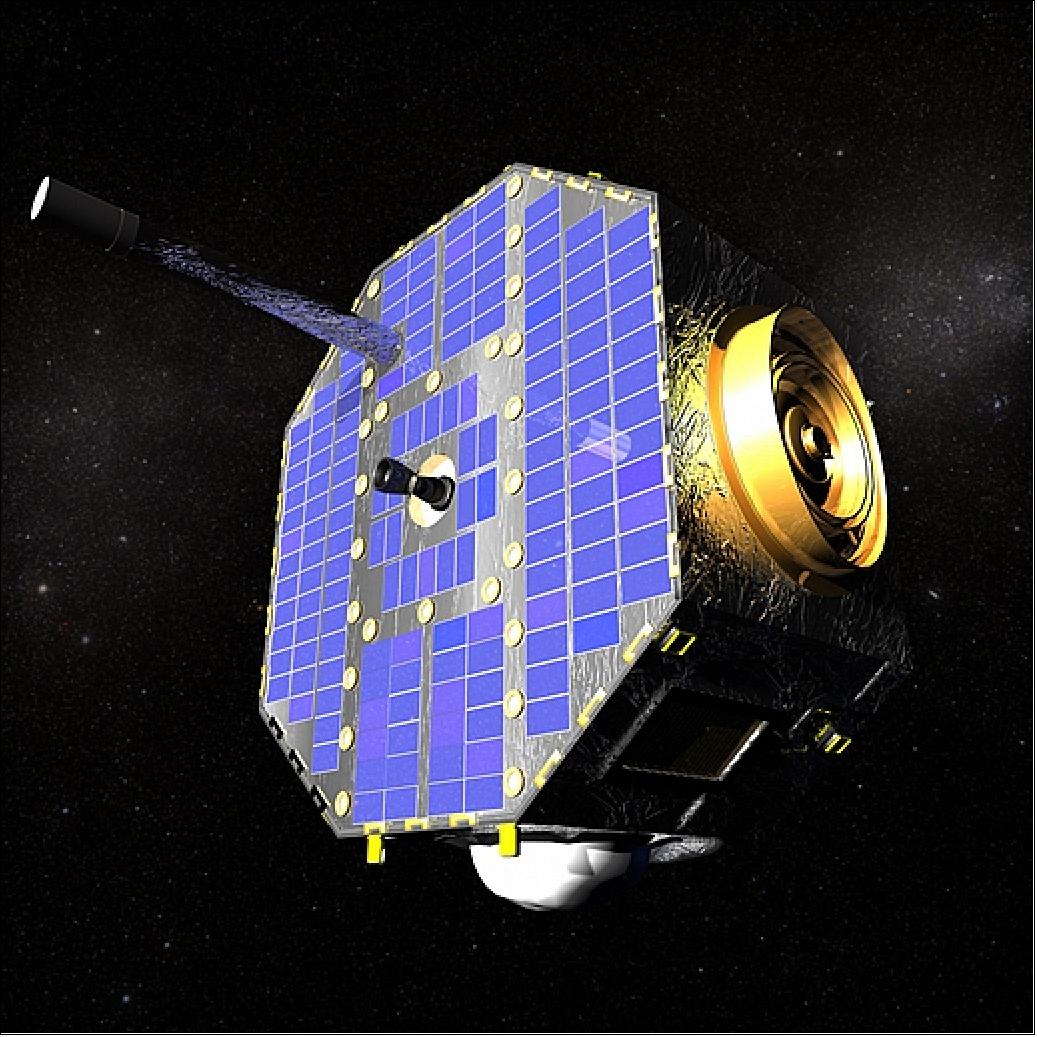
Spacecraft
The microsatellite is based on the MicroStar octagonal platform of OSC (Orbital Sciences Corporation), Dulles, VA (contract award in January 2005). The bus is spin-stabilized at nominally 4 rpm with the major axis pointing toward the sun. 3) 4) 5)
The spacecraft bus consists of a central “thrust-tube” core structure, the components are mounted on 6 side panels. The solar array is surface-mounted on the top deck.
The IBEX mission illustrates multiple key points about the potential for Micro-GEO spacecraft:
• First, it demonstrates that a microsatellite can perform groundbreaking science investigations. It is making key measurements of a region only now being visited by the Voyager spacecraft.
• Second, IBEX demonstrates that large propulsive maneuvers can be performed on small satellites. The IBEX HEO orbit raising maneuver requires approximately a ΔV of 3,000 m/s, about double the value needed to raise a spacecraft from GTO to GEO.
• Finally, IBEX shows that Micro-GEO spacecraft may come in many different configurations.
For IBEX, the MicroStar avionics were put into a new thrust-tube structure, but the avionics architecture remained largely unchanged. The SCB (Spacecraft Bus) features a distributed Motorola 68302 microprocessor-based architecture, with the C&DH (Command and Data Handling) subsystem, ACS (Attitude Control Subsystem), and EPS (Electrical Power Subsystem) each featuring a dedicated processor. An expanded view of the spacecraft showing component location is given in Figure 2.
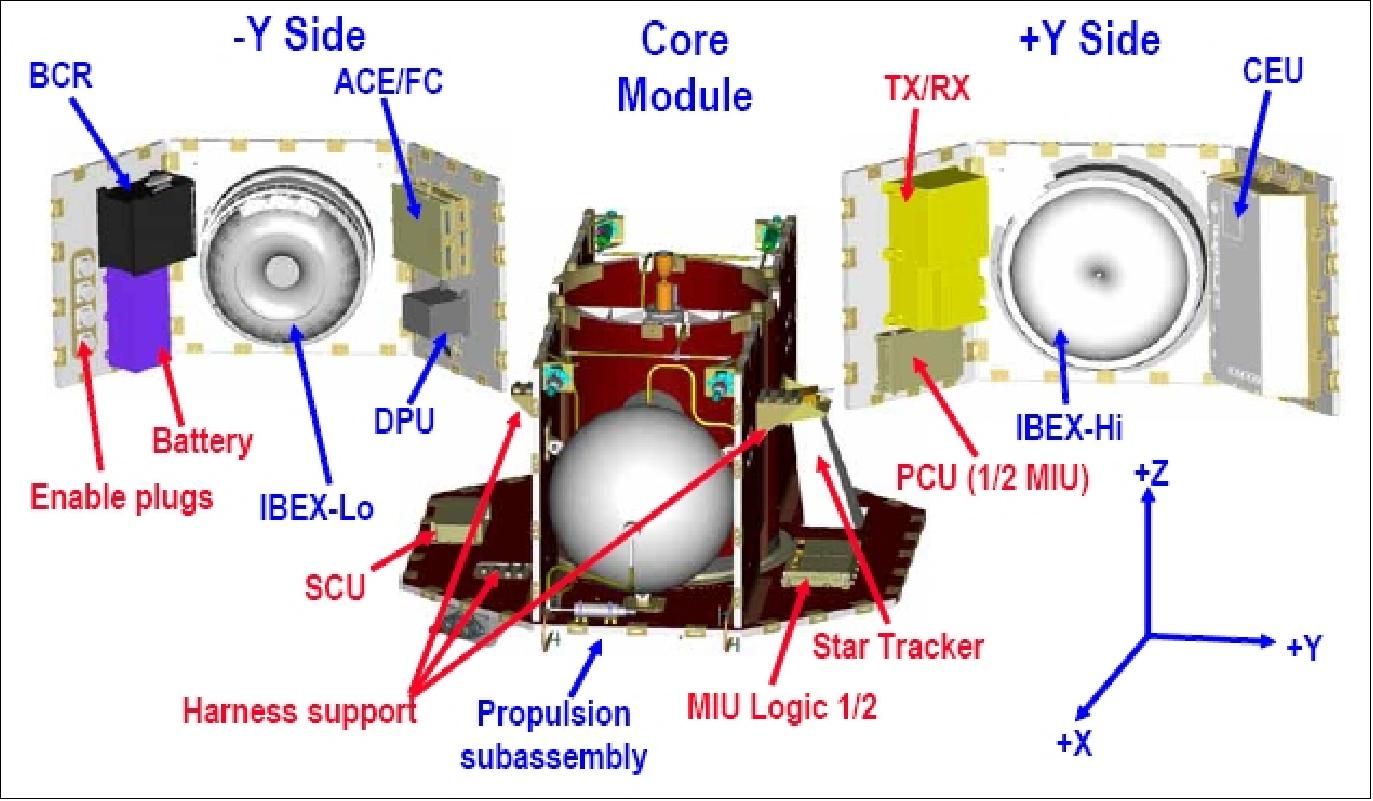
Structure
The IBEX spacecraft structure is an irregular octagon approximately 0.93 m across and 50 cm tall composed of a core module, two payload equipment panels, four bus equipment panels, two close out panels, and the solar array panel. The six equipment panels were constructed from 3 mm thick aluminum 6061-T6 skins, 5056 aluminum honeycomb core and FM73U film adhesive. The remainder of the structure was constructed from 3-ply graphite-reinforced cyanate ester prepreg M55J/RS-3C skins, 5056 aluminum honeycomb core, and FM73U film adhesive, except the solar array deck, which used RS-4A film adhesive for the higher service temperature. The inner facesheets and honeycomb core of all panels were perforated for venting. The core module consists of the thrust tube, base panel and four core panels bonded together with pre-cured graphite clips. The other structural panels and solar array deck were assembled to each other and to the core module with bonded aluminum clips and threaded fasteners. The clips were match bonded with EA9309NA epoxy for a shear interface. Inserts to attach components were potted into the panels using EA9396.6MD syntactic foam. Thermal isolators between the solar array and core structure (5 mm thick G-10 washers) isolate the core structure from the Sun-pointing solar array panel. The primary structure was fabricated by Alliance Space Systems LLC in Signal Hill, CA.
The FC (Flight Computer) is the spacecraft controller; the ACE (Attitude Control Electronics) interfaces to the ACS components and hosts the ACS software. The BCR (Battery Charge Regulator) provides power for all spacecraft loads and performs ancillary functions including heater control, SRM (Solid Rocket Motor) fire, and separation system actuation. The MIU (Mission Interface Unit) is the interface between the SCB (Spacecraft Bus) and the CEU (Combined Electronics Unit) in the payload. The CEU provides power and data connections to the IBEX-Hi and IBEX-Lo sensors and stores all mission data, including SCB housekeeping telemetry. The MIU also provides the interface to the S-band transceiver to receive uplinked commands and downlink telemetry and science data. On-board propulsion for perigee and apogee raising, spin down, and orbital maneuvers is provided by the HPS. The following sections describe the subsystems of the SCB.
ACS (Attitude Control Subsystem)
The ACS maintains stability and control throughout all mission phases, beginning with separation from Pegasus. The ACS uses one processor contained in the ACE, which drives core ACS algorithms and interfaces to the ACS sensors and actuators.
Attitude determination is provided by the sensors listed in Table 1. The two Honeywell QA2000-030 accelerometers are mounted on different axes such that one measures spin rate and the other measures nutation. The spin rate accelerometer saturates at around 27.5 rpm. Coarse Sun sensor data can be used to approximate a value, but at high spin rates only the accelerometer reading is available for onboard spin rate determination. The rate gyro, a BEI Systron Donner QRS100, offers a backup nutation measurement, which is needed for the ΔV maneuvers (SRM burn and hydrazine orbit raising), during which the nutation accelerometer is saturated.
The star tracker, the ASC (Advanced Stellar Compass) of DTU Space (Technical University of Denmark), is only used at a low (<4.5 rpm) spin rate and is the high accuracy sensor used during the nominal science mission. When on, the star tracker also measures spin rate and nutation (more accurately than the accelerometer or rate gyro). The coarse sun sensors are used as a backup to the star tracker, providing a reference to perform maneuvers to point the solar array at the sun.
Sensor | Function | Operational range |
Coarse sun sensor | Measure the sun vector | ±70º half cone |
Star tracker | Measure spacecraft attitude by referencing local stars in the star tracker field of view | Any attitude, spin rate up to 4.5 rpm |
Spin rate accelerometer | Measure acceleration in the spin axis to determine spacecraft spin rate | 0 to 27.5 rpm (2.88 rad/s) |
Nutation accelerometer | Measure acceleration in the transverse axes to determine vehicle nutation | ±0.08 rad/s |
Rate gyro | Measure angular rate to determine nutation | ±50º/s in X–Y |
Pressure sensors | Measure propulsion tank pressure | 0 to 2909 x 103 Pa (or 422 psi) |
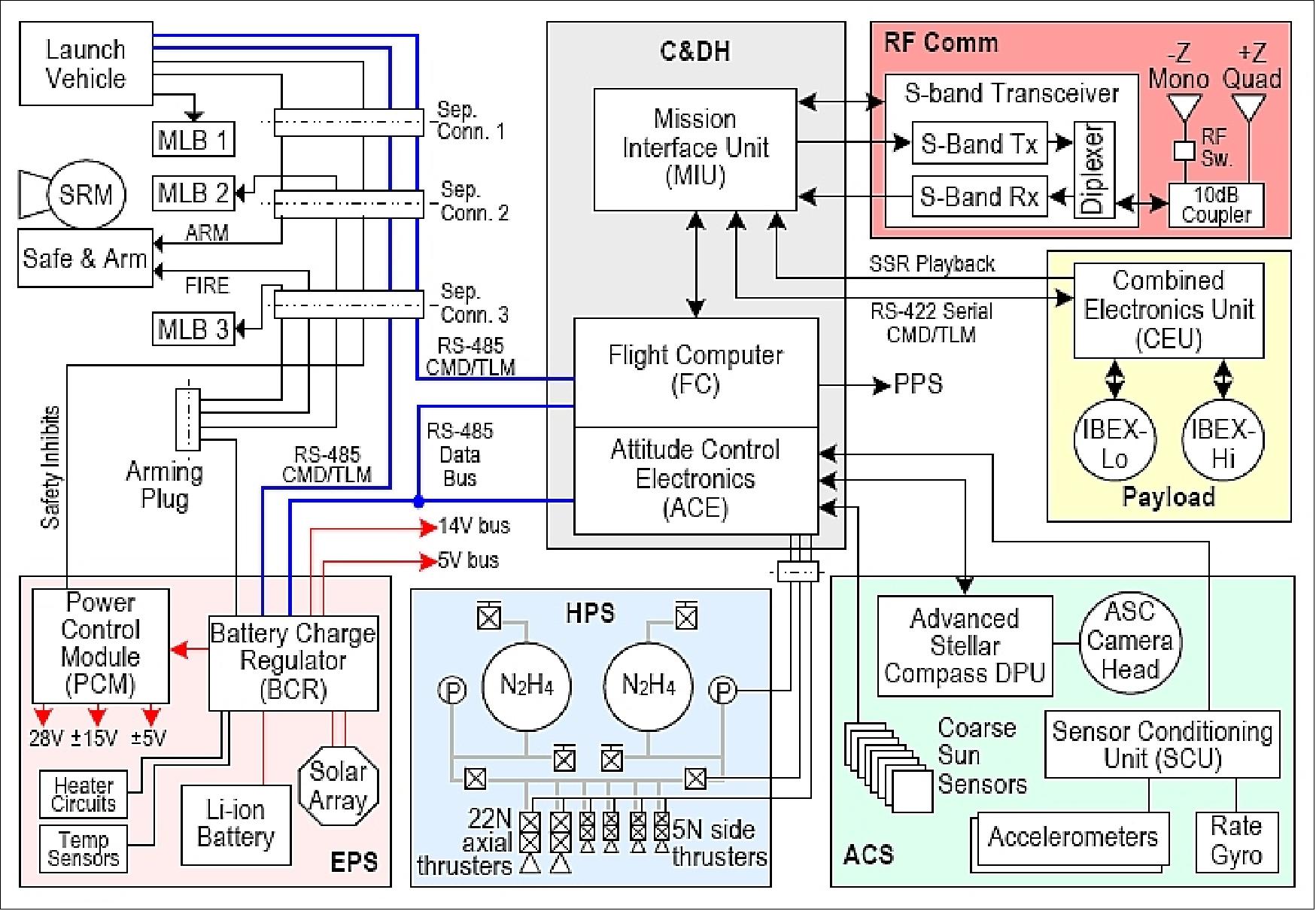
Spacecraft bus | MicroStar platform built on an octagonal base, roughly 58 cm high and 95 cm across |
Spacecraft mass (IBEX) | Launch mass = 107 kg; dry mass of 80 kg of which the instrument payload comprises 26 kg |
Spacecraft mass | Entire flight system launch mass, including the ATK Star 27 solid rocket motor = 462 kg |
Power | - 116 W (max), the nominal power is 66 W (16 W for payload) |
ACS (Attitude Control Subsystem) | - Attitude sensing is provided by the star tracker ASC (Advanced Stellar Compass), coarse sun sensors, and a rate gyro |
Mission life | 2 years (baseline mission) |
C&DH (Command & Data Handling) Subsystem
The C&DH subsystem provides command decoding and distribution, performs data collection and storage, performs health and maintenance functions, and provides the electrical interface to the payload through the CEU. The C&DH subsystem consists of the FC, the ACE, and the MIU. A block diagram of the C&DH Subsystem is shown in Figure 4.
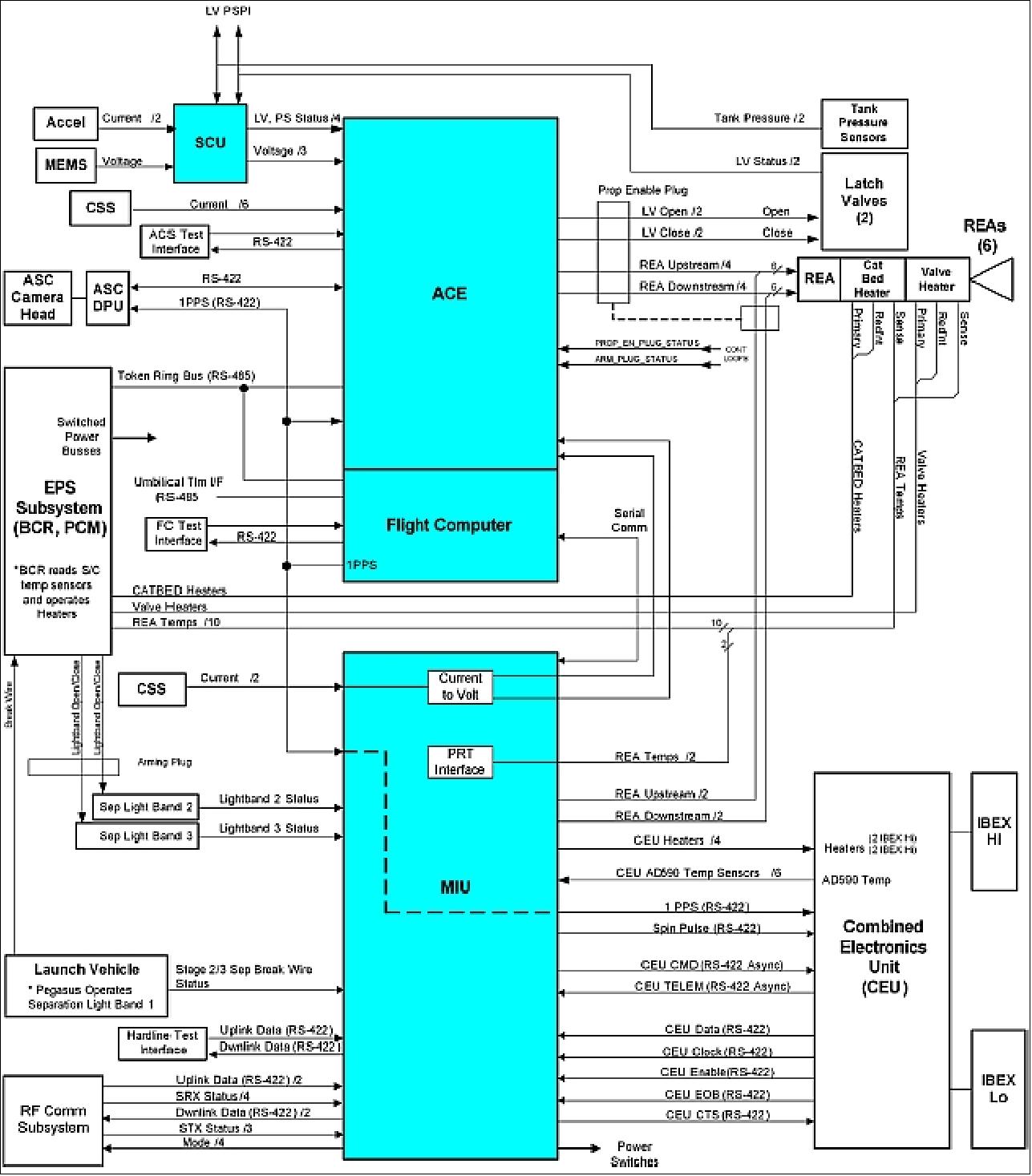
The FC and ACE serve as the core of the subsystems, with internal architectures based on the radiation-tolerant version of the Motorola 68302 multi-protocol communications processor. The FC communicates with the BCR and ACE via a multi-drop RS-485 bus and with the MIU via a dedicated RS-422 interface; the MIU communicates with the payload CEU via another dedicated RS-422 interface. The FC also includes eight discrete I/O ports for resetting systems, power switching, and other functions. A 256 kB boot ROM stores code for processor startup and boot load functions, and a 256 kB EEPROM holds the application code at startup.
The FC executes real-time commands, as well as time-based stored commands. Its 3 MB EDAC-protected RAM stores spacecraft state-of-health telemetry received from the BCR, ACE, MIU, and CEU. All stored telemetry is also sent to the CEU to be stored in its much larger SSR (Solid-State Recorder ) until the downlink ground pass. Several orbits of telemetry can thus be stored in the CEU, while the FC maintains telemetry from only the most recent day or so.
The MIU is the interface between the FC, payload CEU, and RF communications subsystem. The MIU receives payload commands and spacecraft telemetry from the FC and forwards those to the CEU, which de-commutates the message to determine if it is a command to be executed or telemetry to be stored in the SSR. The MIU also collects discrete telemetry from, and controls the interfaces to, the CEU and S-band transceiver. During a data downlink, the MIU performs CCSDS data encoding prior to sending the data to the transmitter and controls the downlink data rate based on commands from the FC.
The MIU provides the spacecraft-to-ground interface for commanding, telemetry, and science data. The MIU interfaces with the RF communications subsystem, the FC, the CEU, and the ACE. For the RF communications interface, the MIU receives and decodes data from the S-band receiver and forwards that data to the FC. It also performs CCSDS encoding on telemetry data from both the FC and CEU and sends that data to the transmitter for downlink.
The MIU is the sole electrical interface between the SCB and the payload. All payload commands are forwarded by the MIU from the FC to the CEU. The MIU also sends pulse-per-second and spin pulse signals to the CEU as commanded by the FC and ACE. In addition, the MIU provides switched +28 V power and six switched heater interfaces to the CEU. - The MIU also provides the interface to several other components, including the SRM safe and arm, separation breakwires for safety inhibits, two coarse Sun sensors, the accelerometers, eight temperature sensors, and both ΔV thrusters.
EPS (Electrical Power Subsystem)
The EPS provides and controls the electrical power that operates the IBEX spacecraft. Its functions include power generation and storage, load management, voltage conversion and regulation, heater control, safety inhibits, and launch/deployment sequence control. A block diagram of the EPS is shown in Figure 5.
The EPS is comprised of the BCR (Battery Charge Regulator), PCM (Power Converter Module), lithium-ion battery, and solar array panel. These components operate collectively to supply optimal power to the spacecraft.
The BCR is the hardware core of the EPS, converting solar array power into unregulated (+14 V) and regulated (+5 V) power and distributing that power to the SCB; the power outputs are switchable. The EPS software architecture integrates the functionality of the major BCR components: microcontroller, telemetry card, accessory card, central regulator, and charge regulator. Through these components, the BCR controls the MPPT (Maximum Power Point Tracking), battery charging, battery protection, load switching, load management, the +5 V regulated bus, and the 14 V unregulated bus. The BCR also collects voltage, current, and temperature data from several spacecraft sensors and controls battery charging/discharging based on battery cell voltage monitoring.
Additional BCR functions include controlling load shedding and heaters and managing separation and deployment sequence. The EPS communicates with the FC and the ACE via the avionics bus, and the BCR is the token master. The central regulator provides regulated +5 Vdc power to the spacecraft components, excluding the BCR internal electronics. Power provided by the central regulator is mainly used by the digital electronics components in other subsystems. The solar array feeds into the charge regulator, which converts the 20–40 V solar array voltage to the unregulated 14 V bus. The charge regulator is responsible for managing power between the solar array and battery.
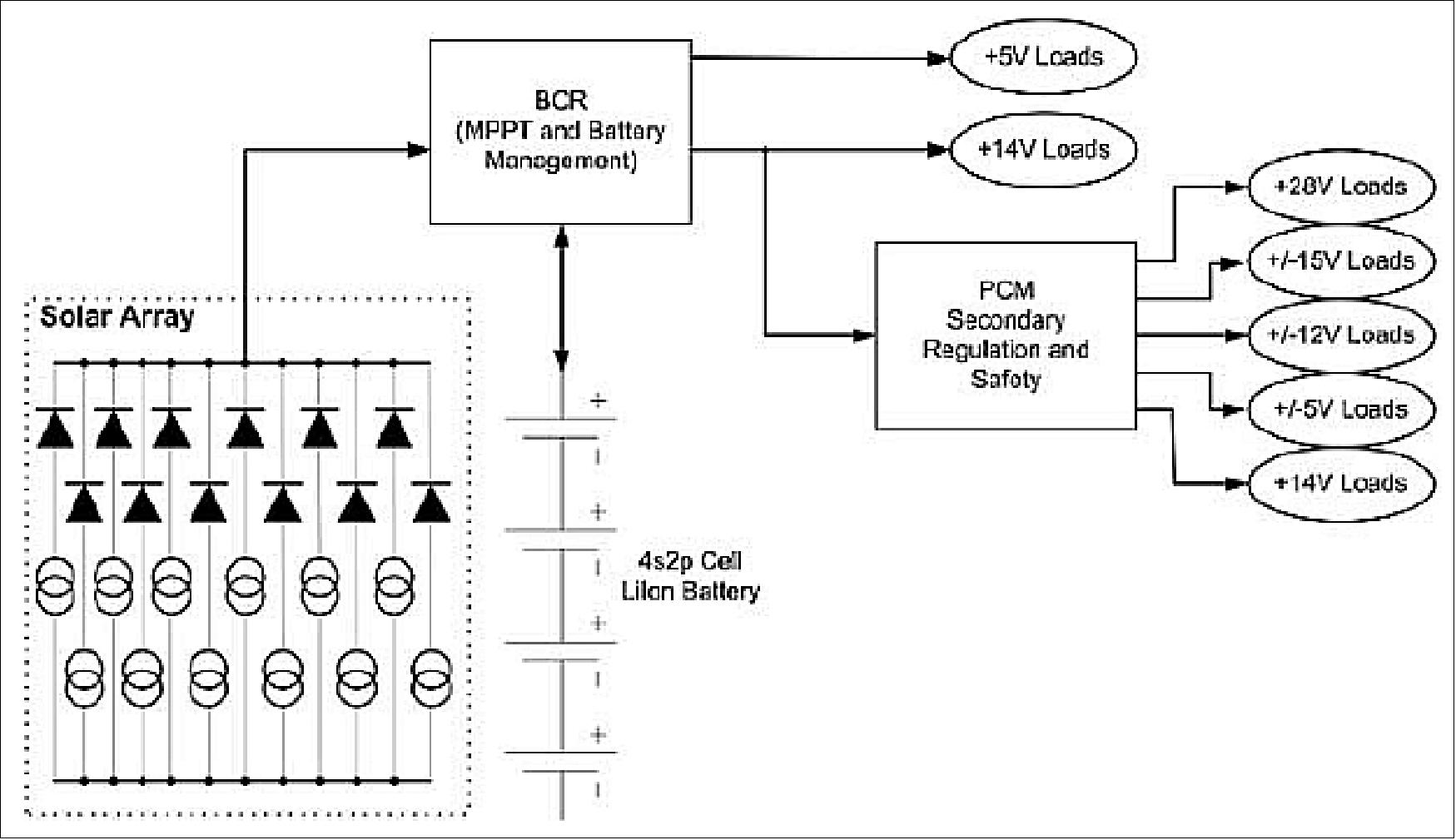
The PCM receives power from the BCR unregulated bus and uses it to generate secondary voltages, including +28 V, ±5 V, ±15 V, and ±12 V. In addition to secondary power conversion, the PCM is also responsible for the following: sequencing the startup of the ACE, accelerometers, gyro, and SCU; providing triple breakwire based inhibits for the S-band transmitter and all hydrazine thrusters; providing spare switching capability; and controlling the aft antenna RF switch.
Battery
IBEX uses a 300 Whr lithium-ion battery manufactured by Yardney (NCP8-2 cells) for energy storage. The battery features eight cells (4s2p) and balancing electronics. Battery management electronics are incorporated within the battery pack, with the MEQ (Monitor Equalizer Board) ensuring that charge is equalized between cells and counteracting the effects of cell internal leakage currents on internal cell balance. The battery operates over a range of 12 V to 16.4 V, with each cell going from 3 to 4.1 V. For ideal battery maintenance, the battery cells are generally kept at 3.9 V in full sunlight, except in cases of a long eclipse when the full 4.1 V charge is used. As a lithium-ion battery, battery state of charge is determined by battery voltage; temperature is not used.
Solar array: Power generation for the spacecraft comes from a single body-mounted solar array on the +Z deck of the spacecraft. The spacecraft is nominally a sun-pointed (within 8º) spinner, keeping the solar array illuminated. Between launch and the end of orbit raising, however, the spacecraft can remain power positive with the sun as much as 55 º off of the +Z-axis.
The solar array generates 114 W EOL at 110°C and 8° angle of incidence with 168 standard Emcore ATJ cells laid out in 12 strings of 14 cells each. The solar array is thermally isolated from the rest of the spacecraft and operates within a range of -160ºC to 145ºC, depending on the solar angle of incidence or if the vehicle is in sunlight or eclipse. ITO (Indium Tin Oxide) coating on the front surface of the solar cell coverglasses was used to minimize the solar array static charge build-up. The cells are laid out to reduce the number of strings affected at one time by shadowing from the +Z thruster or antenna mast when the sun is off at an angle from the +Z direction.
HPS (Hydrazine Propulsion Subsystem)
The HPS is a simple monopropellant (hydrazine) blowdown system. Propellant is contained within two outboard spherical tanks; the location and shape of the tanks were selected to minimize nutation effects due to propellant sloshing. Four radial thrusters (5 N nominal) are oriented to provide impulse in the ±X direction for active nutation control during the SRM burn. During normal spacecraft operation these thrusters perform spin-rate adjustment, spin-axis repointing, and general attitude control. Two axial thrusters (22 N nominal) are oriented to provide impulse in the ±Z direction for orbit-raising maneuvers. The HPS design includes service and service valves, filters, and pressure transducers.
A functional schematic of the HPS is shown in Figure 6. The thruster orientation on the spacecraft, with thruster plumes identifying the firing direction is shown in Figure 7. The thruster locations were deliberately chosen to prevent the sensor apertures from observing the plumes.
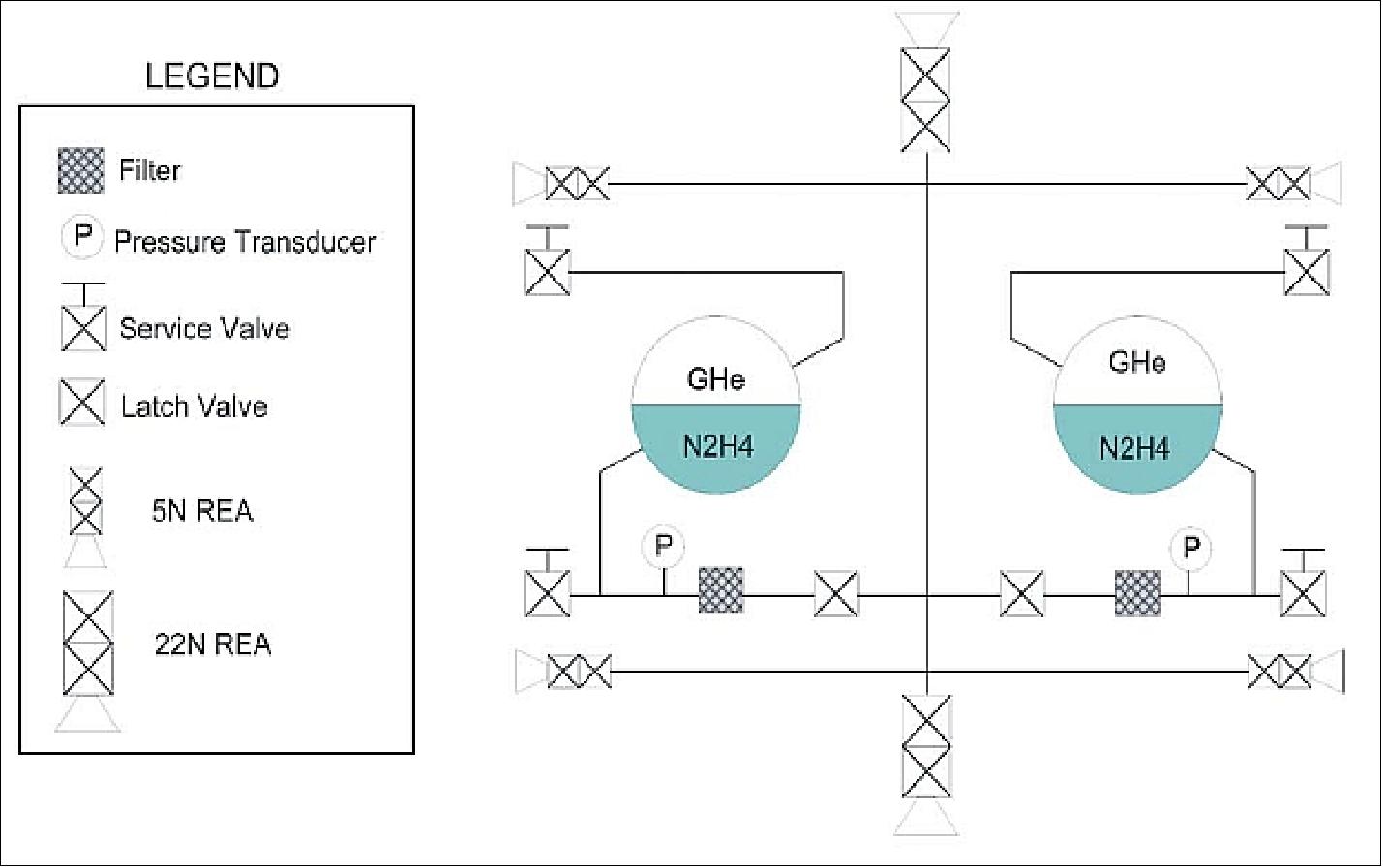
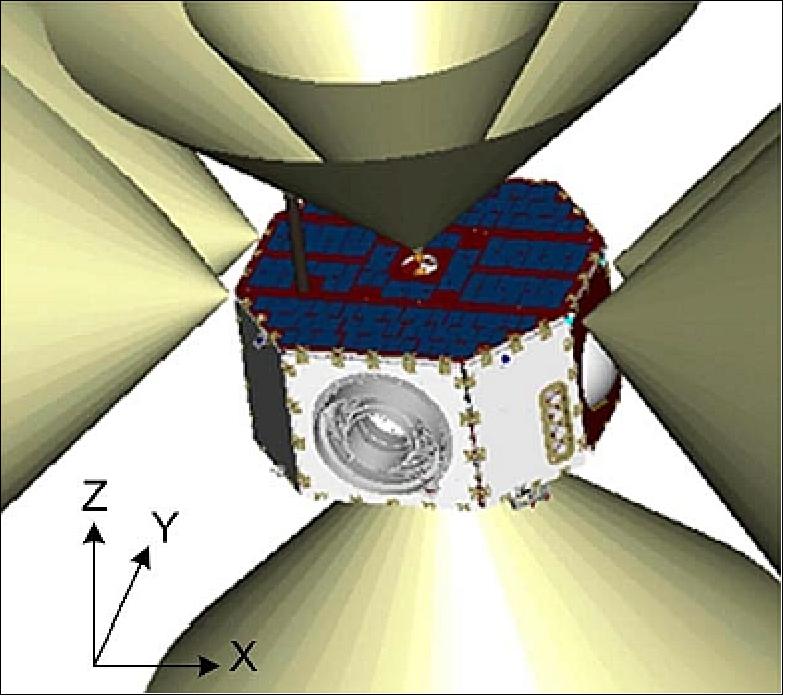
Figure 7: Illustration of the HPS thruster plumes (image credit: IBEX consortium)
RF Communications Subsystem
All data links are in S-band (use of CCSDS protocols) featuring a TAS (Thales Alenia Space) S-band transponder that provides not only ground communications but also orbit-determination capability in the form of coherent Doppler measurements. Table 3 gives the parameters for the uplink and downlink. Two hemispherical antennas are used with a nominal downlink data rate of 320 kbit/s (max) and an uplink rate of 2 kbit/s. Onboard data storage is provided in the CEU (Combined Electronics Unit).
Parameter | Downlink | Uplink |
Data rate (total symbols/s post-encoding) | 320, 160, 64, 40, or 2 ksample/s | 2 ksample/s |
Data rate accuracy | ≤1% | ≤ 1% |
Data transmission density | ≥1 per 50 bit | ≥1 per 50 bit |
Error control coding | CCSDS Reed-Solomon (255,223) code, 1/2 rate Viterbi (k = 7) | N/A |
Modulation format | NRZ-M | NRZ-M |
Modulation type | BPSK | PM/BPSK |
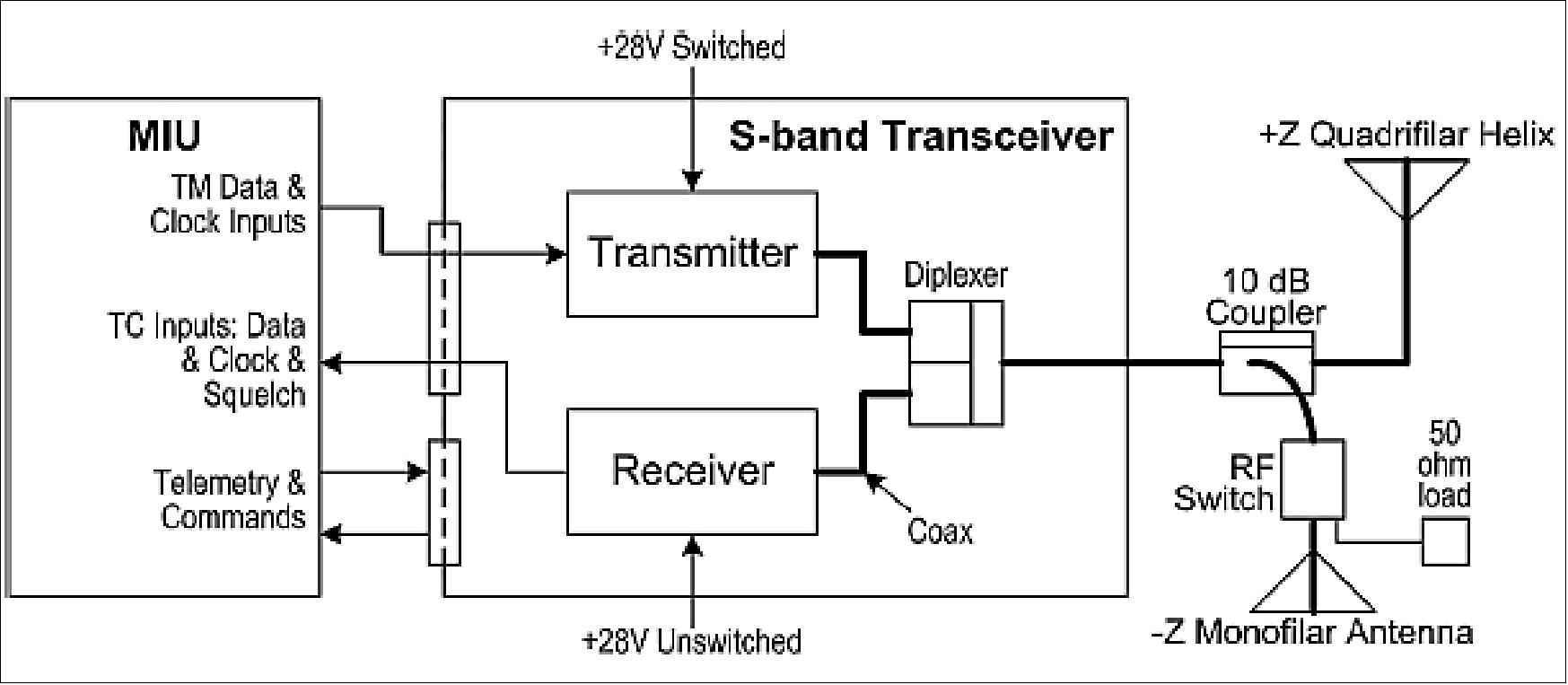
IBEX features an omni-directional antenna system that consists of two antennas, a quadrifilar in the +Z direction and a monofilar in the -Z direction, which are joined by a 10 dB coupler. The quadrifilar has a cardiod pattern to get full +Z and X–Y plane coverage, while the monofilar helix has a narrow spectral pattern to augment coverage in the -Z direction with minimal interference on the +Z quadrifilar helix. - The quadrifilar antenna is mounted on a boom to maximize the field of view, allowing coverage of the X–Y plane of the spacecraft, which is required for communications during orbit-raising burns performed at apogee. The combined antenna pattern is designed to provide >85% spherical coverage for 2 ksample/s uplink and downlink at 50 RE altitude (USN Hawaii ground station) as well as opportunities every orbit to downlink to any of the USN stations at 320 ksample/s for at least 30 minutes.
An RF switch in the path between the 10 dB coupler and monofilar antenna allowed the spacecraft to turn on its transmitter (with RF switch open, preventing transmission through the -Z monofilar antenna) while still attached to Pegasus. This made it possible to initiate the TDRSS link prior to spin-up and SRM burn without radiating into the Pegasus fairing, which is not allowed. The RF switch was closed (essentially turning on the monofilar antenna) by the BCR as a final step in the SRM burn and separation sequence.
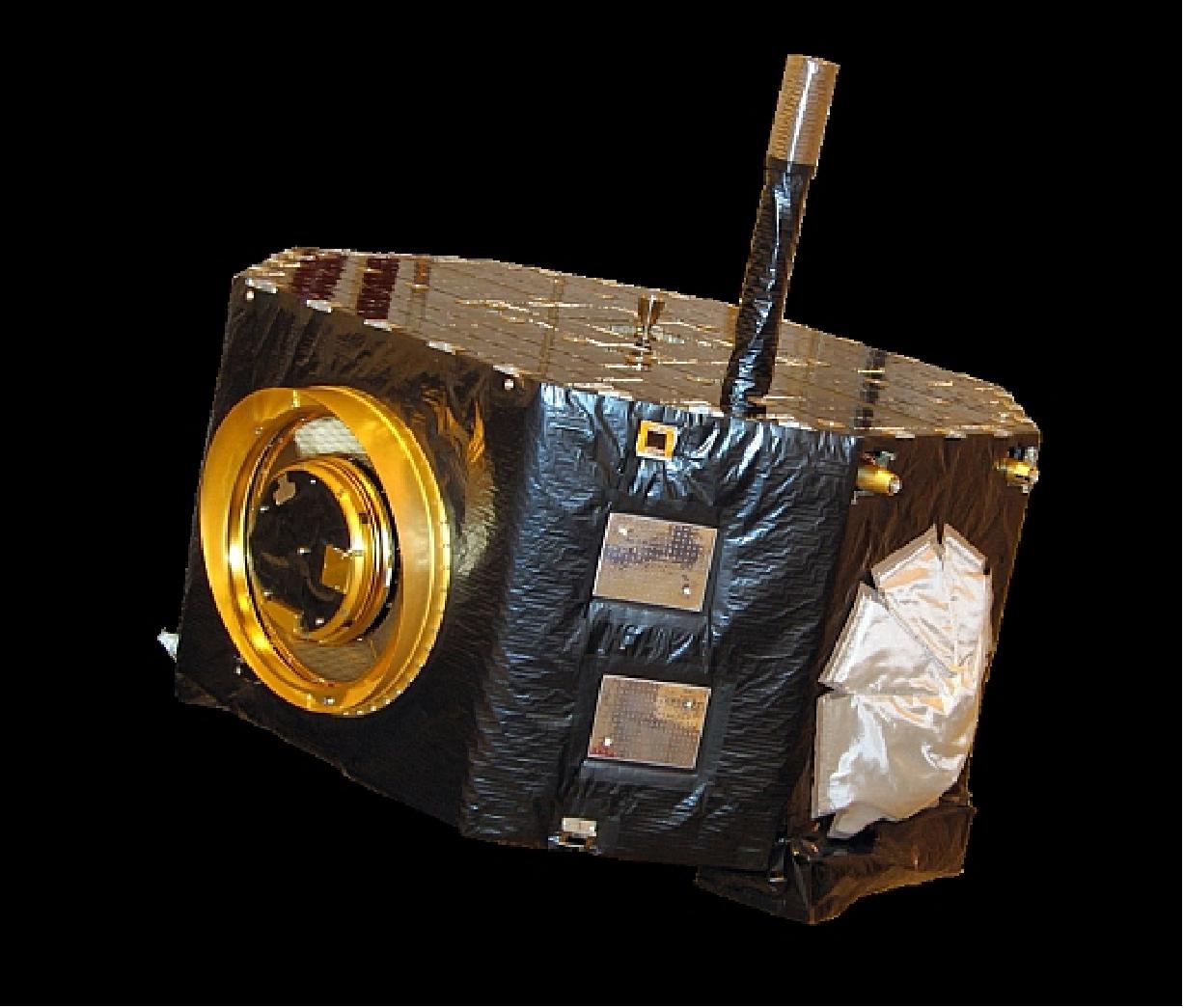
The spacecraft is coupled with an ATK Star 27 solid rocket motor (SRM), which boosts it from the injection orbit to its high altitude apogee. The spacecraft, SRM and the launch vehicle are connected by an adapter cone and 3 motorized light bands. The IBEX hydrazine propulsion system features a fully flight-qualified architecture with significant excess capacity.
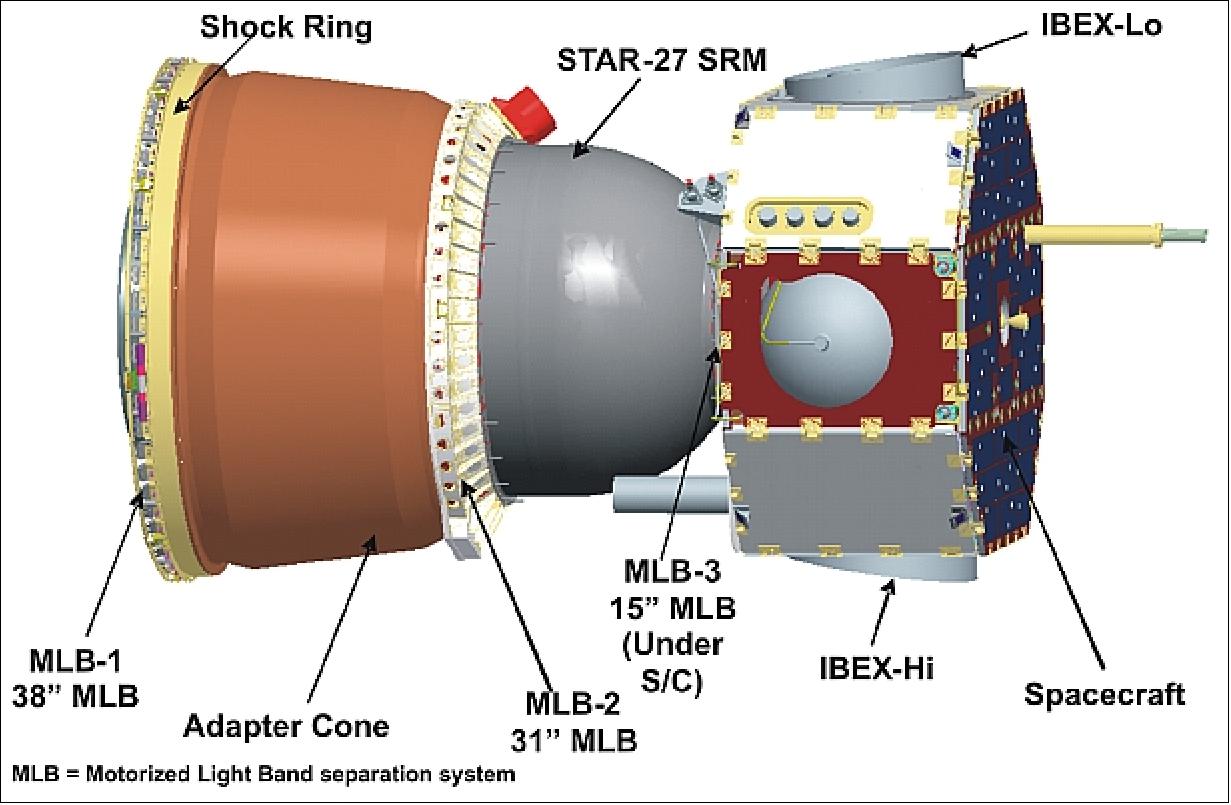
Resource | Requirement | Value | Margin/Value | Notes |
Flight system dry mass | 163.61 kg | 160.07 kg | (1) | Based on 461.60 kg LV capability, 271.38 kg SRM Propellant, and 26.3 kg hydrazine |
Power | 60 W | 140 W | 233% | Requirement is with transmitter off and no battery charging needed |
Energy margin, nominal mission | 13945.0 Whr | 15873.6 Whr | 13.8% | Based on S/A energy generation |
Pointing knowledge | 2.5º | 1.79º | 40% | By analysis |
Downlink margin | See note | See note | > 3 dB | Dependent on symbol rate & downlink altitude |
Uplink margin | See note | See note | > 3 dB | Dependent on uplink altitude |
Propellant delta-V | See note | See note | 10% | On top of delta-V margin |
Delta-V (mean) | 175.5 m/s | 514.0 m/s | 192.2% | Amount of delta-V available |
Delta-V (3σ) | 200.1 m/s | 514.0 m/s | 156.8% | Amount of delta-V available |
Data storage on SEU | 515.68 Mbit | 1073.74 Mbit | 108% | Based on 2 orbits of data |
Commands, nominal mission | 82 | 240 | 66% | Based on 2 orbits of commands |
Launch
The IBEX spacecraft was launched on a Pegasus-XL rocket of OSC on October 19, 2008. The Pegasus was released from a Lockheed L-1011 aircraft that took off from Kwajalein Atoll in the South Pacific. 6) 7)
Orbit
HEO (Highly Elliptical Orbit) with a perigee of 7,000 km and an apogee of 50 RE (amounting to 319,000 km, or more than 80% the distance to the moon). The inclination is 11º, the orbital period around Earth is 7.5 days.
After launch into a 200 km circular injection orbit, a STAR 27 solid rocket motor (SRM) was fired to raise the orbit. After several days of on-orbit checkout, an on-board hydrazine propulsion system is used to fine tune the orbit apogee to the desired 50 RE altitude and to raise perigee. The perigee raising maneuver lowers the radiation dose accumulated by the spacecraft over its two year design life.
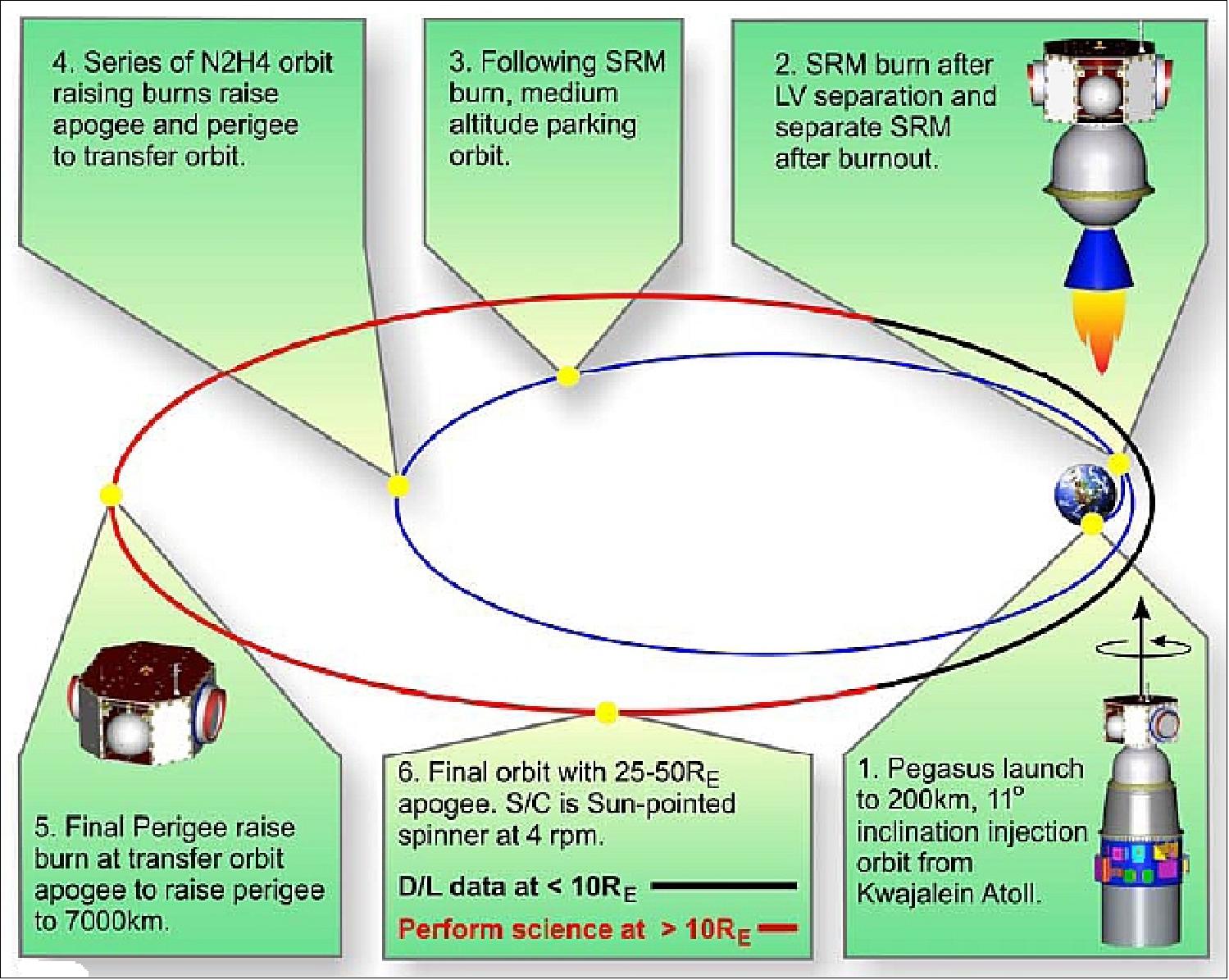
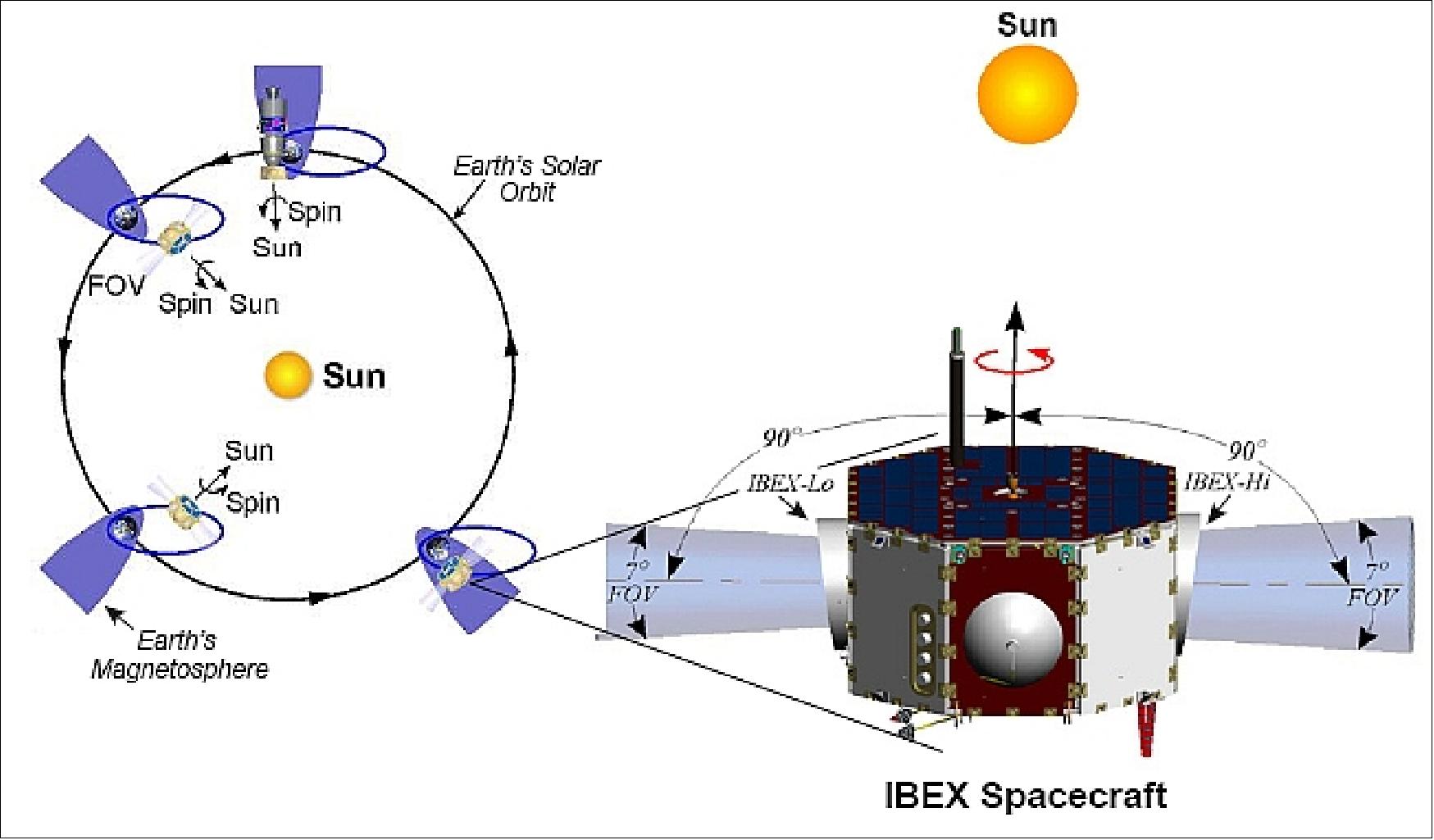
New Orbit Selection for IBEX
In June 2011, IBEX was shifted to a new more efficient orbit. It does not come as close to the Moon in the new orbit, and expends less fuel to maintain its position. 8)
Although the mission design was so far highly successful, there were several important shortcomings of the orbit. First, the orbit at perigee took the spacecraft through the outer radiation belt in each orbit, leading to the accumulation of dose that posed a risk to spacecraft electronic systems (e.g., raising the likelihood of SEUs (Single Event Upsets). In addition, the orbit was not synchronized with the Moon. With an apogee of nearly reaching the Moon’s orbit, there were periods where the spacecraft would pass relatively close to the Moon, and the lunar gravitational force would perturb the orbit. This orbit was very difficult to predict over several year periods. 9)
After extensive studies, the science team chose a 3:1 resonant orbit with a perigee above 7.3 RE. This also ensured that the perigee altitude would not evolve to be below the crowded geostationary belt, alleviating collision concerns. After studying the engine performance and developing procedures and a timeline to calibrate the engine, an initial orbit was chosen with a period of 9.03 days. This orbit is shown for ten years in Figure 13 in the Earth-Moon rotating coordinate frame. The figure shows how the apogees never get close to the Moon, which reduces the perturbations on the orbit.

Legend to Figure 13: In the rotating Earth-Moon coordinate system, the Earth is in the middle, the Moon’s orbit is the big outer circle, and the Moon is fixed at the top of the circle. The green plot in the background shows the old orbit pattern of IBEX where in some of the orbits the spacecraft passed relatively close to the Moon (straight up) – whenever this happened, the Moon’s gravity changed IBEX’s orbit, requiring the project to make additional maneuvers to keep the spacecraft from burning up in the Earth’s atmosphere or leaving Earth orbit entirely. - In the new orbit (in blue), the spacecraft makes three "petals" that are synchronized to always stay away from the Moon.
Orbit Change Maneuvers
The orbit change consisted of 5 maneuvers executed over the course of ~3 weeks as shown in Figure 14. Time progresses toward the right, and the locations of the maneuvers, as well as the increase in perigee altitude, are depicted (not to scale). Orbit 128 perigee kicked off the maintenance maneuver procedure. First, the spacecraft spin axis was re-pointed along the velocity vector of the o0129 (orbit 129) apogee (where the bulk of the delta-V was expended). Then the spacecraft was spun-up to a higher spin rate to remain spin-stabilized during the delta-V maneuvers.
- ADV1 was executed at the apogee of o0128. Orbit determination data was collected through perigee to calculate delta-V, calibrate the pressure based models, and plan the duration of the third delta-V burn.
- ADV2 was executed on the ascending side of o0129 apogee. Analysis of long term trajectory based on pressure models lead the team to increase the duration of ADV3 to 600 s.
- ADV3 was executed ~17 h after ADV2.
All three delta-V maneuvers performed nominally. Pressure data allowed us to quickly determine a TCM would not be needed. This quick diagnosis allowed the remaining steps of the maneuver procedure to be pushed up in the timeline. The spin-down to nominal spin rate and re-point to nominal pointing maneuvers occurred just after o0129 perigee. Science data collection resumed early in arc a of o0130 (i.e. o0130a) rather than the planned apogee of o0130 (collecting another full swath of the sky).

The orbit change maneuver and the associated changes to science operations that were necessary to support the change were, in the end, a great success. It was a process that required meticulous planning and patient follow-through, along with careful attention to detail.
Mission Status
• August 5, 2020: Scientists have developed a new prediction of the shape of the bubble surrounding our solar system using a model developed with data from NASA missions. 10)

- All the planets of our solar system are encased in a magnetic bubble, carved out in space by the Sun’s constantly outflowing material, the solar wind. Outside this bubble is the interstellar medium — the ionized gas and magnetic field that fills the space between stellar systems in our galaxy. One question scientists have tried to answer for years is on the shape of this bubble, which travels through space as our Sun orbits the center of our galaxy. Traditionally, scientists have thought of the heliosphere as a comet shape, with a rounded leading edge, called the nose, and a long tail trailing behind.
- Research published in Nature Astronomy in March and featured on the journal’s cover for July provides an alternative shape that lacks this long tail: the deflated croissant. 11)
- The shape of the heliosphere is difficult to measure from within. The closest edge of the heliosphere is more than ten billion miles from Earth. Only the two Voyager spacecraft have directly measured this region, leaving us with just two points of ground-truth data on the shape of the heliosphere.
- From near Earth, we study our boundary to interstellar space by capturing and observing particles flying toward Earth. This includes charged particles that come from distant parts of the galaxy, called galactic cosmic rays, along with those that were already in our solar system, travel out towards the heliopause, and are bounced back towards Earth through a complex series of electromagnetic processes. These are called energetic neutral atoms, and because they are created by interacting with the interstellar medium, they act as a useful proxy for mapping the edge of the heliosphere. This is how NASA’s IBEX (Interstellar Boundary Explorer) mission studies the heliosphere, making use of these particles as a kind of radar, tracing out our solar system’s boundary to interstellar space.
- To make sense of this complex data, scientists use computer models to turn this data into a prediction of the heliosphere’s characteristics. Merav Opher, lead author of the new research, heads a NASA- and NSF-funded DRIVE Science Center at Boston University focused on the challenge.
- This latest iteration of Opher’s model uses data from NASA planetary science missions to characterize the behavior of material in space that fills the bubble of the heliosphere and get another perspective on its borders. NASA’s Cassini mission carried an instrument, designed to study particles trapped in Saturn’s magnetic field, that also made observations of particles bouncing back towards the inner solar system. These measurements are similar to IBEX’s, but provide a distinct perspective on the heliosphere’s boundary.
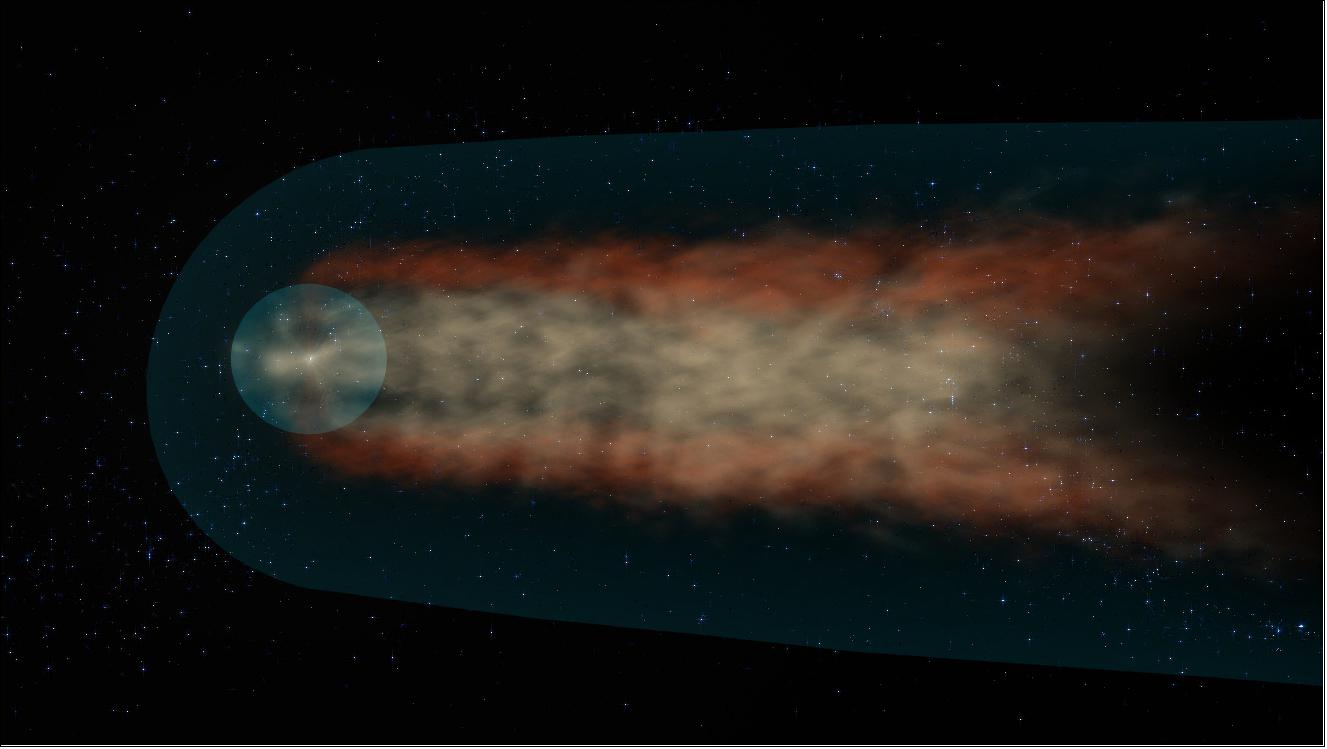
- Additionally, NASA’s New Horizons mission has provided measurements of pick-up ions, particles that are ionized out in space and are picked up and move along with the solar wind. Because of their distinct origins from the solar wind particles streaming out from the Sun, pick-up ions are much hotter than other solar wind particles — and it’s this fact that Opher’s work hinges on.
- “There are two fluids mixed together. You have one component that is very cold and one component that is much hotter, the pick-up ions,” said Opher, a professor of astronomy at Boston University. “If you have some cold fluid and hot fluid, and you put them in space, they won’t mix — they will evolve mostly separately. What we did was separate these two components of the solar wind and model the resulting 3D shape of the heliosphere.”
- Considering the solar wind’s components separately, combined with Opher’s earlier work using the solar magnetic field as a dominant force in shaping the heliosphere, created a deflated croissant shape, with two jets curling away from the central bulbous part of the heliosphere, and notably lacking the long tail predicted by many scientists.
- “Because the pick-up ions dominate the thermodynamics, everything is very spherical. But because they leave the system very quickly beyond the termination shock, the whole heliosphere deflates,” said Opher.
The shape of our Shield
- The shape of the heliosphere is more than a question of academic curiosity: The heliosphere acts our solar system’s shield against the rest of the galaxy.

- Energetic events in other star systems, like supernova, can accelerate particles to nearly the speed of light. These particles rocket out in all directions, including into our solar system. But the heliosphere acts as a shield: It absorbs about three-quarters of these tremendously energetic particles, called galactic cosmic rays, that would make their way into our solar system.
- Those that do make it through can wreak havoc. We’re protected on Earth by our planet’s magnetic field and atmosphere, but technology and astronauts in space or on other worlds are exposed. Both electronics and human cells can be damaged by the effects of galactic cosmic rays — and because galactic cosmic rays carry so much energy, they’re difficult to block in a way that’s practical for space travel. The heliosphere is spacefarers’ main defense against galactic cosmic rays, so understanding its shape and how that influences the rate of galactic cosmic rays pelting our solar system is a key consideration for planning robotic and human space exploration.
- The heliosphere’s shape is also part of the puzzle for seeking out life on other worlds. The damaging radiation from galactic cosmic rays can render a world uninhabitable, a fate avoided in our solar system because of our strong celestial shield. As we learn more about how our heliosphere protects our solar system — and how that protection may have changed throughout the solar system’s history — we can look for other star systems that might have similar protection. And part of that is the shape: Are our heliospheric lookalikes long-tailed comet shapes, deflated croissants, or something else entirely?

- Whatever the heliosphere’s true shape, an upcoming NASA mission will be a boon for unraveling these questions: the IMAP (Interstellar Mapping and Acceleration Probe) mission.
- IMAP, slated for launch in 2024, will map the particles streaming back to Earth from the boundaries of the heliosphere. IMAP will build on the techniques and discoveries of the IBEX mission to shed new light on the nature of the heliosphere, interstellar space, and how galactic cosmic rays make their way into our solar system.
- Opher’s DRIVE Science Center aims to create a testable model of the heliosphere in time for IMAP’s launch. Their predictions of the shape and other characteristics of the heliosphere — and how that would be reflected in the particles streaming back from the boundary — would provide a baseline for scientists to compare with IMAP’s data.
• June 11, 2020: Far, far beyond the orbits of the planets lie the hazy contours of the magnetic bubble in space that we call home. This is the heliosphere, the vast bubble that is generated by the Sun’s magnetic field and envelops all the planets. The borders of this cosmic bubble are not fixed. In response to the Sun’s gasps and sighs, they shrink and stretch over the years. 12)
- Now, for the first time, scientists have used an entire solar cycle of data from NASA’s IBEX spacecraft to study how the heliosphere changes over time. Solar cycles last roughly 11 years, as the Sun swings from seasons of high to low activity, and back to high again. With IBEX’s long record, scientists were eager to examine how the Sun’s mood swings play out at the edge of the heliosphere. The results show the shifting outer heliosphere in great detail, deftly sketch the heliosphere’s shape (a matter of debate in recent years), and hint at processes behind one of its most puzzling features. These findings, along with a newly fine-tuned data set, are published in The Astrophysical Journal Supplements on June 10, 2020. 13)
- IBEX (Interstellar Boundary Explorer) has been observing the boundary to interstellar space for more than 11 years, showing us where our cosmic neighborhood fits in with the rest of the galaxy.
- “It’s this very small mission,” said David McComas, the principal investigator for the mission at Princeton University in New Jersey. IBEX is just as big as a bus tire. “It’s been hugely successful, lasting much longer than anybody anticipated. We’re lucky now to have a whole solar cycle of observations.”
Mapping the Solar System’s Edge, one Particle at a Time
- The heliosphere is filled with the solar wind, the constant flow of charged particles from the Sun. The solar wind rushes out in all directions, a million miles per hour, until it butts against the interstellar medium, winds from other stars that fill the space between them.
- As the Sun wades through the interstellar medium, it generates a hot, dense wave much like the wave at the front of a boat coursing through the sea. Our cosmic neighborhood is called the Local Fluff, for the cloud of superhot gases that blooms around us. Where the solar wind and Local Fluff meet forms the edge of the heliosphere, called the heliopause. Just inside that lies a turbulent region called the heliosheath.
- Particles called energetic neutral atoms, or ENAs, that are formed in this distant region of space are the focus of IBEX’s surveys. They’re created when hot, charged particles like the ones in the solar wind collide with cold neutrals like those flowing in from interstellar space. Zippy solar wind particles can snatch electrons from lumbering interstellar atoms, becoming neutral themselves.
- The journey of these particles begins long before IBEX detects them. Past the planets, past the asteroid belt and the Kuiper Belt, to the edge of the heliosphere, it takes about a year for a gust of solar wind to race 100 times the distance between the Sun and Earth. Along the way, the solar wind picks up ionized atoms of interstellar gases that have wriggled in to the heliosphere. The solar wind that arrives at the edge is not the same wind that left the Sun a year before.
- Solar wind particles might spend another six months roving the chaos of the heliosheath, the gulf between the heliosphere’s two outer boundaries. Inevitably, some collide with interstellar gases and become energetic neutrals. It takes the neutral particles close to another year for the return trip, traversing the space from the edge of the heliosphere to reach IBEX — if the particles happened to be heading in precisely the right direction. Of all the neutral particles formed, only a few actually make it to IBEX. The whole trip takes two to three years for the highest-energy particles in IBEX’s observing range, and even longer at lower energies or more distant regions.
- IBEX takes advantage of the fact that neutral atoms like these aren’t diverted by the Sun’s magnetic field: Fresh neutral particles bound away from collisions in nearly a straight line.
- IBEX surveys the skies for the particles, noting their direction and energy. The spacecraft only detects about one every other second. The result is a map of the interstellar boundary, crafted from the same principle a bat uses to echolocate its way through the night: monitor an incoming signal to learn more about one’s surroundings. By studying where the neutrals come from, and when, IBEX can trace the remote boundaries of our heliosphere.
- “We’re so lucky to observe this from inside the heliosphere,” said Justyna Sokol, a visiting scientist on the Princeton team. “These are processes that happen at very small distances. When you observe other stars that are very far away, you observe distances of light years, from outside their astrospheres.” Even the distance between the Sun and the nose of the heliosphere is tiny compared to many, many light years.
- Using IBEX’s 11-plus years of data, McComas and his team were able to study changes that evolve over time and are key to understanding our place in space.
- The solar wind is constant, but the wind is not steady. When the wind gusts, the heliosphere inflates like a balloon, and neutral particles surge at the outer fringes. When the wind calms, the balloon contracts; neutral particles dwindle. The ensuing seesaw of neutral particles, the scientists reported, consistently echoed two to three years after the changes in the wind — reflecting their journey to the edge of this balloon and back.
- “It takes so many years for these effects to reach the edge of the heliosphere,” said Jamey Szalay, another Princeton researcher on the team. “For us to have this much data from IBEX, finally allows us to make these long-term correlations."
Shaping up the Heliosphere
- From 2009 to 2014, the wind blew fairly low and steady, a gentle breeze. The heliosphere contracted. Then came a surprise swell in the solar wind, as if the Sun heaved a great sigh. In late 2014, NASA spacecraft orbiting Earth detected the solar wind pressure increase by about 50% (it has since remained high for several years).
- Two years later, the billowing solar wind led to a flurry of neutral particles in the heliosheath. Another two years later, they filled most of the nose of the heliosphere. Eventually, they crested over the heliosphere’s north and south poles.
- These changes were not symmetric. Each observed bump traced the quirks of the heliosphere’s shape. The scientists were surprised at how clearly they saw the tidal wave of solar wind pushing out the heliopause.
- “Time and the neutral particles have really painted the distances in the shape of the heliosphere for us,” McComas said.
- IBEX still hasn’t observed the effects of this cosmic punch from the back end of the heliosphere, the heliotail. That means the tail end is much farther away from the Sun than the front; those particles are on a much longer journey. Maybe the solar wind surge is still hurtling toward the tail, or maybe neutral particles are already on their way back. In the coming years, the IBEX team will be watching for signs of their return from the tail.
- “Nature set up this perfect experiment for us to better understand this boundary,” Szalay said. “We got to see what happens when this one big thing — the solar wind push — changes.”
- Overall, this paints a picture of the heliosphere that is shaped something like a comet. The shape of the heliosphere has been a matter of debate in recent years. Some have argued our bubble in space is spherical as a globe; others suggested it is closer to a croissant. But in this study, McComas said, IBEX data clearly shows the heliosphere’s response to the solar wind push was asymmetric — so the heliosphere itself must be asymmetric too. The Sun is situated close to the front, and as the Sun hurtles through space, the heliotail trails much farther behind, something like the streaking tail of a comet.
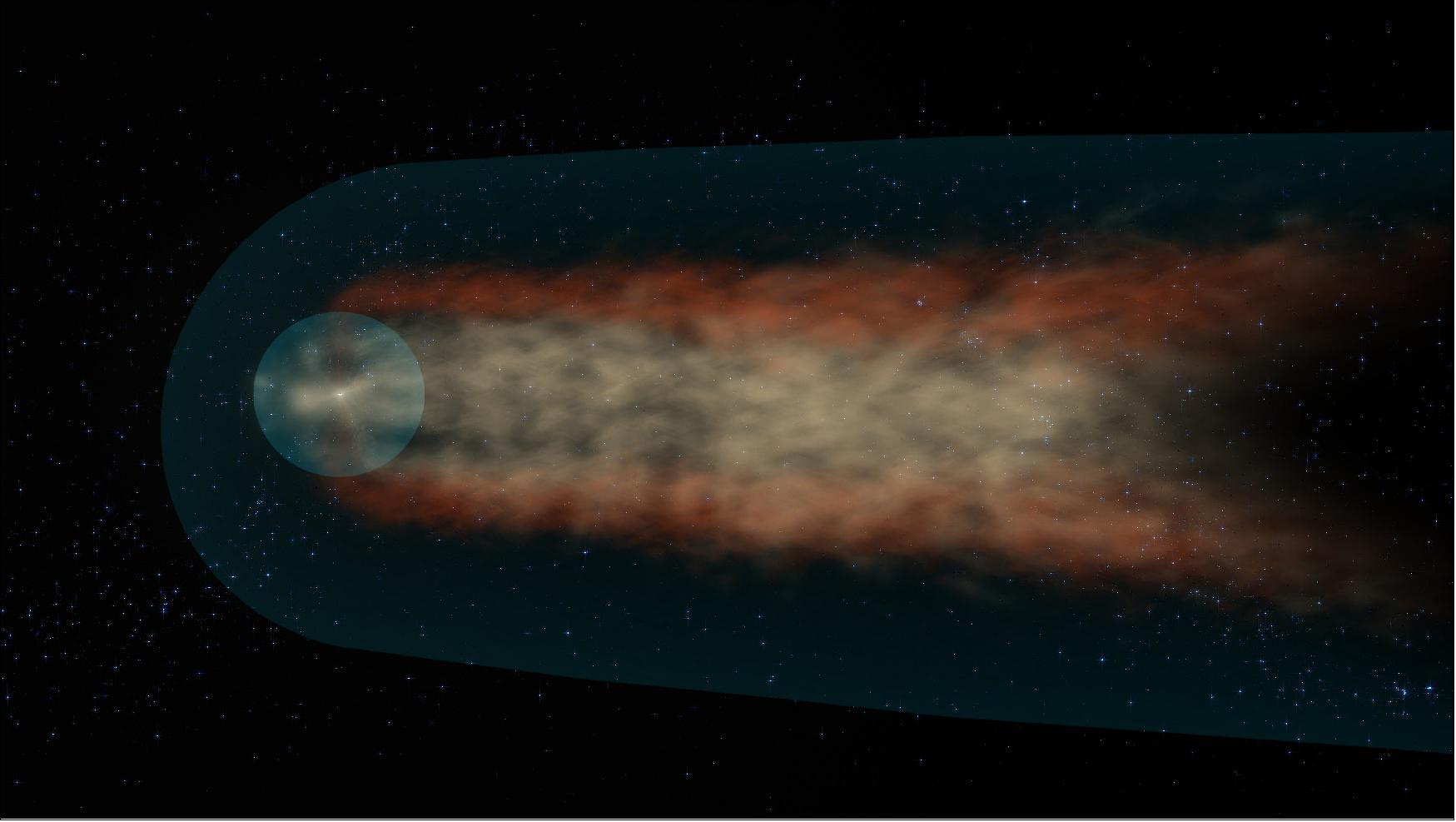
Tackling IBEX’s Biggest Puzzle
- IBEX’s many years of data have also brought scientists closer to an explanation for one of the heliosphere’s more puzzling features, known as the IBEX ribbon. The ribbon remains one of IBEX’s biggest discoveries. Announced in 2009, it refers to a vast, diagonal swath of energetic neutrals, painted across the front of the heliosphere. It’s long puzzled scientists: Why should any part of the boundary should be so different from the rest?
- Over time, IBEX has indicated that what forms the ribbon is very different than what forms the rest of the interstellar sky. It is shaped by the direction of the interstellar magnetic field. But how are ribbon particles produced? Now, the scientists report that it’s very likely a secondary process is responsible, causing the journey of a certain group of energetic neutral particles to roughly double.
- After becoming energetic neutrals, rather than ricochet back toward IBEX, this group of particles would streak in the opposite direction, across the heliopause and into interstellar space. There, they’d get a taste of the Local Fluff, cruising until some would inevitably collide with passing charged particles, losing an electron once again and becoming tied to the surrounding magnetic field.
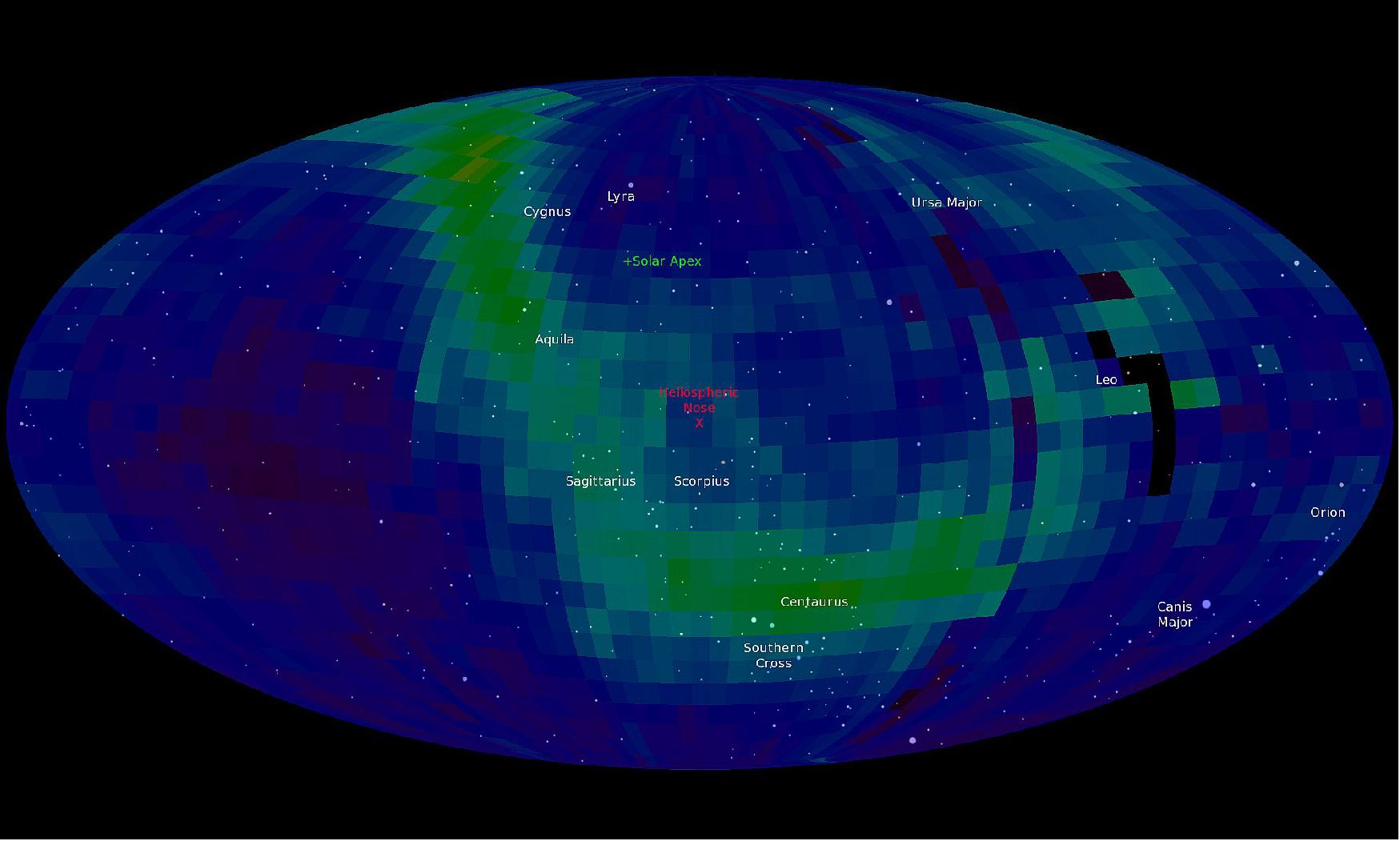
- Another two years or so pass, and the charged particles might collide yet again with slower peers, stealing electrons like they’ve done before. After this brief migration beyond the heliosphere, the twice-born energetic neutrals might eventually re-enter, hurtling back toward home.
- Extended IBEX data helped the scientists connect the ribbon to the particles’ long interstellar tour. Particles forming the ribbon have journeyed some two years more than the rest of the neutral particles observed. When it came to the solar wind spike, the ribbon took another two years after the rest of the heliosphere to even start responding.
- Far exceeding its initial mission of two years, IBEX will soon be joined by another NASA mission, IMAP (Interstellar Mapping and Acceleration Probe), for which McComas also serves as principal investigator. The mission is scheduled to launch in late 2024.
- “IMAP presents a perfect opportunity to study, with great resolution and sensitivity, what IBEX has begun to show us, so that we will really get a detailed understanding of the physics out there,” McComas said.
• June 6, 2018: What happens when the solar wind suddenly starts to blow significantly harder? According to two recent studies, the boundaries of our entire solar system balloon outward — and an analysis of particles rebounding off of its edges will reveal its new shape. 14)
- In late 2014, NASA spacecraft detected a substantial change in the solar wind. For the first time in nearly a decade, the solar wind pressure — a combined measure of its speed and density — had increased by approximately 50 percent and remained that way for several years thereafter. Two years later, the IBEX (Interstellar Boundary Explorer) spacecraft detected the first sign of the aftermath. Solar wind particles from the 2014 pressure increase had reached the edge of the heliosphere, neutralized themselves, and shot all the way back to Earth. And they had a story to tell.
- In two recent articles, scientists used IBEX data along with sophisticated numerical models to understand what these rebounding atoms can tell us about the evolving shape and structure of our heliosphere, the giant bubble carved out by the solar wind.
- “The results show that the 2014 solar wind pressure increase has already propagated from the Sun to the outer heliosphere, morphing and expanding our heliosphere’s boundaries in their closest direction,” said David McComas, the principal investigator for the IBEX mission at Princeton University in Princeton, New Jersey. “IBEX data pouring in over the next few years will let us chart the expansion and evolving structure of the other portions of the heliosphere’s outer boundaries.”
From the Sun to the Edge of the Solar System — and Back
- At the crux of the story are energetic neutral atoms – high-energy particles produced at the very edge of our solar system.
- As the solar wind flows out from the Sun at supersonic speeds, it blows up a bubble known as the heliosphere. The heliosphere encases all the planets in our solar system and much of the space beyond them, separating the domain of our Sun from that of interstellar space.
- But the solar wind’s journey from the Sun is not a smooth ride. On its way to the very edge of our heliosphere, known as the heliopause, the solar wind passes through distinct layers. The first of these is known as the termination shock (Figure 22).
- Before passing the termination shock, the solar wind expands rapidly, largely unimpeded by outside material.
- “But at the termination shock, roughly 15 billion km away from us in every direction, the solar wind slows down abruptly. Beyond this point it continues to move outwards, but it is much hotter,” said Eric Zirnstein, lead author of one of the papers at Princeton.
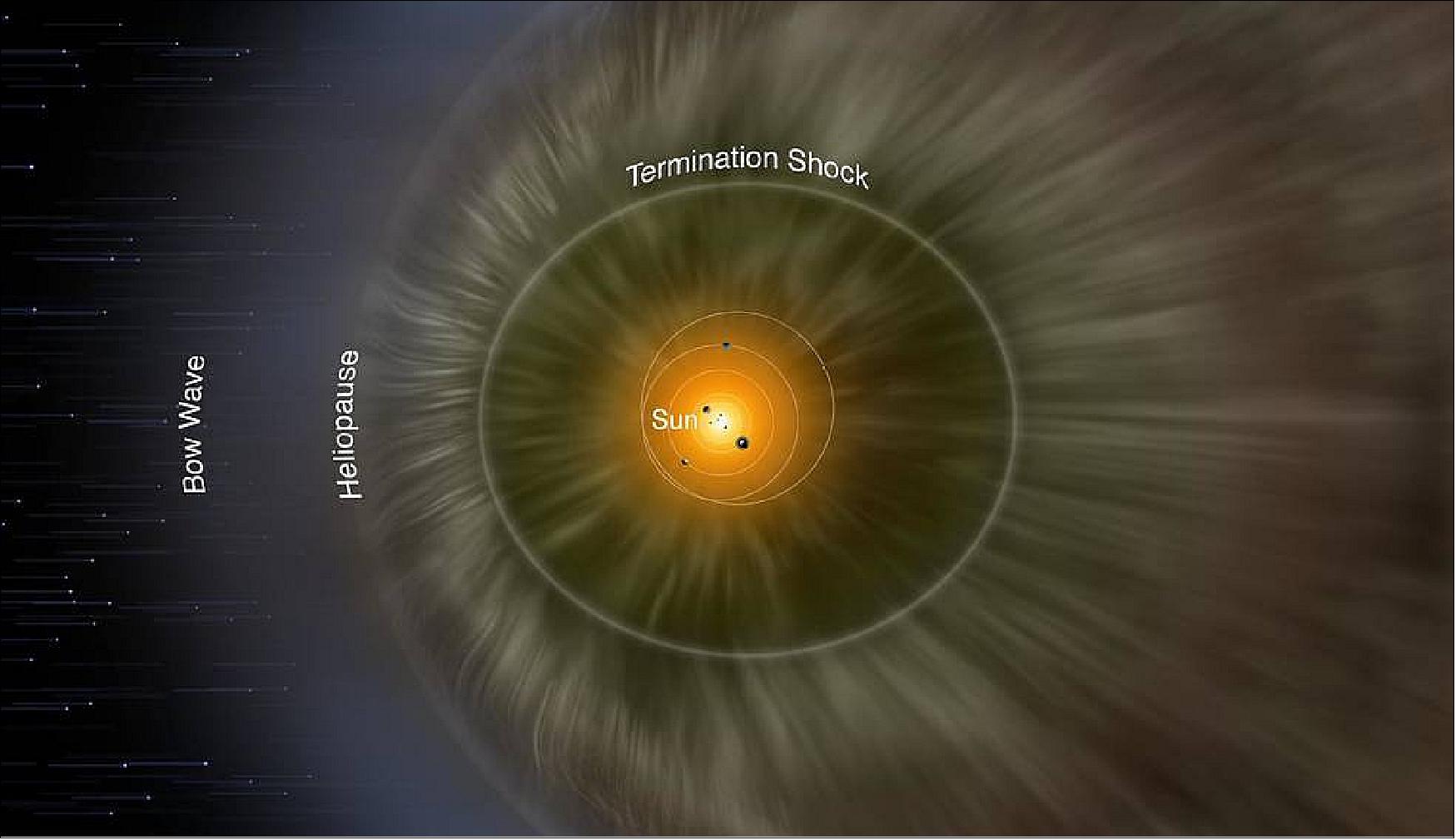
- Once beyond the termination shock, solar wind particles enter a special limbo zone known as the heliosheath. While the termination shock is essentially spherical, the edges of the heliosphere are thought to describe more of an arc around the Sun as it moves through space — closer to the Sun toward the front, and extending long behind it, not unlike a comet with a tail. Along these boundaries, solar wind particles mix with particles from interstellar space. Collisions are inevitable: the hot, electrically-charged solar wind particles bang into the slower, colder neutral atoms from interstellar space, stealing an electron and becoming neutral themselves.
- “From there they go travelling ballistically through space, and some make it all the way back to Earth,” Zirnstein said. “These are the energetic neutral atoms that IBEX observes.”
- In late 2016, when IBEX’s energetic neutral atom imager began to pick up an unusually strong signal, Professor McComas and his team set out to investigate its cause. Their findings are reported in an article published on March 20, 2018, in the Astrophysical Journal Letters. 15)
- The energetic neutral atoms were coming from about 30 degrees south of the interstellar upwind direction, where the heliosheath was known to be closest to Earth.
- To quantify its connection to the 2014 solar wind pressure increase, McComas and his team turned to numerical simulations, working out how such a pressure increase could affect the energetic neutral atoms that IBEX observes.
- “These types of simulations involve a model for the physics, which then gets turned into equations, which are in turn solved on a supercomputer,” said Jacob Heerikhuisen, a coauthor on both papers at the University of Alabama in Huntsville.
- Using computer models, the team simulated an entire heliosphere, jolted it with a solar wind pressure increase, and let it run the numbers. The simulation completed a story only hinted at by the data.
- According to the simulation, once the solar wind hits the termination shock it creates a pressure wave. That pressure wave continues on to the edge of the heliosphere and partially rebounds backwards, forcing particles to collide within the (now much denser) heliosheath environment that it just passed through. That’s where the energetic neutral atoms that IBEX observed were born.
- The simulations provided a compelling case: IBEX was indeed observing the results of the 2014 solar wind pressure increase, more than two years later.
- But the simulation didn’t stop there. It also revealed that the 2014 solar wind pressure increase would, over time, continue to blow up the heliosphere even further. Three years after the solar wind pressure increase — by the time the article was published — the termination shock, the inner bubble within the heliosphere, should expand by seven astronomical units, or seven times the distance from Earth to the Sun. The heliopause, the outer bubble, should expand by two astronomical units, with an additional two the following year.
- In short, by cranking up the pressure of the solar wind, our heliosphere today is bigger than it was just a few years ago.
The Heliosphere’s new Shape
- McComas and colleagues studied the very first signs of the 2014 solar wind pressure increase. But watching the data over the coming years may tell us even more — this time about the evolving shape of our heliosphere.
- “There have been many studies, some from quite a while ago, predicting what the heliosphere shape should look like,” Zirnstein, the lead author of the paper, reports. “But it’s still very much up for debate in the modelling community. We’re hoping that the 2014 solar wind pressure increase could help with that.”
- Using the same data and simulations used in the previous paper, Zirnstein and colleagues ran the clock forward, modeling the heliosphere eight years after the 2014 solar wind pressure increase. The results describe not only the past, but also model the future. The paper was published on May 30, 2018, in The Astrophysical Journal. 16)
- “What we think we should see in the near future is a ring, expanding across the sky, marking the change in energetic neutral atom flux over time,” said Zirnstein. “This ring expands away from the point of initial contact in the outer heliosphere, towards the directions of the heliotail.”

- Although the initial signal detected by IBEX in 2016 was a solid circle, it won’t stay that way. As the 2014 solar wind reaches points of the heliopause further and further away, they take longer to bounce back, like an echo off of a far-away wall. The heliosphere’s rounded shape causes this echo to reflect back in the form of a ring.
- But the key finding came from watching the ring as it expands.
- In their simulation, Zirnstein and colleagues found that the precise rate at which the ring expands depended in part on the distances between the various layers of the heliosphere: the termination shock, the heliopause, and the part of the heliosheath where the energetic neutrals were produced. Zirnstein realized he had found a new way to measure the size and shape of the heliosphere.
- “We could estimate the distances to the different boundaries of the heliosphere just by looking at this ring changing over time in the sky,” said Zirnstein.
- Zirnstein and colleagues used their simulated heliosphere to run a test study. By measuring the rate of expansion of the ring (and plugging it into the right equations), they could accurately reproduce the distances to key structures within their simulated heliosphere. Since they knew what those distances were in their simulation, they could check their work — validating that the technique got the right answers and should be accurate when applied to the real heliosphere.
- Deformities in the ring — deviations from a perfect circle — could also reveal asymmetries in the heliosphere’s overall shape. “It depends on how symmetric or asymmetric the heliosphere is,” Zirnstein added. “If the heliosphere was an ideal ‘comet shape,’ the ring should expand symmetrically over time. But in reality that’s probably not going to happen — we’ll have to wait and see what IBEX tell us.”
- Zirnstein expressed excitement about the possibility of learning the true shape of the heliosphere. “Over the next few years with more IBEX data, my hope is that we can build a 3D picture of the shape of the heliosphere,” said Zirnstein.
- The results of these two studies have important practical implications. “Connecting changes in the Sun with energetic neutral atom observations will help us understand long term changes in the hazardous conditions for space radiation environment — a sort of space climate as opposed to space weather,” McComas said. “As the solar wind blows more and less hard, and our solar bubble expands and contracts, which directly affects the amount of cosmic rays that can enter the heliosphere, potentially endangering astronauts on long duration spaceflights.”
- But the results also underscore the incredible power of our closest star. Changes on the Sun, including the solar wind, have significant consequences extending billions of kilometers into space where, to date, only the two Voyager spacecraft have ever ventured. With techniques like energetic neutral atom imaging, we cannot just picture, but precisely measure these far-off portions of the heliosphere — our home in the galaxy (Ref. 14).
• February 2018: According to Eric Christian, IBEX Mission Scientist at NASA/GSFC, the IBEX spacecraft and its payload are still working quite well.
• April 2017: IBEX (Interstellar Boundary Explorer) has now operated in space for 7 years and returned nearly continuous observations that have led to scientific discoveries and reshaped our entire understanding of the outer heliosphere and its interaction with the local interstellar medium. 17)
- IBEX observations have led to numerous “firsts” and discoveries, including the first measurements of the GDF (Globally Distributed Flux) of ENAs from the inner heliosheath and discovery of the completely unpredicted “Ribbon” of enhanced ENA emissions. These, and other important results were published in a special issue of Science in November 2009 (McComas et al. 2009c; Fuselier et al. 2009a; Funsten et al. 2009b; Möbius et al. 2009; Schwadron et al. 2009). These and numerous other firsts and discoveries from 2009 to 2013 were enumerated in Table 1 of McComas et al. (2014a), which also provided the first five full years of IBEX observations and examined temporal variations over that interval. Since the end of 2013, IBEX has extended the string of groundbreaking research and results and Table 5 of this study summarizes the major firsts and discoveries of the IBEX mission into 2016.
IBEX Ribbon | |
Discovery of an enhanced ENA Ribbon flux and its connection to the interstellar magnetic field (See review by McComas et al. 2014a) | McComas et al. 2009c |
Discovery of solar wind-like latitude/energy ordering of Ribbon emissions | McComas et al. 2012c |
Discovery of different time variations in different portions of the Ribbon, consistent with latitude structure and secondary ENA Ribbon source | McComas et al. 2014a |
Discovery of time variations in Ribbon at least down to 6 month scales | McComas et al. 2010 |
Triangulation of interstellar magnetic field unfolding in Voyager 1 obs., and IBEX measurements of Ribbon and ISN flow | Schwadron et al. 2015b |
Distance to Ribbon source inferred from parallax is 140 +84/-38 AU, consistent with secondary ENA source | Swaczyna et al. 2016a |
The energy-dependent position of the IBEX Ribbon due to the solar wind structure | Swaczyna et al. 2016b |
Global Heliosphere | |
First observations of globally distributed flux (GDF) ENAs from the inner heliosheath | McComas et al. 2009c |
Discovery of rapid (~6 months) time variations in the heliosphere’s interstellar interaction and connection to decreasing solar wind output | McComas et al. 2010 |
GDF ENAs ordered by the latitudinal solar wind structure | Dayeh et al. 2011 |
First observations of the heliotail, it’s ordering by fast and slow solar wind, and the influence of the interstellar magnetic field | Schwadron et al. 2011a |
Estimates of partitioning of energy between termination shock-processed particle populations in the Voyager directions | Wu et al. 2010 |
Discovery of the thermodynamic state of inner heliosheath far from equilibrium | Livadiotis et al. 2011 |
Discovery of region of maximum pressure in inner heliosheath and explanation of flow direction in inner heliosheath observed by Voyager 2 | Schwadron et al. 2014c |
Discovery of the “flattening out” of the ENA fluxes ~2012-2013 over most of the sky other than the heliotail, where they continued to drop off | McComas et al. 2014a |
Energy and latitude-dependence of ENA spectral indices indicates spectra not representable by single power law | Desai et al. 2015 |
Asymmetry of heliosheath pressure and plasma flows, and connection of heliotail port/starboard lobes to TS/IHS geometry, PUI abundance, and IHS plasma flow properties | Schwadron et al. 2014c |
Roll-over of heliospheric neutral H below 100 eV | Fuselier et al. 2014 |
Heliosheath pressure from the poles correlates with 11 year solar cycle | Reisenfeld et al. 2016 |
11 yr solar cycle and energy-dependent extinction of IHS PUIs by charge exchange likely responsible for generating heliotail lobe structure | Zirnstein et al. 2016c |
Voyager 1 in situ data outside the HP are consistent with a plasma depletion layer ~5 AU thick and connected to the B-V plane of the heliosphere based on IBEX observations | Cairns & Fuselier 2016 |
Interstellar Medium | |
First direct observations of interstellar Hydrogen, Deuterium, Oxygen, and Neon | Möbius et al. 2009 |
Discovery of secondary population of He (the “warm breeze”) | Kubiak et al. 2014 |
First connection of LISM environment from IBEX to TeV cosmic rays | Schwadron et al. 2014a |
Discovery that the heliosphere might have a bow wave ahead of it instead of a bow shock | McComas et al. 2012a |
First precise estimate of interstellar field strength as well as direction | Zirnstein et al. 2016b |
Refined ISN He flow direction, temperature, and speed | McComas et al. 2015b |
VLISM is warmer than previously expected | McComas et al. 2015a |
Co-planarity of ISN He, H, He Warm Breeze, the IBEX Ribbon center, and the interstellar magnetic field deduced from the Ribbon | ApJ Supp. Series 2015 |
Co-planarity of ISN He, H, He Warm Breeze, the IBEX Ribbon center, and the interstellar magnetic field deduced from the Ribbon | ApJ Supp. Series 2015 |
Determination of the local gas Ne/O ratio from neutral flow observations | Bochsler et al. 2012 |
Confirmation of He and O secondary component possibly from the OHS | Park et al. 2015 |
First quantitative derivation of ISN O properties, evidence for significant processing in OHS | Schwadron et al. 2016a |
First direct sampling of ISN H and its evolution during the solar cycle | Saul et al. 2012, 2013 |
Independent derivation of solar radiation pressure from ISN H observations revealed to be greater than that inferred from solar Ly-alpha flux data | Katushkina et al. 2015 |
Possible IS dust filament in OHS and correlation with LISM inflow direction | Frisch et al. 2015 |
First derivation of IS flow longitude from symmetry of IS PUI cut-off at 1 AU and connection to IBEX measurements | Moebius et al. 2015c |
Terrestrial Magnetosphere | |
First imaging of Earth’s subsolar magnetopause | Fuselier et al. 2010 |
First imaging of dynamic magnetotail and possible disconnection event | McComas et al. 2011b |
First images of magnetospheric cusps and their asymmetry | Petrinec et al. 2011 |
First characterization of dayside magnetosheath using ENAs | Ogasawara et al. 2013 |
First combined mission ENA imaging to provide direct timing of plasma transfer from dayside compression to magnetospheric ring current | McComas et al. 2012b |
Motion of terrestrial plasma sheet dominated by seasonal and diurnal motion of Earth’s dipole tilt | Dayeh et al. 2015 |
First imaging of development of cold terrestrial plasma sheet during period of northward IMF and its reversal | Fuselier et al. 2015 |
Evidence for suprathermal ion acceleration by diffusive shock acceleration at Earth’s bow shock, shocked SW in subsolar magnetopause | Ogasawara et al. 2015 |
Moon | |
First measurement of neutralized and backscattered solar wind from the Moon | McComas et al. 2009b |
Discovery of lunar ENA albedo on solar wind speed and Mach number | Funsten et al. 2013a |
Space Mission Capabilities | |
First use of additional Solid Rocket Motor on Pegasus LV and spacecraft propulsion to achieve very high altitude orbit | McComas et al. 2009a |
Discovery and first use of long-term stable lunar synchronous orbit. | McComas et al. 2011a |
• February 2016: The solar wind emanating from the Sun interacts with the local interstellar medium (LISM), forming the heliosphere. Hydrogen energetic neutral atoms (ENAs) produced by the solar-interstellar interaction carry important information about plasma properties from the boundaries of the heliosphere, and are currently being measured by NASA's IBEX (Interstellar Boundary Explorer). IBEX observations show the existence of a "ribbon" of intense ENA emission projecting a circle on the celestial sphere that is centered near the local ISMF (Interstellar Magnetic Field) vector. 18) 19)
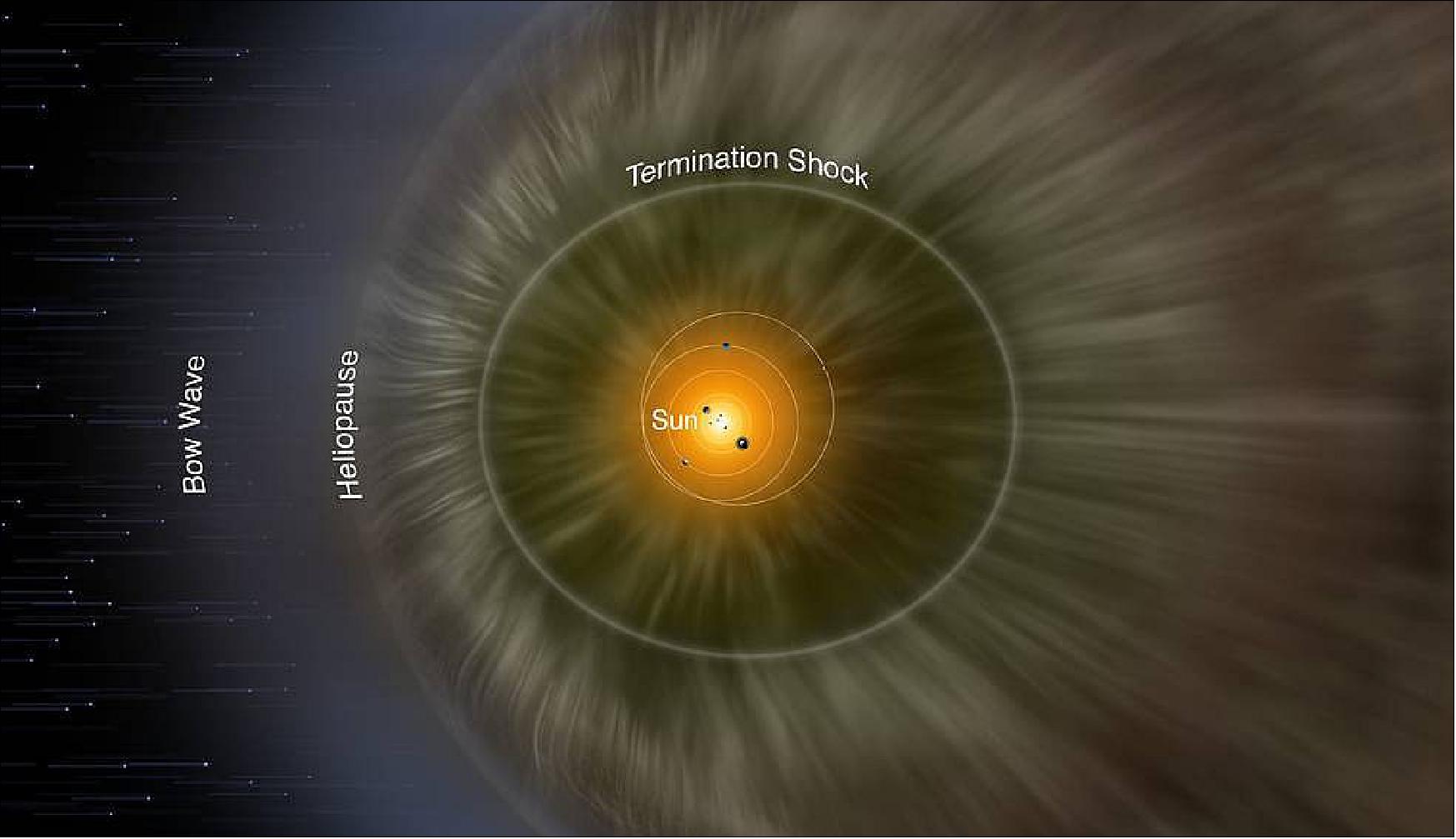
- The new study uses IBEX data and simulations of the interstellar boundary – which lies at the very edge of the giant magnetic bubble surrounding our solar system called the heliosphere – to better describe space in our galactic neighborhood. The paper is based on one particular theory of the origin of the IBEX ribbon, in which the particles streaming in from the ribbon are actually solar material reflected back at us after a long journey to the edges of the sun’s magnetic boundaries. A giant bubble, known as the heliosphere, exists around the sun and is filled with what’s called solar wind, the sun’s constant outflow of ionized gas, known as plasma. When these particles reach the edges of the heliosphere, their motion becomes more complicated.
- “The theory says that some solar wind protons are sent flying back towards the sun as neutral atoms after a complex series of charge exchanges, creating the IBEX ribbon,” said Eric Zirnstein, a space scientist at the Southwest Research Institute in San Antonio, Texas, and lead author on the study. “Simulations and IBEX observations pinpoint this process – which takes anywhere from three to six years on average – as the most likely origin of the IBEX ribbon.”
- Outside the heliosphere lies the interstellar medium, with plasma that has different speed, density, and temperature than solar wind plasma, as well as neutral gases. These materials interact at the heliosphere’s edge to create a region known as the inner heliosheath, bounded on the inside by the termination shock – which is more than twice as far from us as the orbit of Pluto – and on the outside by the heliopause, the boundary between the solar wind and the comparatively dense interstellar medium.
- Some solar wind protons that flow out from the sun to this boundary region will gain an electron, making them neutral and allowing them to cross the heliopause. Once in the interstellar medium, they can lose that electron again, making them gyrate around the interstellar magnetic field. If those particles pick up another electron at the right place and time, they can be fired back into the heliosphere, travel all the way back toward Earth, and collide with IBEX’s detector. The particles carry information about all that interaction with the interstellar magnetic field, and as they hit the detector they can give us unprecedented insight into the characteristics of that region of space.
- “Only Voyager 1 has ever made direct observations of the interstellar magnetic field, and those are close to the heliopause, where it’s distorted,” said Zirnstein. “But this analysis provides a nice determination of its strength and direction farther out.” The directions of different ribbon particles shooting back toward Earth are determined by the characteristics of the interstellar magnetic field. For instance, simulations show that the most energetic particles come from a different region of space than the least energetic particles, which gives clues as to how the interstellar magnetic field interacts with the heliosphere.
- For the recent study, such observations were used to seed simulations of the ribbon’s origin. Not only do these simulations correctly predict the locations of neutral ribbon particles at different energies, but the deduced interstellar magnetic field agrees with Voyager 1 measurements, the deflection of interstellar neutral gases, and observations of distant polarized starlight.
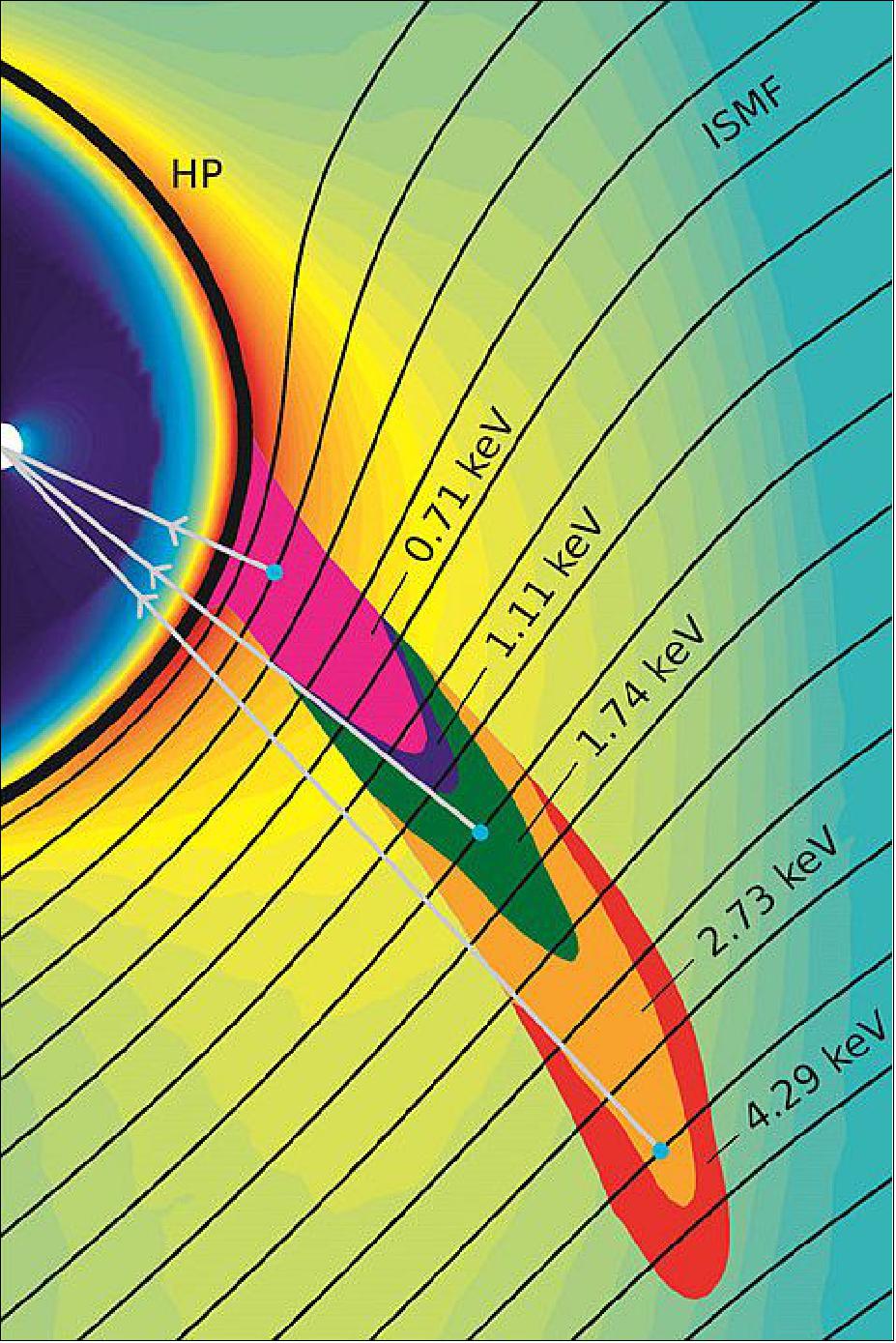
• October 20, 2015: NASA's IBEX mission reached a milestone in its seven-year mission today with the publication of 14 papers in a special issue of The Astrophysical Journal Supplement. Data from IBEX, led by SwRI (Southwest Research Institute), allowed the team of international researchers to provide the most definitive analyses, theories, and results about the “local” interstellar space to date. 20) 21) 22) 23)
- The IBEX spacecraft, which launched in 2008, uses ENA (Energetic Neutral Atom) imaging to examine how our heliosphere, the “bubble” in which our Sun and planets reside, interacts with interstellar space, the environment outside of the heliosphere. IBEX created the first global maps showing these interactions and how they change over time. IBEX also directly measures interstellar neutral atoms flowing into the solar system; the journal’s special issue focuses on these particles. “Over the past six years, this fundamental work focused on our place in the solar system has become the gold standard for understanding our Sun, our heliosphere, and the interstellar environment around us,” said David McComas, principal investigator of the IBEX mission.
- Eight papers highlight the interstellar helium measurements taken by IBEX and NASA’s Ulysses spacecraft (launched in 1990) — the only two spacecraft to have directly measured the local interstellar flow of these helium atoms. The studies resolved an inconsistency in the direction and temperature of the interstellar flow in the data gathered by Ulysses compared to those taken by IBEX. Both data sets now confirm that the local interstellar flow is significantly hotter than believed previously from the Ulysses observations alone, and provide a great deal of insight into the direction the heliosphere is moving through the local material in the galaxy, as well as how fast it is traveling.
- Two papers examine aspects of determining the composition of interstellar particles, looking closely at oxygen, helium, and neon, as well as how those and other particles are effectively measured. The final four papers discuss analysis techniques and related theoretical considerations, such as the effects of radiation pressure and how planetary gravity affects the course of neutral atoms as they travel through the heliosphere. “Collectively, these studies, along with previously published papers related to the IBEX interstellar neutral observations, open a completely new window on the local interstellar environment, its composition, its properties, and the likely processes at work in the interstellar space around the Sun and in the heliospheric boundary region,” said McComas.
- Initially a two year mission, funding for IBEX has been extended through 2017, with the potential for mission extensions well beyond that. The latest National Research Council Decadal Survey on Heliophysics emphasizes the urgent need for additional research in this area. One concept for a follow-on mission is the IMAP (Interstellar Mapping and Acceleration Probe), which the Decadal Survey recommended as an approximately half-billion-dollar, principal investigator-led mission for the NASA Solar Terrestrial Probes line. IMAP would use a combination of significantly higher resolution and sensitivity to build on the fundamental groundwork laid by IBEX.
• July 2015 - Mission extension until 2017: The IBEX mission is approved by NASA to continue planning against the current budget guidelines. Any changes to the guidelines will be handled through the budget formulation process. The IBEX mission will be invited to the 2017 Heliophysics Senior Review. 24)
• June 2015: IBEX (Interstellar Boundary Explorer) measures ENAs (Energetic Neutral Atoms) coming from the far outer heliosphere. The goal is to use these data to deduce information about the global structure of the heliosphere, the spectrum of energetic particles in the outer heliosphere, the interaction of the heliosphere with the interstellar medium, and properties of local interstellar medium (LISM). In the extended mission (EM) the IBEX team also proposes to focus on the global structure of the Earth’s magnetosphere and its dynamic interaction with the solar wind and ENA emission from the other solar system objects. In the prime mission phase IBEX has made a number of important discoveries related to the structure of the outer heliosphere. A surprise was the discovery that ENAs of around 1keV peak along a band, called the “IBEX ribbon” that seems to be defined by the ring where the line of sight is normal to the local, possibly draped, interstellar magnetic field. The ribbon exhibits structure that varies with time. The source of the ribbon remains uncertain and is a major focus of the EM. Peaking of the highest-energy ENAs in the polar regions where the solar wind speed is the highest suggest that the source of ENAs is linked to the solar wind speed. 25)
- Consistent with this idea, the spectra of ENAs are harder near the poles than the equator. Because of the time delay in the propagation of the solar wind, the present measurements correspond to solar minimum so a major goal of the EM is to study the variation of ENAs and the structure of the global heliosphere with the phase of the solar cycle. Further measurements of neutral H and He from the LISM will establish the direction of the flow of the LISM. Because the orbital radius extends out to around 50 RE IBEX has been able to image ENA emission from Earth’s global magnetosphere, including the magnetopause, the cusps, and the tail regions. Time resolution is sufficient to image the dynamics of the magnetosphere during its interaction with CMEs during solar maximum although spatial resolution is limited. IBEX has been able to measure ENAs backscattered from the lunar surface during its interaction with the solar wind. During the extended mission IBEX will also seek to measure scattering from comets and cometary tails.
- IBEX science strengths: The interaction of the solar wind with the interstellar medium, the primary goal of IBEX, is a priority of NASA’s SMD (Science Mission Directorate) and the 2012 Solar and Space Physics Decadal Survey. Because of the presence of the Voyager spacecraft in the outer heliosphere, the EM IBEX measurements will provide critical measurements on the global structure of the heliosphere that can be compared with in situ Voyager measurements. The recent observations of a tilted heliotail will provide additional information on the orientation of the LISM magnetic field. The EM will cover the period of solar maximum and combined with the earlier data at solar minimum will complete the exploration of the structure of the outer heliosphere over the complete solar cycle. Particularly important is to explore the impact of changing solar wind velocity and dynamic pressure on the distribution of ENAs in the outer heliosphere. This additional information should enable the IBEX team to pin down the source of the ribbon and to understand the distribution and spectral shape of the globally distributed ENA flux and its implications for understanding particle heating and acceleration in the outer heliosphere.
- It is now well accepted that the ENA emission from the ribbon is related to the local interstellar magnetic field giving an important constraint on models of the global heliosphere—despite the fact that we do not actually know, at present, what causes the ribbon. The study of emissions from the heliospheric tail will provide a valuable check on the overall structure of the heliosphere and help determine the validity of the recently proposed “jet” model of the heliosphere. The variation of the flux of neutral H over the upcoming solar minimum will provide important data for understanding the role of interstellar pickup particles in the dynamics of the solar wind. Global imaging of the interaction of the Earth’s magnetosphere with the dynamic solar wind, with resolution times on the order of minutes or less, will produce key data for benchmarking global magnetospheric models and for assisting in the interpretation of local measurements by satellites in the local geospace environment.
- IBEX relevant strengths to Heliophysics Research Objectives: IBEX has significant synergy with other heliospheric missions. The Voyager 1 spacecraft is in the VLISM (Very Local Interstellar Medium) and Voyager 2 is in the inner heliosheath and approaching the heliopause. Comparison with IBEX is a unique opportunity because local measurements in the outer heliosphere will not be available for decades at best after the Voyager mission comes to a close. The heliopause encounters by Voyager will enable IBEX to benchmark estimates of the thickness of the inner heliosheath based on integrated fluxes of ENAs. Enhanced activity in the heliosheath associated with the propagation of solar disruptions into the outer heliosphere during solar maximum might be identifiable with both Voyager and IBEX. Comparisons of the IBEX ribbon with Cassini’s Imaging-Neutral Camera (INCA) measurements of a similar band are ongoing and will continue. Global imaging of the Earth’s magnetosphere with IBEX will produce a unique global view of how CMEs impact the Earth space environment while existing satellites within the magnetosphere—Cluster, THEMIS, the TWINS (Two Wide-angle Imaging Neutral-atom Spectrometers), ARTEMIS, Van Allen Probes—and the upcoming MMS (Magnetospheric MultiScale) mission produce local measurements (MMS was launched on March 13, 2015).
- IBEX spacecraft / instrument health and status: The spacecraft subsystems are healthy with ample consumables present. IBEX has two instruments that measure ENAs with energies in the range of 10 eV–2 keV (IBEX-LO) and in the range of 380 eV–6 keV (IBEX-HI). ENAs are not deflected by magnetic fields and therefore are able to offer global views of heliospheric structure and dynamics. The measurements, because they are line-of-sight integrals, complicate the interpretation and typically require a parallel modeling effort for interpreting the results. Both the IBEX-HI and IBEX-LO instruments are operating normally.
• On August 4, 2014, scientists highlighted an impressive list of achievements in researching the outer heliosphere at the 40th International Committee on Space Research (COSPAR) Scientific Assembly in Moscow, Russia. 26)
The million-mile/hour solar wind pushed out by the Sun inflates a giant bubble in the interstellar medium called the heliosphere, which envelops the Earth and the other planets. After the two Voyager spacecraft, launched in 1977, completed their mission to study Jupiter, Saturn, Uranus and Neptune, they continued on their journey to interstellar space. Another mission, the Interstellar Boundary Explorer (IBEX) launched in 2008, is designed to map and study the global interactions at the boundary between the heliosphere and interstellar space. Together, the Voyagers and IBEX have helped advance an important area of research to provide insight to humankind’s evolving home in the galaxy.
Both Voyagers provide “point” measurements along their journey out of the solar system. Those measurements offer important details about interactions occurring along their paths. IBEX complements the Voyagers’ measurements by imaging the interactions occurring at the edge of the heliosphere over all directions in space.
IBEX creates images of energetic neutral atoms (ENAs) to make visible the invisible energetic interactions at the edge of the solar system (Figure 26). The science team summarized its first five years of accomplishments, including the first five years of maps showing interactions at the edge of the solar system, a trove of data in multiple formats, and aspects of data analysis and the methods used to refine them. 27)
Current research has the team studying the enigmatic ribbon separately in two hemispheres. The ribbon in the northern hemisphere extends farther back in distance — and in time — than the southern hemisphere. Recognizing that time differentiation plays a role in the observations is helping the team differentiate between the more than dozen current models that seek to explain the ribbon.
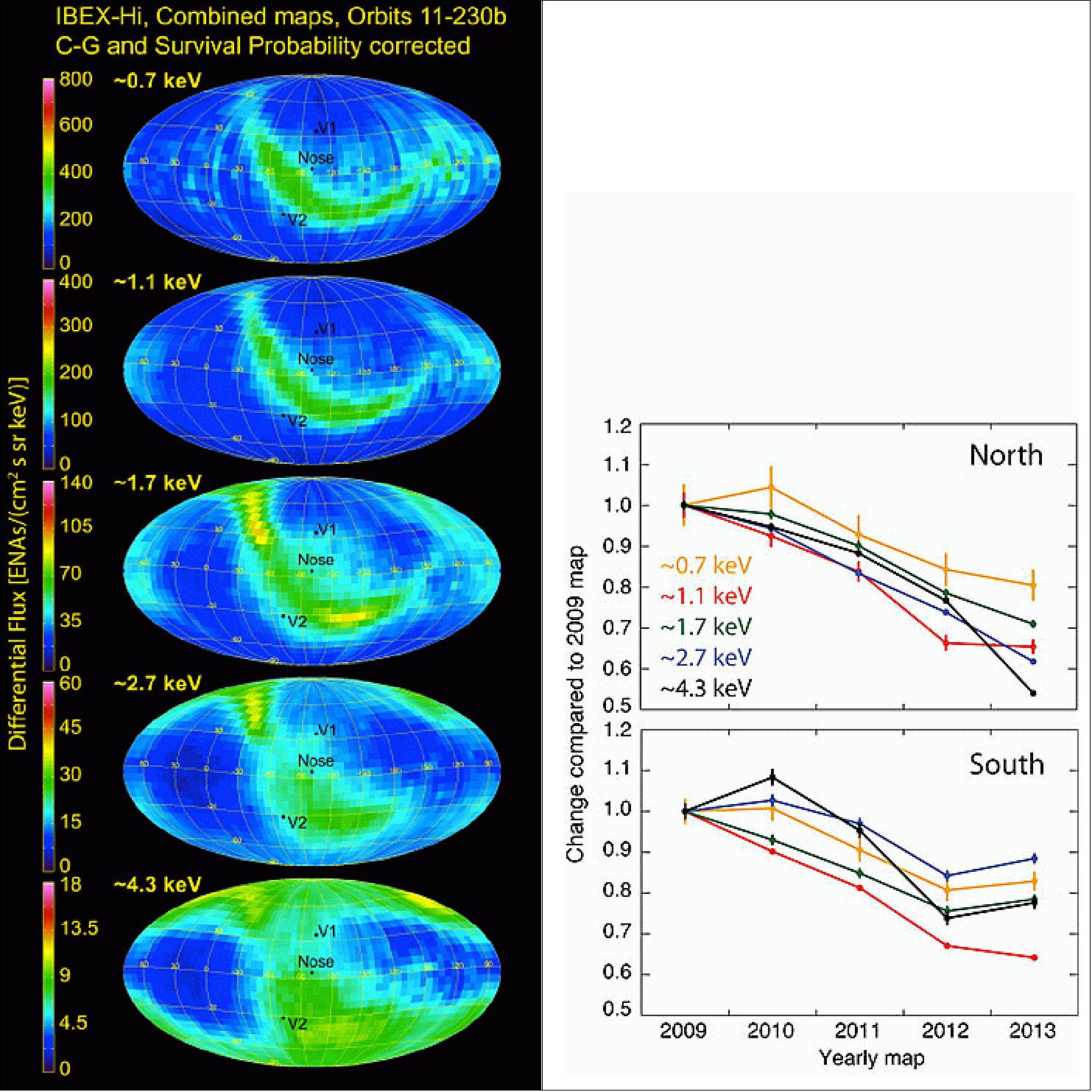
Legend to Figure 26: The left image shows a selection of dominant ribbon ENA emission regions (red outlined areas in each map). The ribbon emissions are strongest at increasingly higher latitudes for higher energies, consistent with the latitude ordering of the solar wind around solar minimum. - The right image shows ENA fluxes at various energies from the latitude-dependent ribbon regions specified in the opposite image. The northern hemisphere (top frame) and southern hemisphere (bottom frame) fluxes show similar reductions from 2009 to 2012, but clearly diverge in 2013.
• Feb. 2014: The spacecraft data in the past five years from near Earth and cosmic ray observations have painted a better picture of the magnetic system that surrounds us, while at the same time raising new questions. Scientists are challenging our current understanding in a new study that combines observations of massively energetic cosmic ray particles streaming in from elsewhere in the Milky Way along with observations from NASA's IBEX (Interstellar Boundary Explorer). 28) 29) 30) 31)
The data sets show a magnetic field that is nearly perpendicular to the motion of our solar system through the galaxy. In addition to shedding light on our cosmic neighborhood, the results offer an explanation for a decades-old mystery on why we measure more incoming high-energy cosmic rays on one side of the sun than on the other. The IBEX team is discovering how the interstellar magnetic field shapes, deforms, and transforms our entire heliosphere.

Legend to Figure 27: Cosmic ray intensities (left) compared with predictions (right) from IBEX. The similarity between these observations and predictions-as evidenced by the similar color regions-supports the local galactic magnetic field direction determined from IBEX observations made from particles at vastly lower energies than the cosmic ray observations shown here. The blue area represents regions of lower fluxes of cosmic rays. The gray and white lines separate regions of different energies-lower energies above the lines, high energies below.
• October 30, 2013: Launched on Oct. 19, 2008, the IBEX spacecraft is unique to NASA's heliophysics fleet: it images the outer boundary of the heliosphere, a boundary at the furthest edges of the solar system, far past the planets, some 12-13 million km away. There, the constant stream of solar particles flowing off the sun, the solar wind, pushes up against the interstellar material flowing in from the local galactic neighborhood. 32)
IBEX is also different because it creates images from particles instead of light. IBEX, scientists create maps from the observed neutral atoms. Some are of non-solar origin, others were created by collisions of solar wind particles with other neutral atoms far from the sun. Observing where these ENAs (Energetic Neutral Atoms) come from describes what's going on in these distant regions. Over the course of six months and many orbits around Earth, IBEX can paint a picture of the entire sky in ENAs.
During its first five years on orbit, IBEX has made some astounding discoveries.
1) Mapping the Boundaries: In its first year, IBEX scientists created the first-ever all-sky map of the heliosphere's boundary, where the influence of the solar wind diminishes and interacts with the interstellar medium. The most startling finding is that the map was not uniform or symmetrical, but shows a bright ribbon of energetic neutral atoms snaking through it.
During its second and third years, IBEX showed that the heliosphere's boundaries changed more rapidly than expected, with variations as short as six months. Additional sets of all-sky maps showed the evolution of the interstellar boundary region: the mysterious ribbon feature at the nose, of the heliosphere – in the front as it moves through space – evolved. Also, a knot-like feature spread and diminished. This variation over time is challenging scientists to try to understand how the heliosphere can change so rapidly.
2) ENAs Near Earth: Because IBEX is orbiting Earth, it also can look back toward Earth's neutral-atom environment and so has provided the first ENA images of the magnetosphere from the outside.
Nearby, IBEX has scanned the moon, as well. The moon has no atmosphere or magnetosphere, so the solar wind slams unimpeded into its surface. IBEX observations showed that the moon creates a backscattered, neutral solar wind: about 10 percent of the impinging solar-wind protons bounce off the lunar surface, becoming ENAs as they do.
3) The Heliosphere: Looking Ahead and Looking Behind: Measurements by IBEX announced in 2012 show the influence of the heliosphere on the local interstellar medium is different than expected. Previous models showed a boundary ahead of the heliosphere, outside the influence of the sun: a shock formed by the entire heliosphere pushing through the interstellar material around it. IBEX data suggests that there is no bow shock preceding the heliosphere's movement through space.
IBEX also offered up the first observations of the heliotail. If our eyes could see particles and we looked straight down the tail we would see an unexpected shape a little like a four-leaf clover. The two side leaves are filled with slow moving particles and the upper and lower leaves with fast ones.
4) Into the Galaxy: Much further away, IBEX also provided information about the local galactic environment. It made the first direct measurements of neutral hydrogen, oxygen, and neon coming into the heliosphere from the interstellar medium. The measurements show that the composition of the current galactic neighborhood is different than that of the sun and the solar system. This puzzle may mean that the sun has moved out of the region where it formed, or that some of the oxygen has been captured by dust in interstellar space.
IBEX also found that the speed of the galactic wind registered around 52,000 miles/hr. By comparing this wind to previous results from other missions over the last 40 years, scientists believe that the direction of the wind has changed by about 7 degrees in the last four decades. While the cause of this shift is unknown, it may be telling us something about changing conditions as we move through our region of the Milky Way (Ref. 32).
• Sept. 5, 2013: Data from NASA's IBEX spacecraft reveal that neutral interstellar atoms are flowing into the solar system from a different direction than previously observed. 33)
Interstellar atoms flow past the Earth as the solar system passes through the surrounding interstellar cloud at 23 km/s (82,800 km/hr). The latest IBEX measurements of the interstellar wind direction were discovered to differ from those made by the Ulysses spacecraft in the 1990s. That difference led the IBEX team to compare the IBEX measurements to data gathered by 11 spacecraft between 1972 and 2011. Statistical testing of the Earth-orbiting and interplanetary spacecraft data showed that, over the past 40 years, the longitude of the interstellar helium wind has changed by 6.8±2.4 degrees.
The earliest historical data on the interstellar wind comes from the 1970s from the U.S. Department of Defense's Space Test Program 72-1 and SOLRAD 11B, NASA's Mariner, and the Soviet Prognoz 6. While instruments have improved since the 1970s, comparing information from several sets of observations helped the researchers gain confidence in results from that early data. The team went on to look at another seven data sets including the Ulysses information from 1990 to 2001, and more recent data from IBEX, as well as four other NASA missions: STEREO (Solar Terrestrial Relations Observatory), ACE (Advanced Composition Explorer), EUVE (Extreme Ultraviolet Explorer), and the MESSENGER (MErcury Surface, Space ENvironment, GEochemistry, and Ranging) mission, currently in orbit around Mercury. The eleventh set of observations came from JAXA's (Japanese Aerospace Exploration Agency) Nuzomi mission. 34)
The team concluded it's highly likely that the direction of the interstellar wind has changed over the past 40 years. It's also highly unlikely that the direction of the interstellar helium wind has remained constant. The team estimates that the change in wind direction could be explained by turbulence in the interstellar cloud around the Sun.The results, based on data spanning four decades from 11 different spacecraft, were published in Science on Sept. 6, 2013. 35)

• July 2013: Our solar system has a tail, called the heliotail, just like a comet. IBEX has for the first time mapped out the structure of this tail, which is shaped like a four-leaf clover. 36) 37) 38) 39) 40)
IBEX measures the neutral particles created by collisions at the solar system's boundaries. This technique, called energetic neutral atom imaging, relies on the fact that the paths of neutral particles are not affected by the solar magnetic field. Instead, the particles travel in a straight line from collision to IBEX. Consequently, observing where the neutral particles came from describes what is going on in these distant regions.
By combining observations from the first three years of IBEX imagery, the IBEX team showed a tail with a combination of fast and slow moving particles. There are two lobes of slower particles on the sides and faster particles above and below. This four-leaf clover shape can be attributed to the fact that the sun has been sending out fast solar wind near its poles and slower wind near its equator for the last few years. This is a common pattern in the most recent phase of the sun's 11-year activity cycle.
The clover shape does not align perfectly with the solar system, however. The entire shape is rotated slightly, indicating that as it moves further away from the sun and its magnetic influence, the charged particles begin to be nudged into a new orientation, aligning with the magnetic fields from the local galaxy.
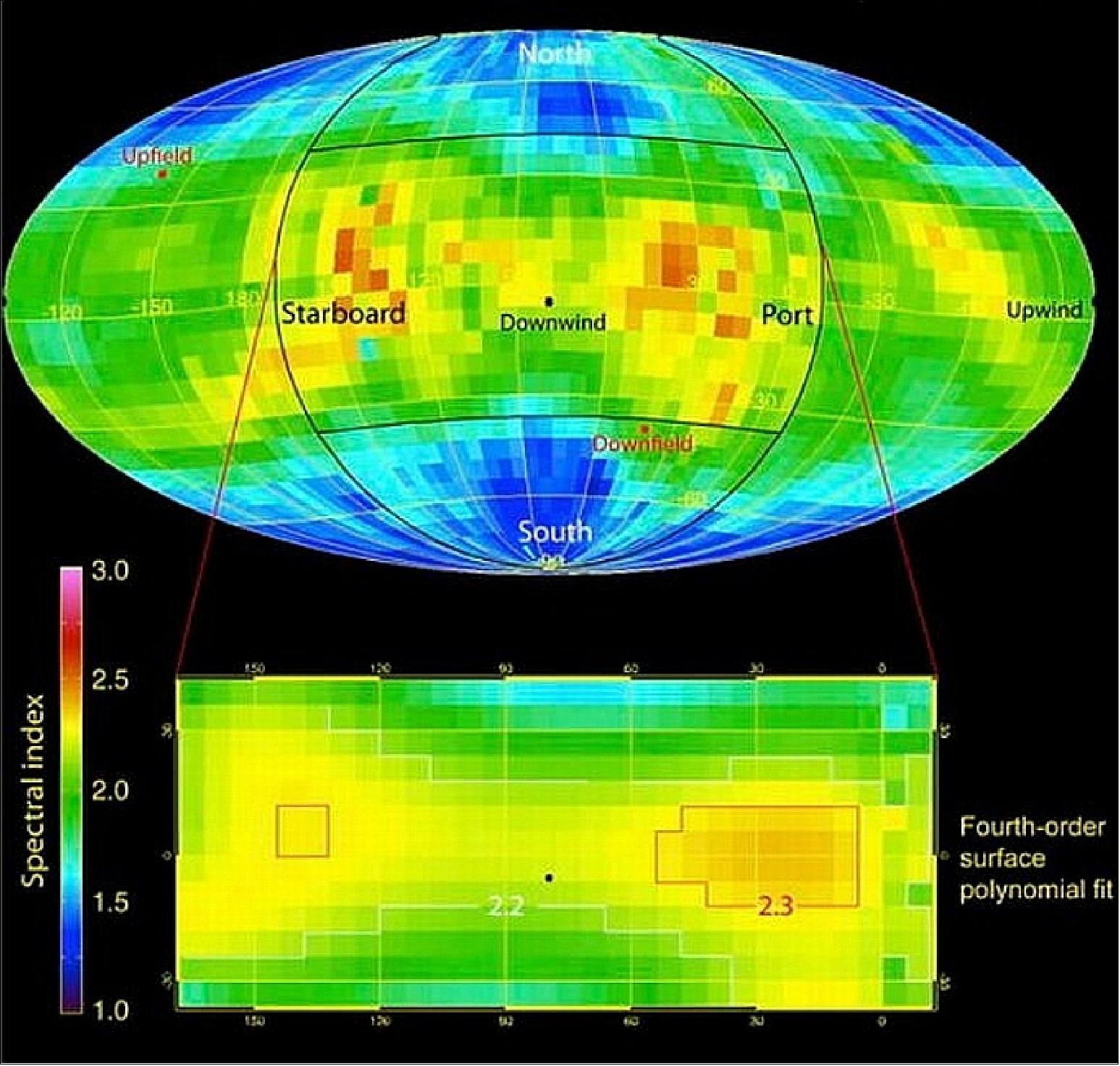
Legend to Figure 29: The data from NASA’s Interstellar Boundary Explorer shows what it observed looking down the solar system’s tail. The image illustrates the IBEX observation of spectral slope where red and yellow indicate lower energy particles and green and blue higher energy ones. The central portion (circle) is looking down the heliotail and shows two lower energy “lobes” on the port and starboard sides and high energy regions at higher northern and southern latitudes.
• Feb. 2013: In a new "retention model," researchers from the University of New Hampshire and SwRI (Southwest Research Institute) suggest that charged particles trapped in this region create the ribbon as they escape as neutral atoms. 41) 42) 43) 44)
The ribbon can be used to tell us how we're moving through the magnetic fields of the interstellar medium and how those magnetic fields then influence our space environment. - In particular, these strong magnetic fields appear to play a critical role in shaping our heliosphere — the huge bubble that surrounds our solar system and shields us from much of harmful galactic cosmic radiation that fills the galaxy. This may have important ramifications for the history and future of radiation in space, and its impact here on Earth, as the heliosphere changes in response to changing conditions in the interstellar medium or the "space between the stars."
According to the retention theory, the ribbon exists in a special location where neutral hydrogen atoms from the solar wind move across the local galactic magnetic field. Neutral atoms are not affected by magnetic fields, but when their electrons get stripped away, they become charged ions and begin to gyrate rapidly around magnetic field lines. That rapid rotation creates waves or vibrations in the magnetic field, and the charged ions then become trapped by the waves. This is the process that creates the ribbon.
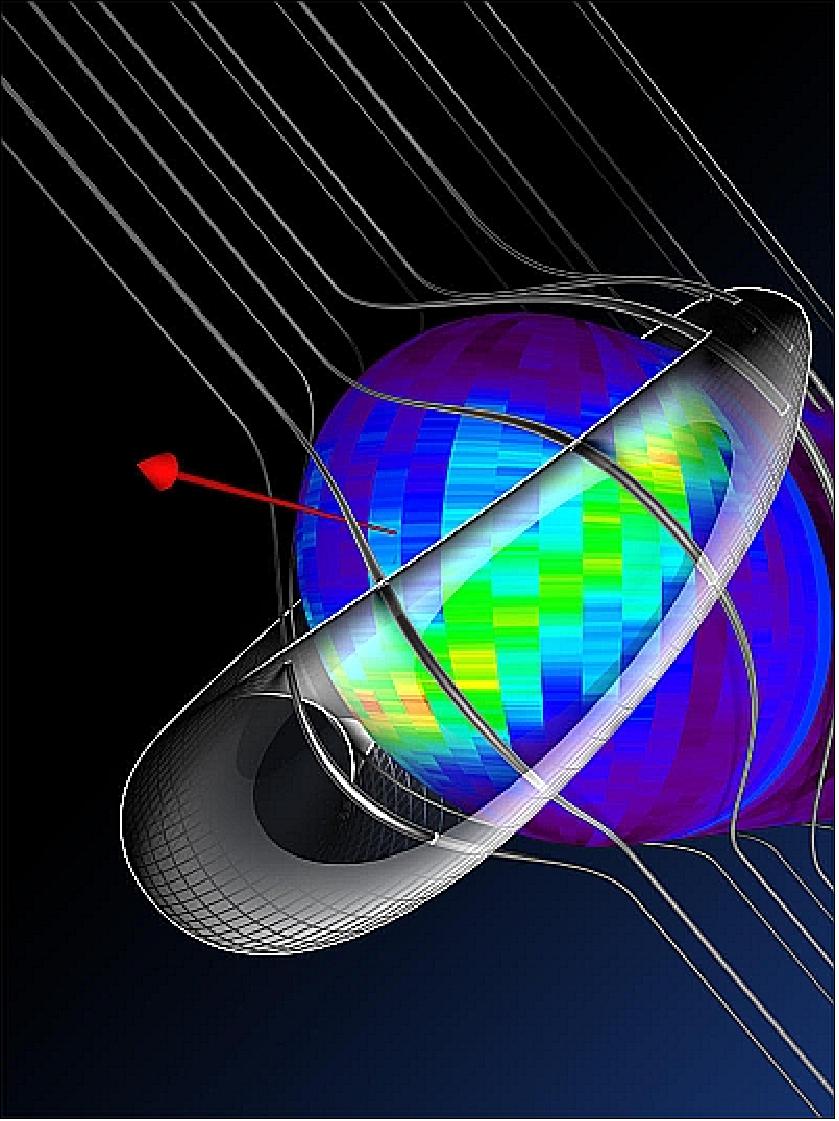
Legend to Figure 30: The interstellar magnetic field lines are shown running from upper left to lower right around the heliosphere, and the area where the field lines "squeeze" the heliosphere corresponds to the ribbon location. The red arrow at the front shows the direction of travel of our solar system (Ref. 43).
• In May 2012, new results from IBEX reveal that the bow shock, widely accepted by researchers to precede the heliosphere as it plows through tenuous gas and dust from the galaxy, does not exist. 45) 46)
For a quarter century, researchers believed that the heliosphere moved through the interstellar medium at a speed fast enough to form a bow shock. IBEX data have shown that the heliosphere actually moves through the local interstellar cloud at about 52,000 miles per hour, roughly 7,000 miles per hour slower than previously thought — slow enough to create more of a bow "wave" than a shock.
The IBEX team combined its data with analytical calculations and modeling and simulations to determine the conditions necessary for creating a bow shock. Two independent global models — one from a group in Huntsville, Ala., and another from Moscow — correlated with the analytical findings.
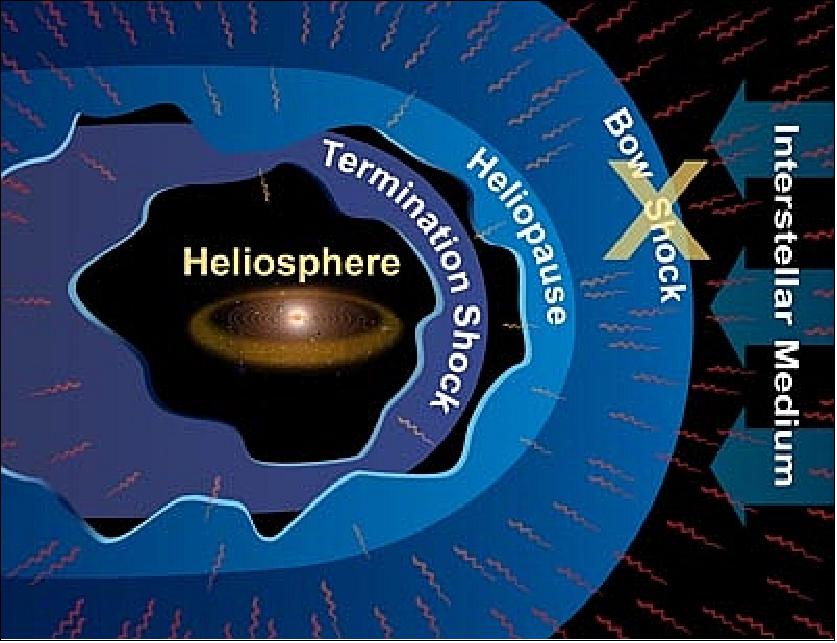
• The IBEX spacecraft and its payload are operating nominally in 2012.
- NASA's IBEX has captured the best and most complete glimpse yet of what lies beyond the solar system. The new measurements give clues about how and where our solar system formed, the forces that physically shape our solar system, and the history of other stars in the Milky Way. 47)
The Earth-orbiting spacecraft observed four separate types of atoms including hydrogen, oxygen, neon and helium. These interstellar atoms are the byproducts of older stars, which spread across the galaxy and fill the vast space between stars. IBEX determined the distribution of these elements outside the solar system (i.e. outside the heliosphere), which are flowing charged and neutral particles that blow through the galaxy, or the so-called interstellar wind.
Using data from IBEX, the researchers team compared the neon-to-oxygen ratio inside vs. outside the heliosphere. In a series of six science papers in the Astrophysical Journal, they reported that for every 20 neon atoms in the galactic wind, there are 74 oxygen atoms. In our own solar system, however, for every 20 neon atoms there are 111 oxygen atoms. - That translates to more oxygen in any given slice of the solar system than in local interstellar space. 48)
• The IBEX Ribbon of energy is a major discovery of the mission requiring scientific interpretation. This was done by the IBEX science team in a publication of the Astrophysical Journal in April 2011. 49)
The finding, which overturns 40 years of theory, provides insight into the fundamental structure of the heliosphere, which in turn helps scientists understand similar structures or “astrospheres” that surround other star systems throughout the cosmos. Isolating and separating the ribbon from the IBEX maps was like pulling the drapes from our window to discover the landscape at the edge of the solar system. The IBEX maps are very rich scientifically and are critical in helping scientists understand how our space environment is controlled by the galactic medium. They provide the first images of our solar system’s boundaries, which control the access to potentially harmful galactic cosmic rays as well as all other matter from deep space. - The most energetic galactic cosmic rays penetrate even the powerful magnetic fields closest to Earth and eventually collide and interact with Earth’s atmosphere. The direct or indirect effects of these cosmic rays on the Earth system, including our biosphere, remain poorly understood and are often highly controversial.
Prior to IBEX, most scientists believed that the global boundaries of our solar system were controlled mainly by the motion of our solar system through the galaxy and the solar wind, an extremely fast flow of electrically charged matter that flows out from the Sun. The IBEX maps reveal the galactic magnetic field is also a critical part of the Sun’s interaction with the galaxy. 50)
• The IBEX spacecraft and its payload are operating nominally in 2011. IBEX passed a couple of major mission milestones in Feb./March 2011. IBEX began collecting science data on February 1, 2009, so the End of Prime Mission was set at February 1, 2011 .On March 2, 2011, the IBEX mission was reviewed by NASA and given a 2 year mission extension (until the next review in the spring of 2013). 51)
Some special events/discoveries during he prime mission were:
- Discovered the "IBEX Ribbon" and made the first observations of energetic neutral hydrogen atoms originating from our heliosphere’s interaction with the local part of the galaxy
- Made the first direct observations of interstellar neutral hydrogen and oxygen drifting into the heliosphere from interstellar space
- Detected the first energetic neutral atoms coming from the surface of our Moon
- Imaged our Earth’s magnetospheric "plasma tail"
- Imaged the interactions between the Earth’s dayside magnetosphere and the solar wind
- Detected changes in the IBEX Ribbon.
• Sept. 30, 2010: The unusual "knot" in the bright, narrow ribbon of neutral atoms emanating in from the boundary between our solar system and interstellar space appears to have "untied.". 52) 53) 54) 55) 56)
After the second complete sweep of the sky had been completed in the summer of 2010, IBEX has again delivered an unexpected result: the map has changed significantly. Overall, the intensity of ENAs has dropped 10% to 15%, and the hotspot has diminished and spread out along the ribbon.
Researchers theorize the ribbon, first revealed in maps produced by NASA's IBEX spacecraft, forms in response to interactions between interstellar space and the heliosphere, the protective bubble in which the Earth and other planets reside. Sensitive neutral atom detectors aboard IBEX produce global maps of this region every six months.
Analyses of the first map, released in the fall of 2009 (Figure 34), suggest the ribbon is somehow ordered by the direction of the local interstellar magnetic field outside the heliosphere, influencing the structure of the heliosphere more than researchers had previously believed. The knot feature seen in the northern portion of the ribbon in the first map stood apart from the rest of the ribbon as the brightest feature at higher energies.
In Sept. 2010, after a year of observations, scientists have seen vast changes, including an unusual knot in the ribbon which appears to have ‘untied.’ Changes in the ribbon — a ‘disturbance in the force,’ so to speak, along with a shrunken heliosphere, may be allowing galactic cosmic rays to leak into our solar system. - The scientists are hopeful IBEX will continue to operate through an entire solar cycle so that they can track the changes in the ribbon as solar activity is expected to increase in the next few years. This implies also that mission extensions will be granted by NASA beyond the planned two year mission. 57)
• IBEX has also made some very important new observations of the space environment much closer to home. As the solar wind streams outward from the Sun at ~1.6 million km/hr, the solar wind protons and electrons pile up along the outer boundary of Earth’s magnetosphere, called the “magnetopause”. These charged particles are shocked, heated, and slowed almost to a stop before getting diverted sideways. A few of those charged particles interact with neutral atoms in the very outer reaches of our atmosphere about 56,000 km from the surface of the Earth (Figure 32). 58) 59)
This extremely low-density region of our atmosphere, called the “exosphere”, extends beyond Earth’s protective magnetic field. The solar wind charged particles exchange electrons with our exosphere’s neutral particles, and the solar wind particles become neutral in the process. Now, they are no longer affected by Earth’s magnetic field and fly off in whatever direction they were going when they became neutral. Because some of these particles happen to be traveling in the direction of the IBEX spacecraft and its sensors, IBEX can detect them. Just like our heliosphere boundary, our magnetosphere boundary does not give off light that we can detect, so we must use particle sensors like those of IBEX to study regions like this. IBEX detected ENAs from this process in March and April 2009.
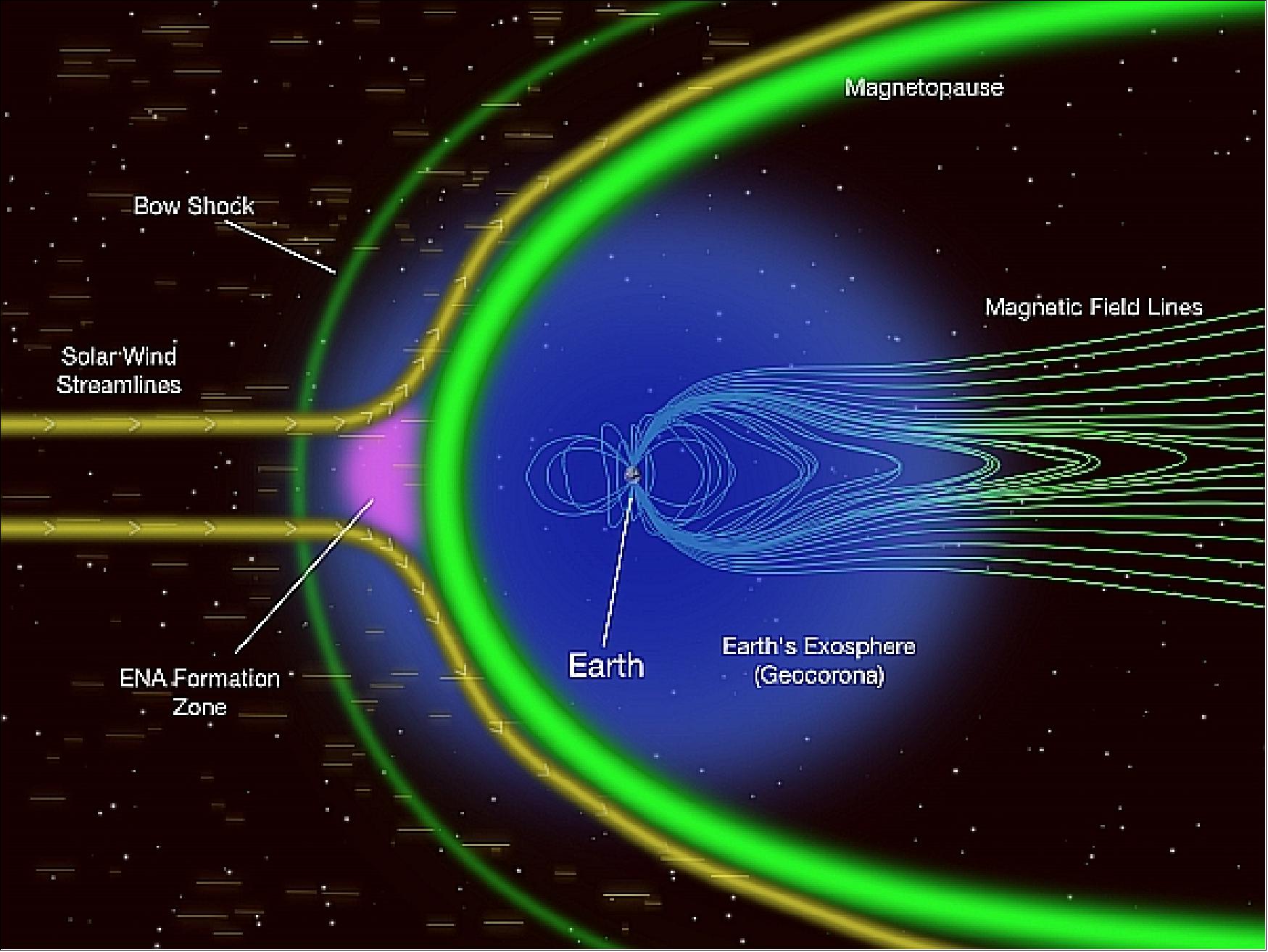
• In January 2010, the IBEX researchers presented an explanation of the giant ribbon. The ribbon is a reflection -- it is where solar wind particles heading out into interstellar space are reflected back into the solar system by a galactic magnetic field. 60) 61)
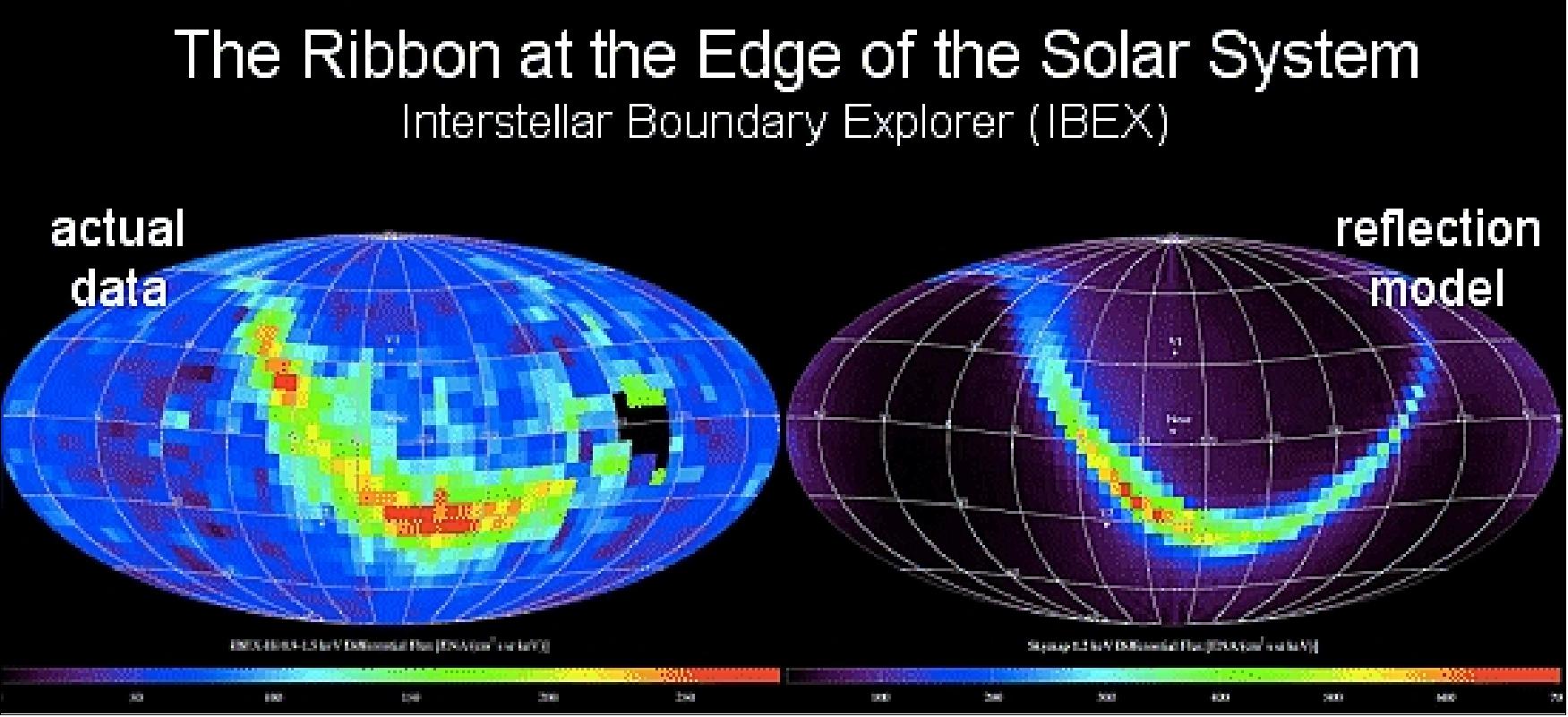
• In Oct. 2009, the IBEX spacecraft had made the first all-sky maps of the heliosphere and the results have taken researchers by surprise. The maps are bisected by a bright, winding ribbon of unknown origin (Figure 34). The sky map was produced with data that two detectors on the spacecraft collected during six months of observations. The detectors measured and counted particles scientists refer to as ENAs (Energetic Neutral Atoms). 62) 63) 64)
Although the ribbon looks bright in the IBEX map, it does not glow in any conventional sense. The ribbon is not a source of light, but rather a source of particles--energetic neutral atoms or ENAs. IBEX's sensors can detect these particles, which are produced in the outer heliosphere where the solar wind begins to slow down and mix with interstellar matter from outside the solar system.
The IBEX sky maps also put observations from NASA's Voyager spacecraft into context. The twin Voyager spacecraft, launched in 1977, traveled to the outer solar system to explore Jupiter, Saturn, Uranus and Neptune. In 2007, Voyager 2 (V2) followed Voyager 1 (V1) into the interstellar boundary. Both spacecraft are now in the midst of this region where the energetic neutral atoms originate. However, the IBEX results show a ribbon of bright emissions undetected by the two Voyagers.
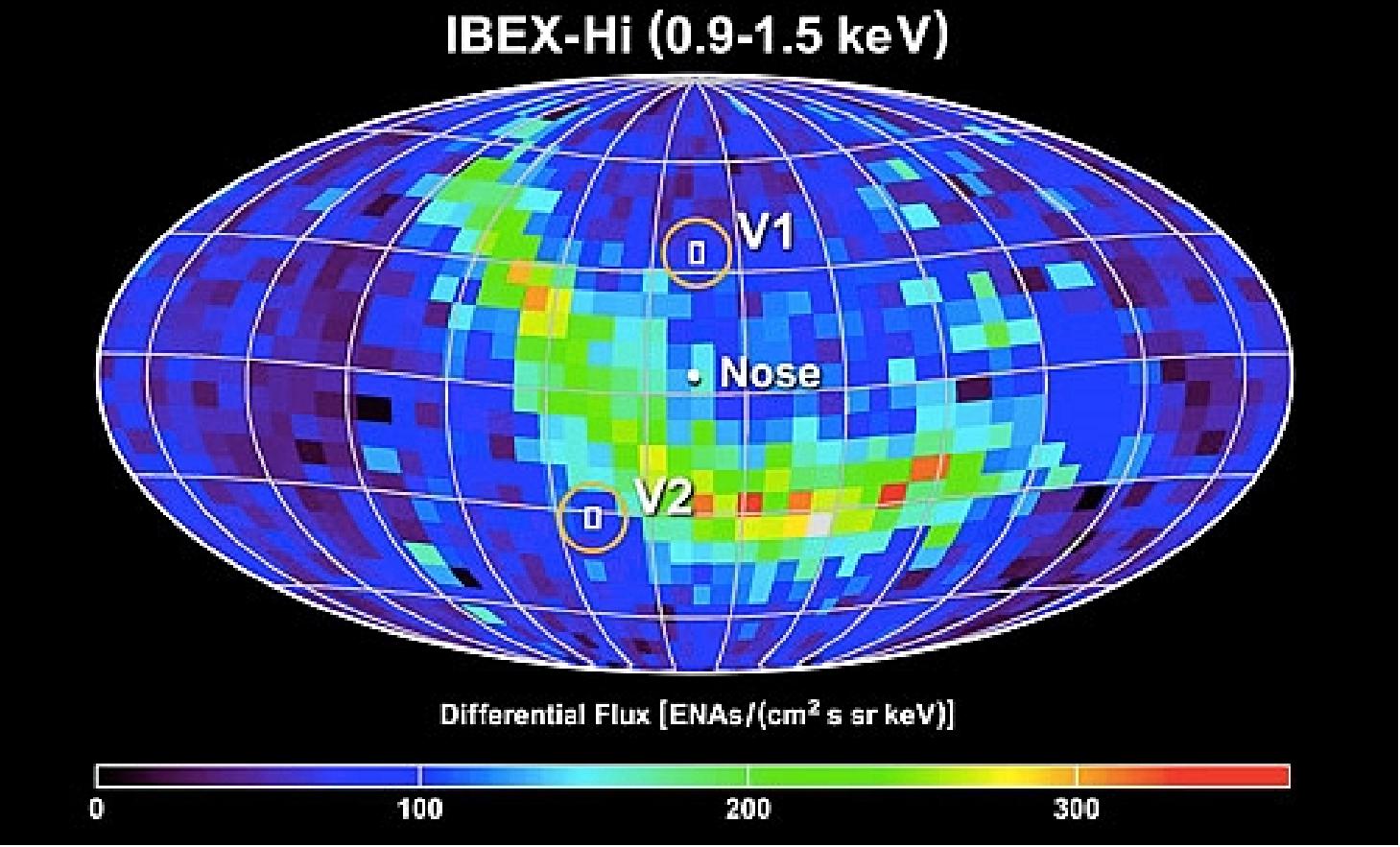
• In June 2009, the IBEX team reported that the IBEX-Hi instrument has made the first observations of very fast hydrogen atoms coming from the moon, following decades of speculation and searching for their existence. The IBEX team estimates that only about 10% of the solar wind ions reflect off the sunward side of the moon as neutral atoms, while the remaining 90% are embedded in the lunar surface. The characteristics of the lunar surface, such as dust, craters and rocks, play a role in determining the percentage of particles that become embedded and the percentage of neutral particles, as well as their direction of travel, that scatter. 65)
• Following two months of commissioning, during which the spacecraft and sensors were tuned for optimum mission performance, the IBEX spacecraft began gathering data in early January 2009 to build the first maps of the edge of the heliosphere, the region of space influenced by the sun. 66)
• On Nov. 12, 2008, the IBEX spacecraft concluded its orbit-raising phase and is beginning instrument commissioning in preparation to start science observations. 67)
Sensor Complement (IBEX-Lo, IBEX-Hi)
The IBEX payload consists of two ENA sensors and a CEU (Combined Electronics Unit). The CEU serves as the single electrical interface between the payload and the SCB. This system architecture was chosen early in the project primarily to minimize overall system mass as well as to simplify the interface between the payload and spacecraft. The CEU is comprised of 2 circuit boards,the digital board and the HVPS (High-Voltage Power Supply) board) and the mechanical chassis (Ref.5).
The digital board accepts, parses and routes commands from the spacecraft to the two sensors and serves as the SSR (Solid State Recorder) where spacecraft and science data is stored and played back for downlink. The digital board creates and distributes custom low voltage for the sensors and gathers housekeeping telemetry from the sensors and the high-voltage board in the CEU. The digital board is responsible for sweeping high-voltage supplies and gathering, binning, processing and storing all raw science data. The multilayer digital board is based on an 8051 core in an Actel FPGA. It includes 2 Gbit of SSR memory for science and SCB back-orbit telemetry. Solid state relays are included for low-voltage distribution. Figure 22 shows a block diagram of the CEU digital board.

The CEU HVPS board provides 16 high-voltage outputs ranging in voltage from 300 V to 11 kV. The board includes standalone independent power supplies for each of the two sensor positive collimators and two independent bulk supplies for the remainder of the high voltages. The supplies use a resonant flyback topology running at approximately 100 kHz. High-voltage pigtail cables are connected directly to and strain-relieved to the HVPS. No HV connectors are used anywhere on the payload. Custom lug connections are used at the sensor end of the high-voltage cables. The CEU includes a “V/16” mode that limits the output of the high-voltage supplies, when the payload safing plug is installed, to a level safe for turn on at ambient conditions. Figure 24 shows a block diagram of the HVPS board.

ENA Sensors
Two narrow angle image sensors (IBEX-Hi and IBEX-Lo) are positioned perpendicular to the spin axis (Figure 12). The objective of these special imagers is to detect energetic neutral atoms (instead of photons of light) to create maps from the solar system’s outer edge, enabling scientists to map the boundary between our Solar System and interstellar space.
The IBEX payload is very simple and comprises only three components: two very large, high sensitivity sensors and a Combined Electronics Unit (CEU). The sensors measure ENAs from ~10 eV to 2 keV (IBEX-Lo) and from ~300 eV to 6 keV (IBEX-Hi). 68) 69) 70)
• The CEU, developed at SwRI, contains all but one of the high voltage power supplies (the last is integral to IBEX-Lo), support electronics for both sensors, and the digital data processing unit for the entire payload. The CEU also includes data storage for the entire IBEX spacecraft.
• IBEX-Lo has an energy range of 0.01-2 keV. The science team consists of the following institutions: LMATC (Lockheed Martin Advanced Technology Center, Lead), UNH (University of New Hampshire), NASA/GSFC, JHU/APL, UBern (University of Bern, Switzerland).
• IBEX-Hi has an energy range of 0.3-6 keV. The science team consists of: LANL (Los Alamos National Laboratory, Lead), UNH, and SwRI.
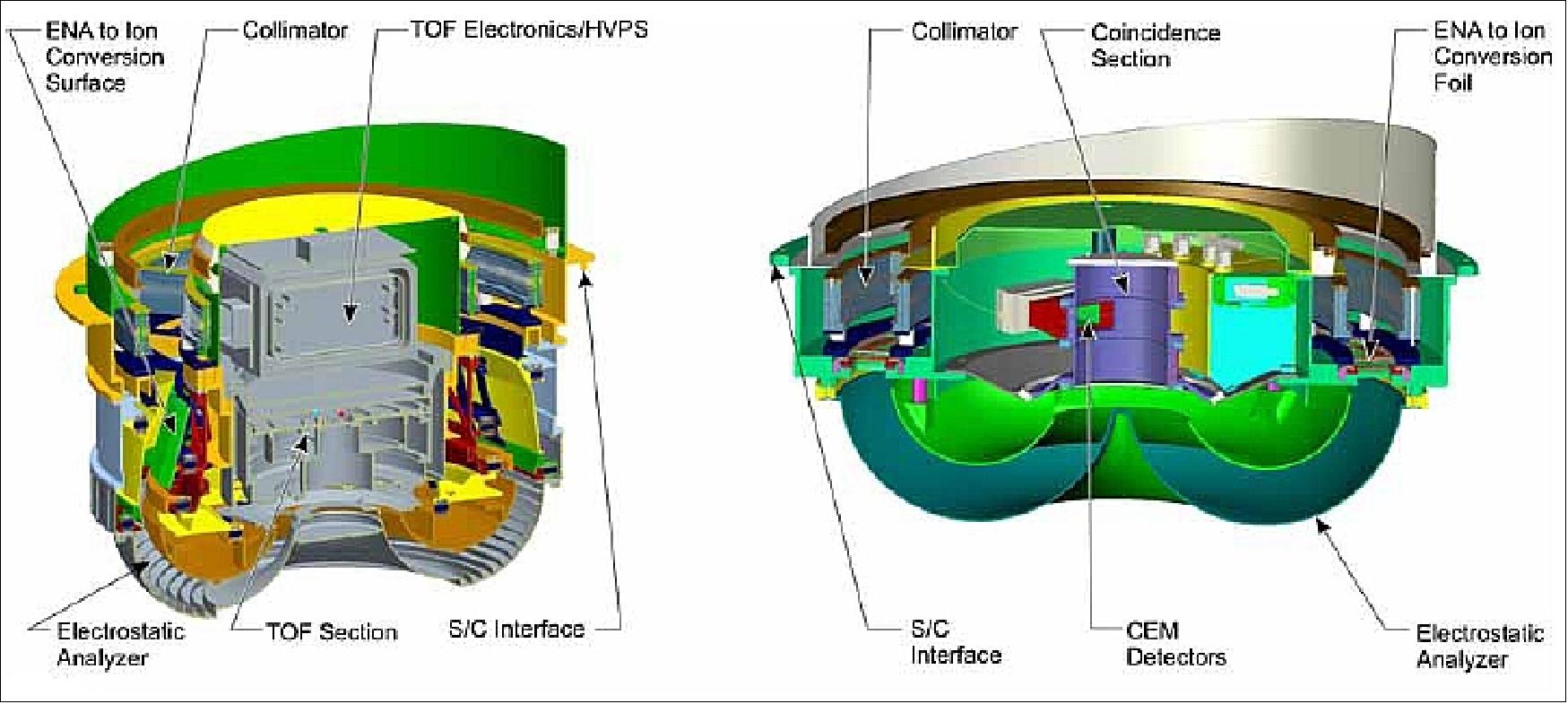
Figure 38 shows the block diagram of the science payload. The CEU provides power and data handling for the sensors and is the payload interface to the SCB (Spacecraft Bus). The CEU provides LV to both sensors, 8 HV lines to IBEX-Hi and 6 to IBEX-Lo. The sensors take science measurements and provide that data to the CEU. The CEU stores that data along with S/C telemetry until the once per orbit downlink time.
CEU (Combined Electronics Unit) has a size of 32 cm x 16.5 cm x 9.5 cm. The primary functions of CEU are:
• Accept +5V, ±14V, and ±15 V from SCB
• Distribute LV (Low Voltage) power to both sensors
• Provide 8 HV (High Voltage) outputs to IBEX-Hi
• Provide 7 HV outputs to IBEX-Lo
• Store all telemetry (science, housekeeping, and S/C).
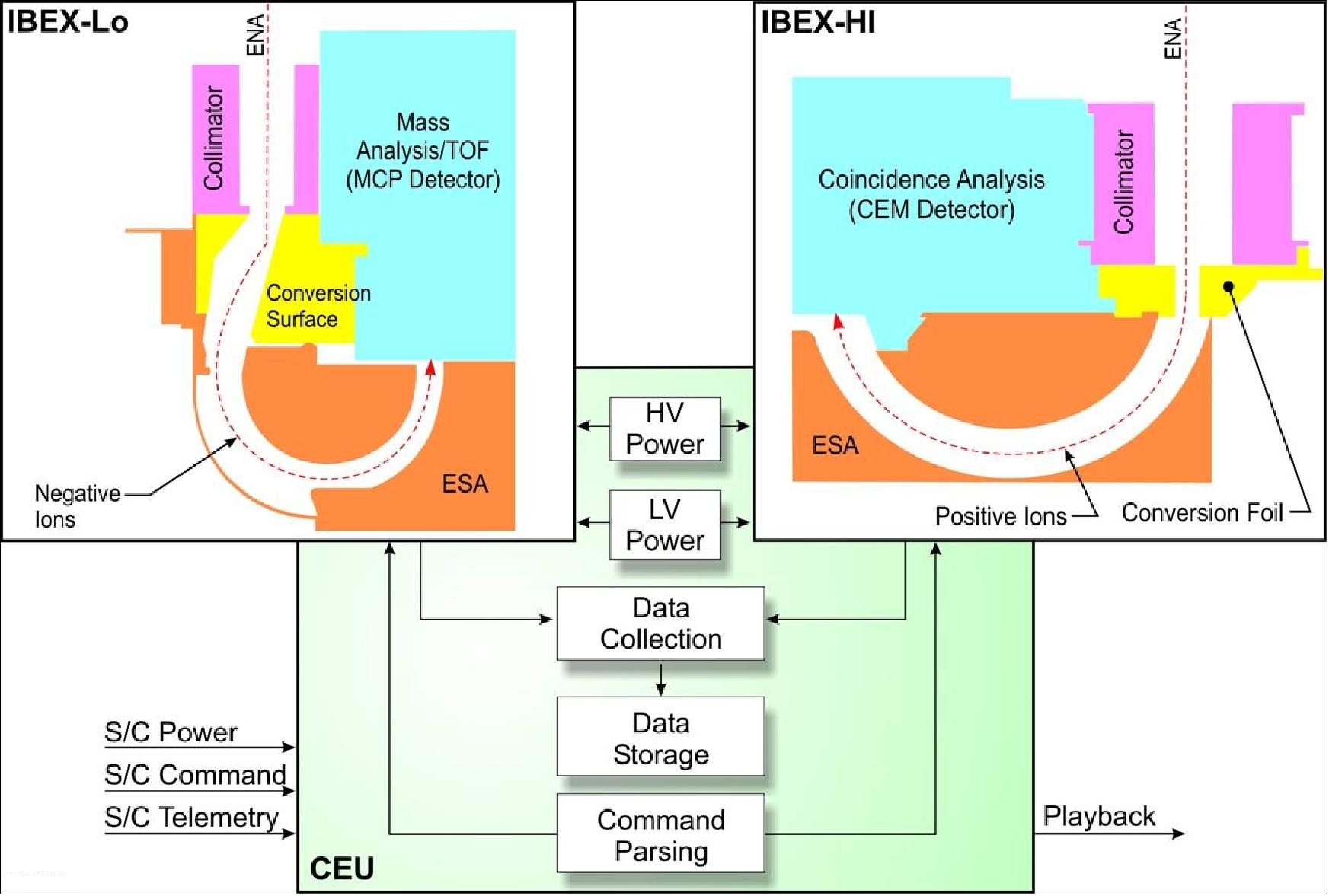

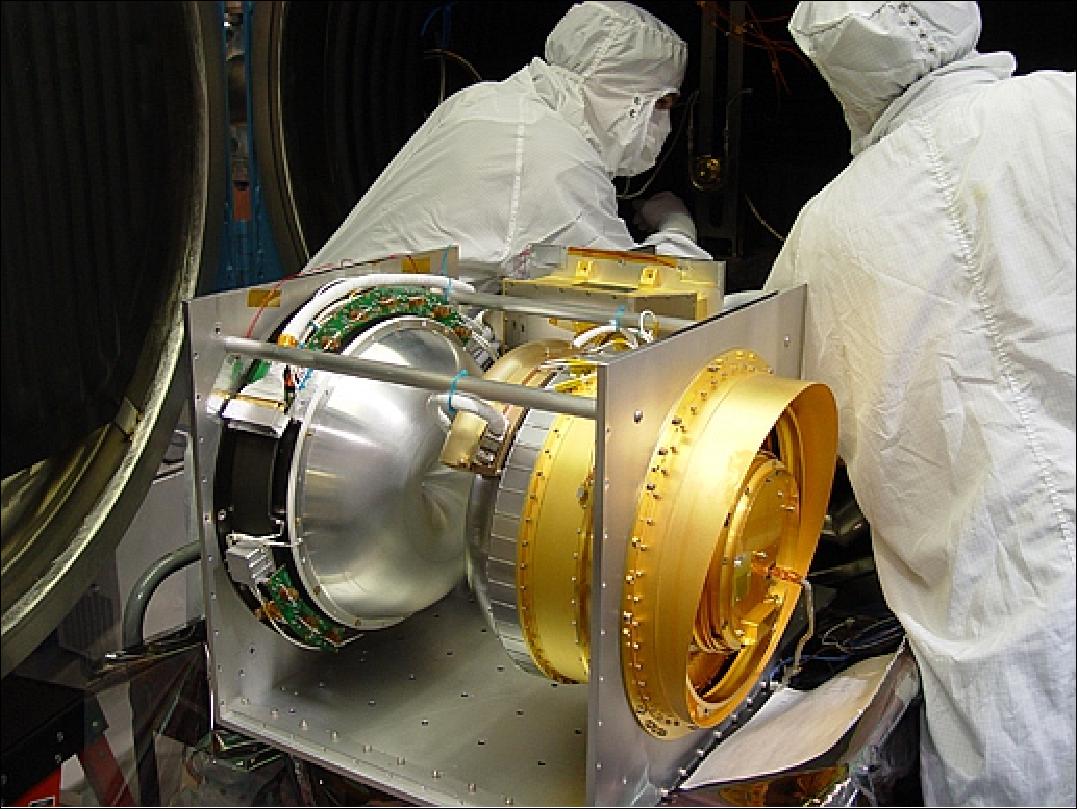
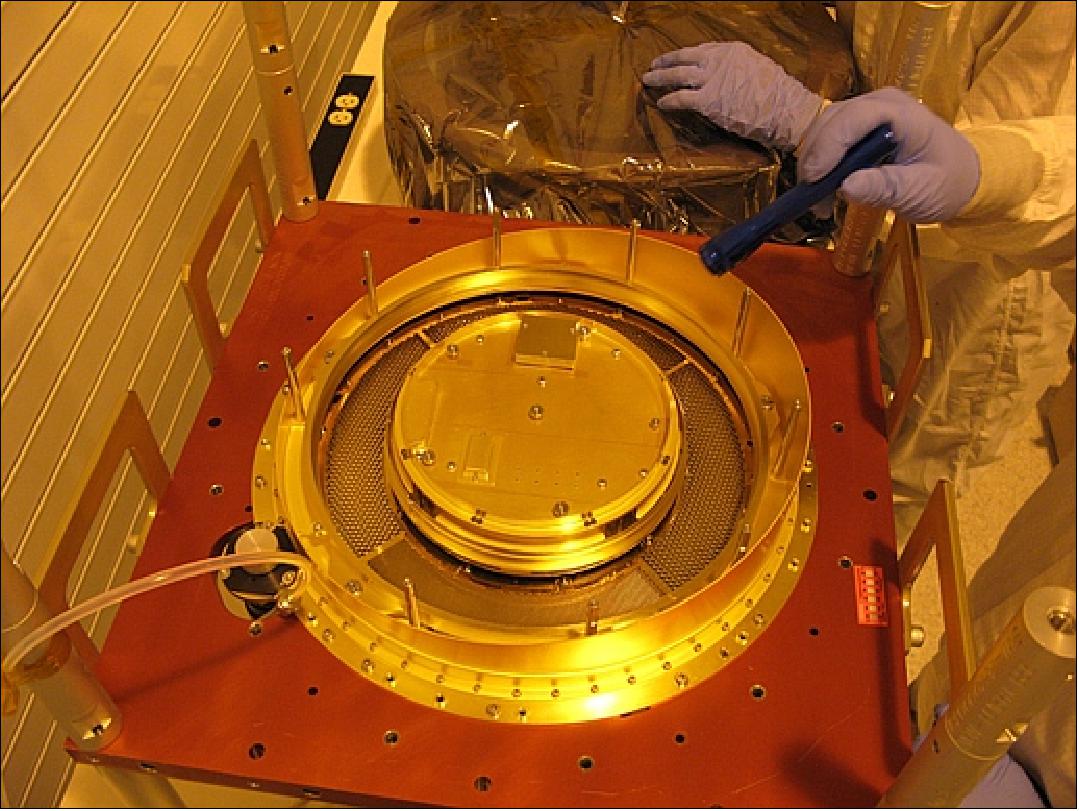

The principle of operation of the two sensors is the same. ENAs (Energetic Neutral Atoms) enter the sensors through collimators that suppress the external electrons below ~600 eV and the external ions below 10 keV. The collimators also set the ENA FOVs and are optimized for measurements of heliospheric ENAs from the inner heliosheath with 7° x 7° FWHM resolution. In addition, a fourth of the aperture area for IBEX-Lo has four times the angular resolution (3.5º x 3.5º FWHM), which is included to precisely measure the cold interstellar neutral oxygen drifting into the heliosphere (Ref. 68).
Just as charge exchange produces ENAs in the inner heliosheath, the two IBEX sensors use charge exchange to convert these ENAs back into ions so that they can be analyzed and detected. In the case of IBEX-Lo, this conversion produces negative ions during reflection from an ultra-smooth diamond-like carbon (DLC) surface. For IBEX-Hi charge exchange to produce positive ions occurs during transmission of the ENAs through ultra-thin (~10 nm) carbon foils. Following their respective conversion subsystems, both sensors have electrostatic analyzers to select energy per charge passbands and triple coincidence detector sections; IBEX-Lo also includes time-of-flight analysis of the detected particles.
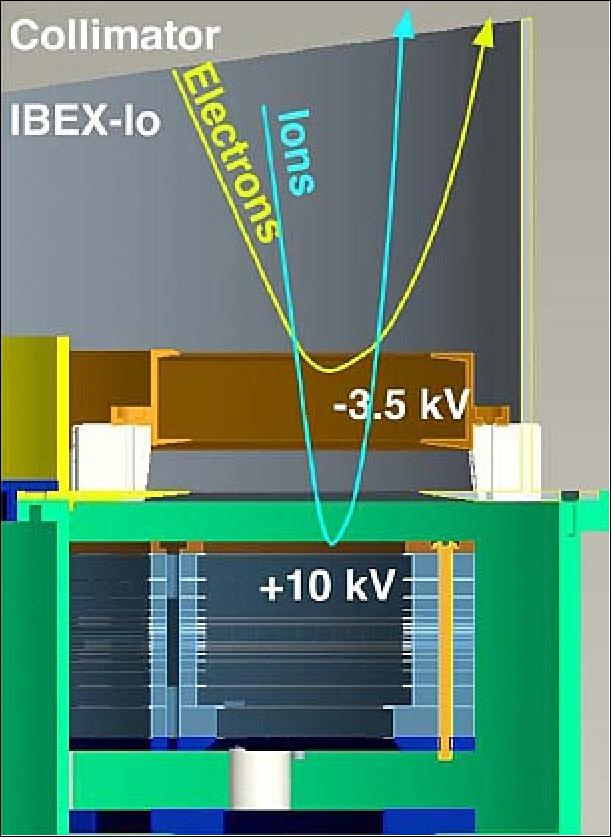
Legend to Figure 43: Electrons below ~600 eV and ions below 10 keV/q are reflected and cannot enter the IBEX sensors. The integral sun shade ensures no solar illumination while the collimators set the angular FOVs for the observations.
Since IBEX is a sun-pointed spinner, it naturally views all directions perpendicular to the sun-spacecraft line each and every spin. Such observations fill in the two crescents drawn in the all sky image (upper left inset of Figure 44). In addition, IBEX is being repointed once each spacecraft orbit so that it maintains its sun-pointed orientation, as the Earth orbits the sun. This repointing rotates the plane of ENA observations, effectively filling in contiguous crescents in the sky. Each six months the rotation of the spin axis goes through 180º, producing a nearly full-sky map. These revolutionary, energy-resolved ENA images and per pixel energy spectra will disclose the global heliospheric interaction for the first time (Ref. 68).
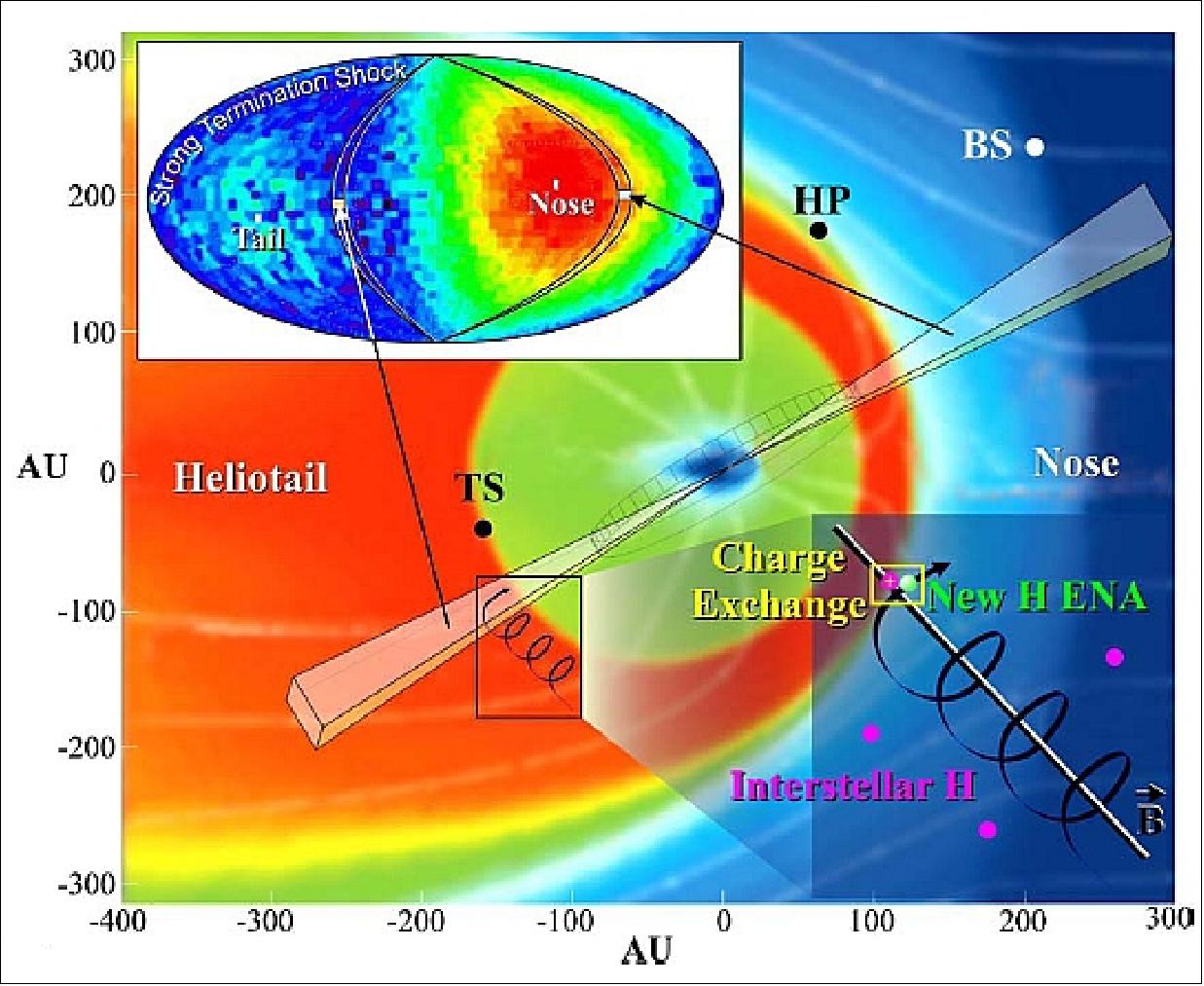
Legend to Figure 44: The lower right inset shows a schematic diagram of charge exchange while the upper left inset shows an all sky map and how individual pixels from the main image map onto the sky map.
Ground Segment
IBEX ground systems consist of the MOC (Mission Operations Center) at Orbital's Dulles, VA facility, Universal space Network (USN) ground stations and the ISOC (IBEX Science Operations Center) located at SwRI in San Antonio, TX. In addition, the TDRSS network is used during early launch operations to monitor the SRM burn in real time. The ISOC is responsible for evaluating mission data, monitoring payload performance, and delivering IBEX data products. It plans the operations and generates the detailed science and engineering schedule. ISOC processes all mission science and calibration data, distributes science data to the IBEX team, makes data continuously available to the public through a web interface to an Oracle database and prepares and releases the IBEX science archive to the NSSDC (National Space Science Data Center).
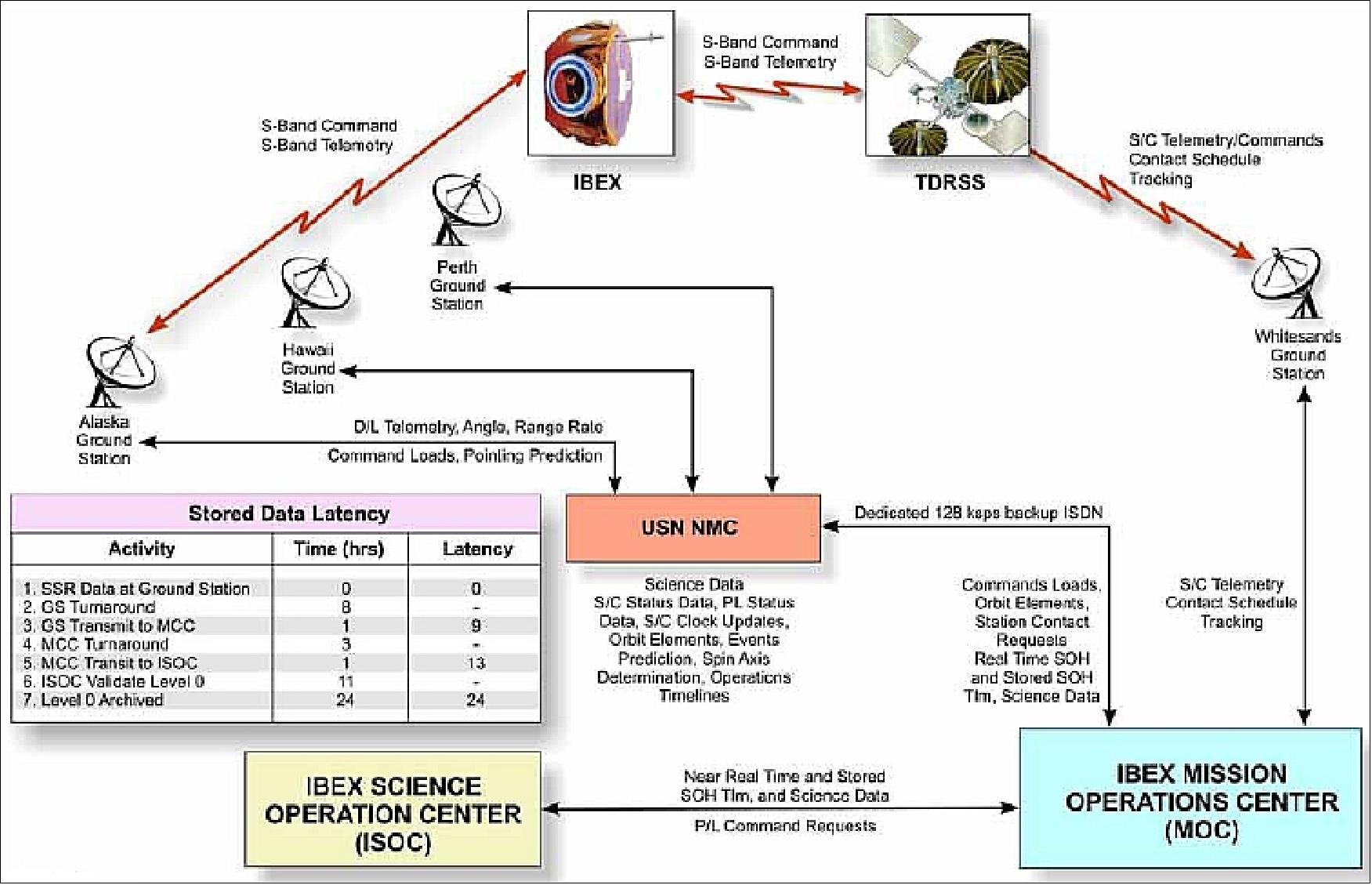
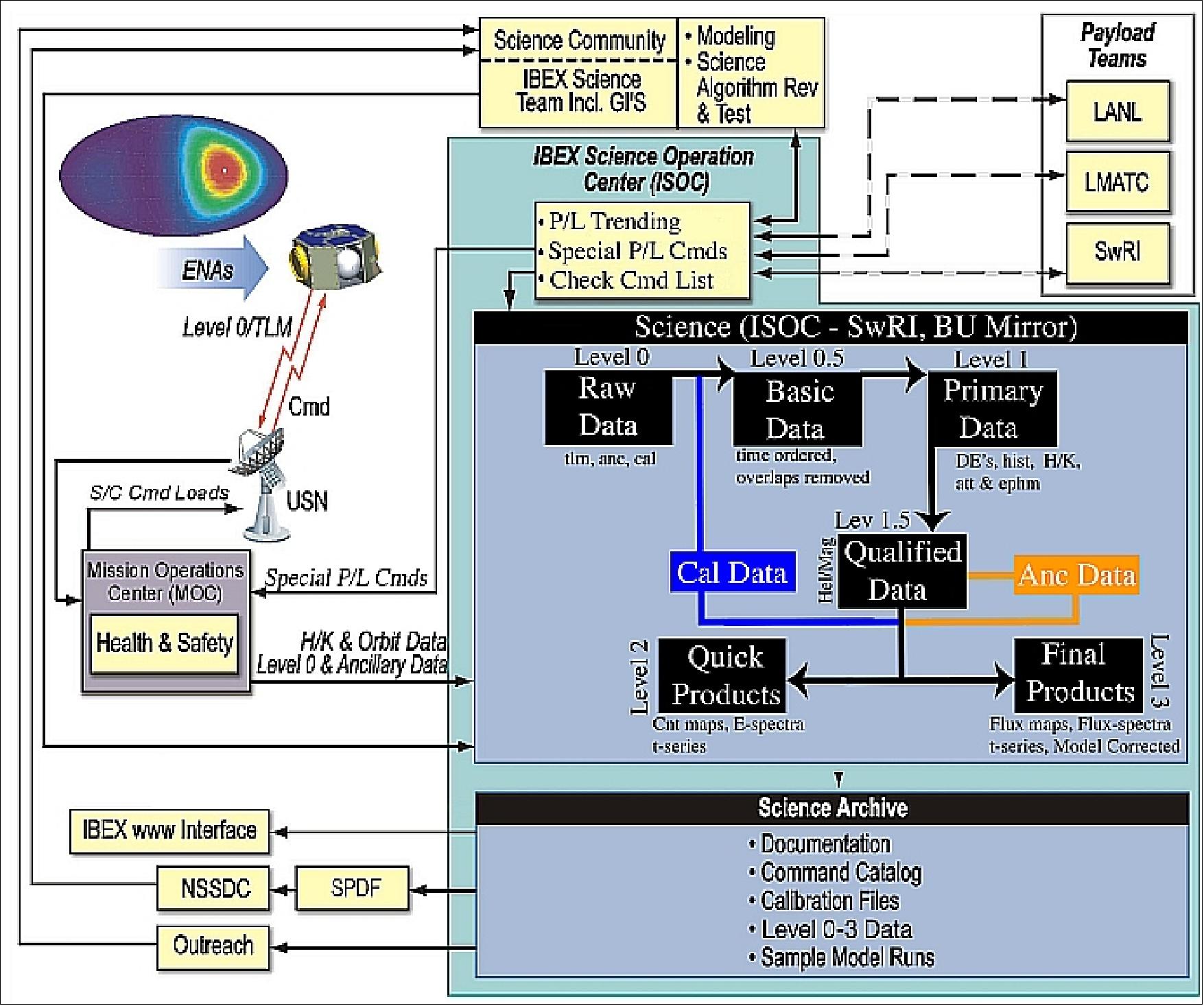
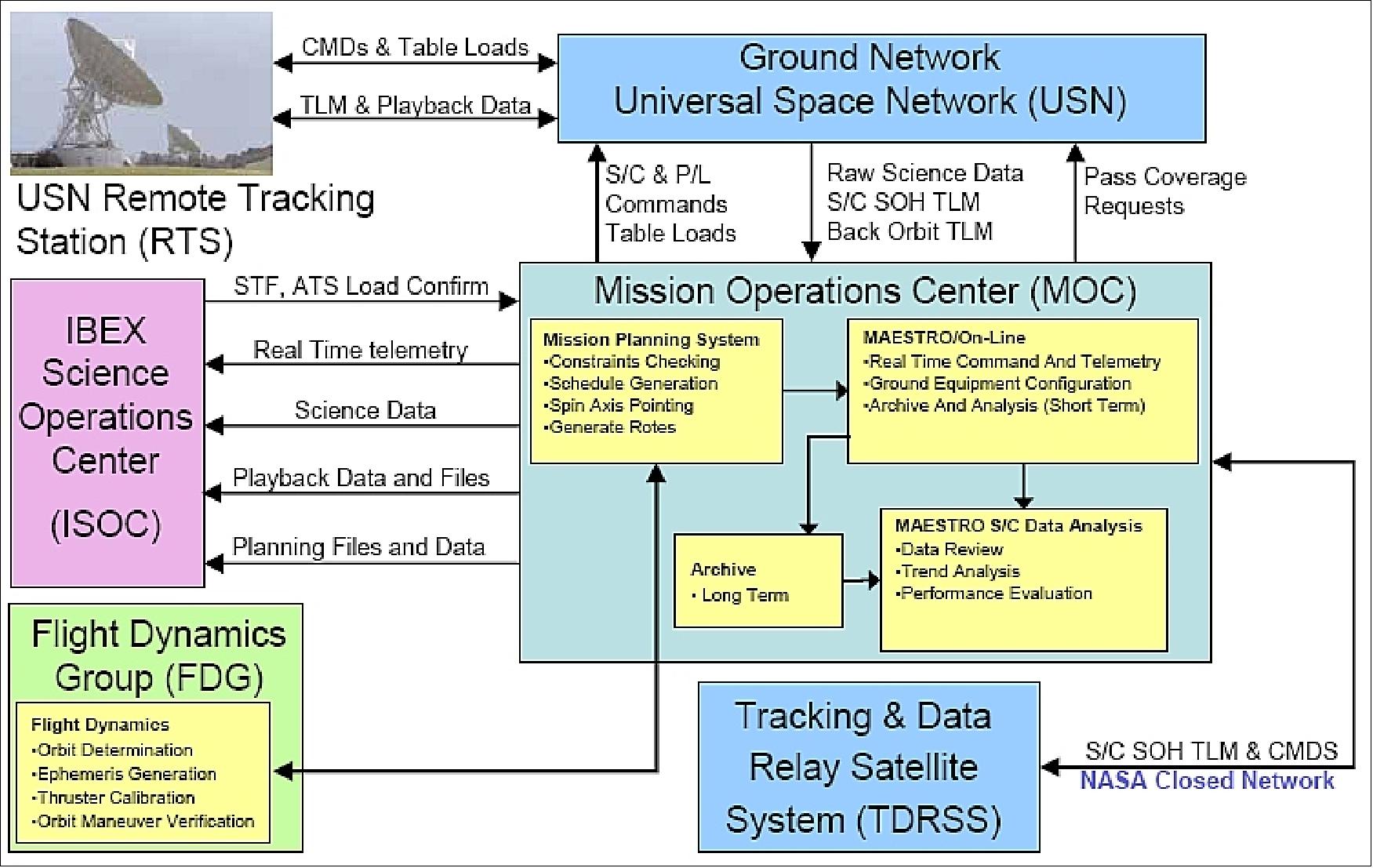
References
1) Andy Lewin, Victoria Davis, “Micro-GEOs: An Emerging Small Satellite Bus Class,” Proceedings of the 22nd Annual AIAA/USU Conference on Small Satellites, Logan, UT, USA, Aug. 11-14, 2008, SSC08-IV-4
2) “Interstellar Boundary Explorer (IBEX) mission enters implementation phase,” May 26, 2006, URL: http://www.swri.org/9what/releases/2006/IBEX.htm
3) http://www.orbital.com/NewsInfo/Publications/IBEX_fact.pdf
4) “NASA’s Interstellar Boundary Explorer Mission,” URL: http://www.nasa.gov/pdf/280255main_IBEXFactSheetOct08.pdf
5) J. Scherrer, J. Carrico, J. Crock, W. Cross, A. DeLosSantos, A. Dunn, G. Dunn, M. Epperly, B. Fields, E. Fowler, T. Gaio, J. Gerhardus,W. Grossman, J. Hanley, B. Hautamaki, D. Hawes, W. Holemans, S. Kinaman, S. Kirn, C. Loeffler, D. J. McComas, A. Osovets, T. Perry, M. Peterson, M. Phillips, S. Pope, G. Rahal, M. Tapley, R. Tyler, B. Ungar, E. Walter, S. Wesley, T. Wiegand, “The IBEX Flight Segment,” Space Science Review, Vol. 146, 2009, pp. 35-73
6) http://ibex.swri.edu/mission/launch.shtml
7) http://www.nasa.gov/mission_pages/ibex/index.html
8) Dave McComas, “Mission Update – IBEX Orbit–Raising Maneuver,” SwRI, Nov. 14, 2011, URL: http://www.ibex.swri.edu/archive/2011.11.14.shtml
9) Joseph G. Peterson, Nathan Schwadron, Celle Reno, John P. Carrico Jr., Ken Fairchild, Roland Vanderspek, Robert DeMajistre, “Science Operations Support for the Orbit Change on the Interstellar Boundary Explorer (IBEX) Mission,” Proceedings of the 2012 IEEE Aerospace Conference, Big Sky, Montana, USA, March 3-10, 2012
10) Sarah Frazier, ”Uncovering Our Solar System’s Shape,” NASA Feature, 5 August 2020, URL: https://www.nasa.gov/feature/goddard/2020/uncovering-our-solar-system-s-shape
11) Merav Opher, Abraham Loeb, James Drake & Gabor Toth, ”A small and round heliosphere suggested by magnetohydrodynamic modelling of pick-up ions,” Nature Astronomy, Volume 4, pp: pages675–683(2020), Published: 16 March 2020, Issue Date: July 2020, https://doi.org/10.1038/s41550-020-1036-0
12) Lina Tran, ”NASA’s IBEX Charts 11 Years of Change at Boundary to Interstellar Space,” NASA Feature, 11 June 2020, URL: https://www.nasa.gov/feature/goddard/2020
/nasa-ibex-charts-11-years-change-at-boundary-interstellar-space-heliosphere-sun
13) D. J. McComas, M. Bzowski, M. A. Dayeh, R. DeMajistre, H. O. Funsten, P. H. Janzen, I. Kowalska-Leszczyńska, M. A. Kubiak, N. A. Schwadron, J. M. Sokół, J. R. Szalay, M. Tokumaru, and E. J. Zirnstein,” Solar Cycle of Imaging the Global Heliosphere: Interstellar Boundary Explorer (IBEX) Observations from 2009–2019,” The Astrophysical Journal Supplement Series, Volume 248, Number 2, Published: 10 June 2020, https://doi.org/10.3847/1538-4365/ab8dc2
14) Miles Hatfield, ”As Solar Wind Blows, Our Heliosphere Balloons,” NASA, 6 June 2018, URL: https://www.nasa.gov/feature/goddard/2018/as-solar-wind-blows-our-heliosphere-balloons
15) D. J. McComas, M. A. Dayeh, H. O. Funsten, J. Heerikhuisen, P. H. Janzen, D. B. Reisenfeld, N. A. Schwadron, J. R. Szalay, E. J. Zirnstein,” Heliosphere Responds to a Large Solar Wind Intensification: Decisive Observations from IBEX,” The Astrophysical Journal Letters, Volume 856, Number 1, Published 23 March 2018, https://doi.org/10.3847/2041-8213/aab611
16) E. J. Zirnstein, J. Heerikhuisen, D. J. McComas, N. V. Pogorelov, D. B. Reisenfeld, J. R. Szalay, ”Simulation of the Solar Wind Dynamic Pressure Increase in 2014 and Its Effect on Energetic Neutral Atom Fluxes from the Heliosphere,” The Astrophysical Journal. Volume 859, Number 2, Published on 30 May 2018, https://doi.org/10.3847/1538-4357/aac016
17) D. J. McComas, E. J. Zirnstein, M. Bzowski, M. A. Dayeh, H. O. Funsten, S. A. Fuselier, P. H. Janzen, M. A. Kubiak, H. Kucharek, E. Möbius, D. B. Reisenfeld, N. A. Schwadron, J. M. Sokół, J. R. Szalay, M. Tokumaru, ”Seven Years of Imaging the Global Heliosphere with IBEX,” The Astrophysical Journal Supplement Series, Volume 229, Number 2, Published 2017 April 17, DOI: 10.3847/1538-4365/aa66d8, URL: https://arxiv.org/ftp/arxiv/papers/1704/1704.06316.pdf
18) E. J. Zirnstein, J. Heerikhuisen, H. O. Funsten, G. Livadiotis, D. J. McComas, N. V. Pogorelov, ” Astronomical Journal Letters, Volume 818, Number 1, Feb. 8, 2016, URL of abstract: http://iopscience.iop.org/article/10.3847/2041-8205/818/1/L18/pdf
19) Sarah Frazier, ”NASA’s IBEX Observations Pin Down Interstellar Magnetic Field,” NASA, Feb. 26, 2016, URL: http://www.nasa.gov/feature/goddard/2016
/nasa-s-ibex-observations-pin-down-interstellar-magnetic-field
20) ”NASA’s IBEX spacecraft sets “gold standard” for understanding the galactic material surrounding our solar system,” SwRI, Oct. 20, 2015, URL: http://www.swri.org/9what
/releases/2015/nasa-ibex-spacecraft-sets-gold-standard.htm#.Vihtnysib3U
21) The Astrophysical Journal Supplement Series, Volume 220, Number 2 , October 20, 2015, URL: http://iopscience.iop.org/0067-0049/220/2
22) D. J. McComas, M. Bzowski, S. A. Fuselier, P. C. Frisch, A. Galli, V. V. Izmodenov, O. A. Katushkina, M. A. Kubiak, M. A. Lee, T. W. Leonard, E. Möbius, J. Park, N. A. Schwadron1, J. M. Sokół, P. Swaczyna, B. E. Wood, P. Wurz, ”Local interstellar medium:six years of direct sampling by IBEX,” The Astrophysical Journal Supplement Series, Volume 220, Number 2 , October 20, 2015, URL: http://iopscience.iop.org/article/10.1088/0067-0049/220/2/22/pdf
23) Martin A. Lee, Eberhard Möbius, Trevor W. Leonard, ”The analytical structure of the primary interstellar helium distribution function in the heliosphere,” The Astrophysical Journal Supplement Series, 220:23 (15pp), October 20, 2015, URL: http://iopscience.iop.org/article/10.1088/0067-0049/220/2/23/pdf
24) “NASA Response to the 2015 Senior Review for Heliophysics Operating Missions,” NASA, July 10, 2015, URL: http://science.nasa.gov/media/medialibrary
/2015/07/10/NASAResponse2015SeniorReview_FINAL.pdf
25) “The 2015 Senior Review of the Heliophysics Operating Missions, NASA, June 11, 2015, URL: http://science.nasa.gov/media/medialibrary/2015/07/10/HeliophysicsSeniorReview2015_FINAL.pdf
26) “NASA’s IBEX and Voyager spacecraft drive advances in outer heliosphere research,” SwRI, Aug. 4, 2014, URL: http://www.swri.org/9what/releases/2014/heliosphere.htm#.U-NC5aO4T5o
27) D. J. McComas, F. Allegrini, M. Bzowski, M. A. Dayeh, R. DeMajistre, H. O. Funsten, S. A. Fuselier, M. Gruntman, P. H. Janzen, M. A. Kubiak, H. Kucharek, E. Möbius, D. B. Reisenfeld, N. A. Schwadron, J. M. Sokó, M. Tokumaru, “IBEX: The First Five Years (2009-2013),” The Astrophysical Journal Supplement Series, Volume 213, Number 2,August 2014, ApJS 213 20 doi:10.1088/0067-0049/213/2/20, URL: http://iopscience.iop.org/article/10.1088/0067-0049/213/2/20/pdf
28) “Scientists reveal cosmic roadmap to galactic magnetic field,” University of New Hampshire, Feb. 13, 2014, URL: http://www.unh.edu/news/releases/2014/02/ds13roadmap.cfm
29) Karen C. Fox, “NASA's IBEX Helps Paint Picture of the Magnetic System Beyond the Solar Wind,” NASA, Feb. 13, 2014, URL: http://www.nasa.gov/content/goddard
/ibex-paints-picture-of-magnetic-system-beyond-solar-wind/#.UwGhPs7nNeM
31) “A Major Step Forward in Explaining the Ribbon in Space Discovered by NASA's IBEX Mission,” NASA, Feb. 5, 2014, URL: http://www.nasa.gov/mission_pages/ibex/news/ribbon-explained.html#.UwGfIs7nNeM
32) Karen C. Fox, “Five Years of Great Discoveries for NASA's IBEX,” NASA/GSFC, Oct. 30, 2013, URL: http://www.nasa.gov/content/goddard/five-years-of-great-discoveries-for-nasas-ibex/#.UuE8pPswdR4
33) Maria Martinez, “IBEX spacecraft measures changes in the direction of interstellar winds buffeting our solar system,” SwRI, Sept. 5, 2013, URL: http://www.swri.org
/9what/releases/2013/ibex-wind.htm#.UuEv2fswdR4
34) Karen C. Fox, “Eleven Spacecraft Show Interstellar Wind Changed Direction Over 40 Years ,” NASA/GSFC, Sept. 5, 2013, URL: http://www.nasa.gov/content/goddard/interstellar-wind-changed-direction-over-40-years/#.UuErhvswdR4
35) P. C. Frisch,M. Bzowski, G. Livadiotis, D. J. McComas, E. Moebius, H.-R. Mueller, W. R. Pryor, N. A. Schwadron, J. M. Sokół, J. V. Vallerga, J. M. Ajello, “Decades-Long Changes of the Interstellar Wind Through Our Solar System,” Science, September 6, 2013, Vol. 341, No. 6150, pp: 1080-1082 ,DOI: 10.1126/science.1239925
36) Steve Cole, “NASA Satellite Provides First View of the Solar System's Tail,” NASA News Release 12-211, July 10, 2013, URL: http://www.nasa.gov/press/2013/july
/nasa-satellite-provides-first-view-of-the-solar-systems-tail/#.Ud461axi0gg
37) “IBEX spacecraft images the heliotail — the last region of solar system's boundary to be seen — revealing an unexpected structure,” SwRI News, July 10, 2013, URL: http://www.swri.org/9what/releases/2013/ibex-heliotail.htm#.Ud4-r6xi0gg
38) D. J. McComas, M. A. Dayeh, H. O. Funsten, G. Livadiotis, N. A. Schwadron, “The heliotail revealed by the Interstellar Boundary Explorer," The Astrophysical Journal, Vol. 771, No 2, p. 77, June 18, 2013, doi:10.1088/0004-637X/771/2/77
39) Karen C. Fox, “NASA’s IBEX Provides First View Of the Solar System’s Tail,” NASA, July 10, 2013, URL: http://www.nasa.gov/content/nasa-s-ibex-provides-first-view-of-the-solar-system-s-tail/#.Ud5R9axi0gg
40) Nancy Atkinson, “Our Solar System Has a Tail Shaped Like a Four-Leaf Clover: New Findings from IBEX,” Universe Today, July 10, 2013, URL: http://www.universetoday.com/103412
/our-solar-system-has-a-tail-shaped-like-a-four-leaf-clover-new-findings-from-ibex/
41) “New 'retention model' explains enigmatic ribbon at edge of solar system,” SwRI, Feb. 5, 2013, URL: http://www.swri.org/9what/releases/2013/ribbon.htm
42) Nathan A. Schwadron, Dave J. McComas, “Spatial Retention of Ions Producing the IBEX Ribbon,” The Astrophysical Journal, Vol. 764, No 1, Feb. 4, 2013, doi:10.1088/0004-637X/764/1/92
43) “Enigmatic 'Ribbon' of Energy Discovered by NASA Satellite Explained,” Science Daily, Feb. 5, 2013, URL: http://www.sciencedaily.com/releases/2013/02/130205131750.htm
44) Dave McComas, “IBEX,” Feb. 5, 2013, URL: http://ibex.swri.edu/
45) “New IBEX data show heliosphere's long-theorized bow shock does not exist,” SwRI, May 10, 2012, URL: http://www.swri.org/9what/releases/2012/bowshock.htm
46) Dave McComas, “No "Bow Shock" For Our Heliosphere,” May 10, 2012, URL: http://www.ibex.swri.edu/archive/2012.05.10.shtml
47) Dwayne Brown, Susan Hendrix, “NASA Spacecraft Reveals New Observations of Interstellar Matter,” NASA, Jan. 31, 2012, URL: http://www.nasa.gov/home
/hqnews/2012/jan/HQ_12-036_New_IBEX_Findings.html
48) Tony Phillips, “Alien Matter in the Solar System: A Galictic Mismatch,” NASA, Feb. 10, 2012, URL: http://science.nasa.gov/science-news/science-at-nasa/2012/10feb_alienmatter/
49) N. A. Schwadron, F. Allegrini, M. Bzowski, E. R. Christian, G. B. Crew, M. Dayeh, R. DeMajistre, P. Frisch, H. O. Funsten, S. A. Fuselier, K. Goodrich, M. Gruntman, P. Janzen, H. Kucharek, G. Livadiotis, D. J. McComas, E. Moebius, C. Prested, D. Reisenfeld, M. Reno, E. Roelof, J. Siegel, R. Vanderspek, “Separation of the Interstellar Boundary Explorer Ribbon from Globally Distributed Energetic Neutral Atom Flux,” The Astrophysical Journal, Vol. 731, No 1, April 12, 2011, doi: 10.1088/0004-637X/731/1/56,URL: http://iopscience.iop.org/0004-637X/731/1/56/pdf/0004-637X_731_1_56.pdf
50) “IBEX Scientists Isolate Mysterious "Ribbon" of Energy and Particles that Wraps Around Solar System Boundary,” University of New Hampshire, March 30, 2011, URL: http://www.unh.edu/news/cj_nr/2011/mar/ds30ribbon.cfm
51) Dave McComas, “Mission Update – End of Prime Mission Review,” March 11, 2011, SwRI, URL: http://www.ibex.swri.edu/archive/2011.03.11.shtml
52) D. J. McComas, M. Bzowski, P. Frisch, G. B. Crew, M. A. Dayeh, R. DeMajistre, H. O. Funsten, S. A. Fuselier, M. Gruntman, P. Janzen, M. A. Kubiak, G. Livadiotis, E. Mobius, D. B. Reisenfeld, N. A. Schwadron, “Evolving outer heliosphere: Large-scale stability and time variations observed by the Interstellar Boundary Explorer," Journal of Geophysical Research, Vol. 115, Sept. 29, 2010, pp. A09113-18, doi:10.1029/2010JA015569
53) “Knot in the ribbon at the edge of the solar system 'unties',” SwRI, Sept. 30, 2010, URL: http://www.eurekalert.org/pub_releases/2010-09/sri-kit093010.php
54) J. Kelly Beatty, “IBEX Finds Surprising Changes at Solar Boundary,” NASA, Sept. 30, 2010, URL: http://www.nasa.gov/mission_pages/ibex/news/solar-boundary.html
55) “NASA To Reveal New Data On Conditions At Edge Of Solar System,” Sept. 29, 2010, URL: http://www.nasa.gov/mission_pages/ibex/telecon_20100929.html
56) Dave McComas, “Ribbon Changes over Time,” Sept. 30, 2010, URL: http://www.ibex.swri.edu/archive/2010.09.30.shtml
57) “Mysterious Ribbon at Edge of Solar System is Changing,” Universe Today, Sept. 30, 2010, URL: http://www.universetoday.com/74712/mysterious-ribbon-at-edge-of-solar-system-is-changing/
58) Science Update - Observing Earth's Magnetosphere,” Aug. 17, 2010, URL: http://www.ibex.swri.edu/archive/2010.08.17.shtml
59) “IBEX Spacecraft Finds Discoveries Close to Home,” Aug. 16, 2010, URL: http://www.nasa.gov/mission_pages/ibex/em-crash.html
60) Tony Phillips, “Giant Ribbon at the Edge of the Solar System: Mystery Solved? ,” NASA, Jan. 15, 2010, URL: http://science.nasa.gov/headlines/y2010/15jan_ibex2.htm?list1291671
61) J. Heerikhuisen, N.V. Pogorelov, G.P. Zank, G.B. Crew, P.C. Frisch, H.O. Funsten, P.H. Janzen, D.J. McComas, D.B. Reisenfeld, N.A. Schwadron, “Pick-Up Ions in the Outer Heliosheath: A Possible Mechanism for the Interstellar Boundary EXplorer Ribbon,” Astrophysical Journal, Vol. 708, Jan. 10, 2010, L126-L130 doi: 10.1088/2041-8205/708/2/L126
62) “Giant Ribbon Discovered at the Edge of the Solar System,” NASA, Oct. 15, 2009, URL: http://science.nasa.gov/headlines/y2009/15oct_ibex.htm?list1291671
63) Dave McComas, “First Science Results from IBEX,” URL: http://www.ibex.swri.edu/archive/2009.10.15.shtml
64) D. J. McComas, F. Allegrini, P. Bochsler, M. Bzowski, E. R. Christian, G. B. Crew, R. DeMajistre, H. Fahr, H. Fichtner, P. C. Frisch, H. O. Funsten, S. A. Fuselier, G. Gloeckler, M. Gruntman, J. Heerikhuisen, V. Izmodenov, P. Janzen, P. Knappenberger, S. Krimigis, H. Kucharek, M. Lee, G. Livadiotis, S. Livi, R. J. MacDowall, D. Mitchell, E. Möbius, T. Moore, N. V. Pogorelov, D. Reisenfeld, E. Roelof, L. Saul, N. A. Schwadron, P. W. Valek, R. Vanderspek, P. Wurz, G. P. Zank, “Global Observations of the Interstellar Interaction from the Interstellar Boundary Explorer (IBEX),” Science, Vol. 326, Nov. 13, 2009
65) “IBEX spacecraft detects fast neutral hydrogen coming from the moon, gives insight to particle "recycling" processes in space,” June 18, 2009, URL: http://www.swri.org/9what/releases/2009/IBEX-Hi.htm
66) “IBEX Building First All-Sky Map Of The Edge Of The Solar System,” Spacedaily, Jan. 14, 2009, URL: http://www.spacedaily.com/reports
/IBEX_Building_First_All_Sky_Map_Of_The_Edge_Of_The_Solar_System_999.html
67) “IBEX spacecraft reaches orbit, begins instrument commissioning,” SwRI, Nov. 12, 2008, URL: http://www.swri.org/9what/releases/2008/IBEXOrbit.htm
68) D. J. McComas, F. Allegrini, L. Bartolone, P. Bochsler, M. Bzowski, M. Collier, H. Fahr, H. Fichtner, P. Frisch, H. Funsten, Steve Fuselier, G. Gloeckler, M. Gruntman, V. Izmodenov, P. Knappenberger, M. Lee, S. Livi, D. Mitchell, E. Möbius, T. Moore, S. Pope, D. Reisenfeld, E. Roelof, H. Runge, J. Scherrer, N. Schwadron, R. Tyler, M. Wieser, M. Witte, P. Wurz, G. Zank, “The Interstellar Boundary Explorer (IBEX): Update at the End of Phase B,” URL: http://ibex.swri.edu/multimedia/files/IGPP.pdf
69) C. Prested, N. Schwadron, J. Passuite, B. Randol, B. Stuart, G. Crew, J. Heerikhuisen, N. Pogorelov, G. Zank, M. Opher, F. Allegrini, D. J. McComas, M. Reno, E. Roelof, S. Fuselier, H. Funsten, E. Moebius, L. Saul, “Implications of solar wind suprathermal tails for IBEX ENA images of the heliosheath,” Journal of Geophysical Research, Vol. 113, 2008, A06102, doi:10.1029/2007JA012758, URL: http://ibex.swri.edu/multimedia/files/SWsupra.pdf
70) H. Funsten, F. Allegrini, P. Bochsler, G. Dunn, S. Ellis, D. Everett, M. Fagan, S. Fuselier, M. Granoff, M. Gruntman, A. Guthrie, J. Hanley, R. Harper, D. Heirtzler, P. Janzen, K. Kihara, B. King, H. Kucharek, M. Manzo, M. Maple, K. Mashburn, D.J. McComas, E. Moebius, J. Nolin, D. Piazza, S. Pope, D.B. Reisenfeld, B. Rodriguez, E.C. Roelof, L. Saul, S. Turco, P. Valek, S. Weidner, P. Wurz, S. Zaffke, “The Interstellar Boundary Explorer High Energy (IBEX-Hi) neutral atom imager,” Space Science Review, Vol. 146, 2009, Issue 1-4, pp. 75-103
The information compiled and edited in this article was provided by Herbert J. Kramer from his documentation of: ”Observation of the Earth and Its Environment: Survey of Missions and Sensors” (Springer Verlag) as well as many other sources after the publication of the 4th edition in 2002. - Comments and corrections to this article are always welcome for further updates (eoportal@symbios.space).
Spacecraft Launch Mission Status Sensor Complement Ground Segment References Back to top